November 29, 2018
Jonathan Miller's La bohème returns to the Coliseum
Is there a degree of overkill, especially when it comes to a far from adventurous production? Perhaps, although I am well aware of the (alleged) reasons for a company performing the opera so frequently. Do they add up, though? Judging by the number of empty seats at the Coliseum on this, the first night, I am not sure that they do. Might that indicate that it is time to give the work a rest or a new production? Again, perhaps, although what in the present climate would be an adequate substitute for box-office certainty? Perhaps there is no longer any such thing. Is that a bad thing? For a company struggling with declining funding and years of mismanagement - remember the self-styled ‘She-E-O’, Cressida Pollock, granting interviews about how she liked to relax with a bottle of wine whilst wearing her favourite training shoes, at the same time as attempting to sack the chorus? - the answer would seem to be yes. On the other hand, might it ultimately be a prod towards diversity of repertoire, towards taking Puccini as something more artistically serious than a box-office certainty, towards asking whether a performance in an often jarring English translation vaguely ‘after’ Giuseppe Giacosa and Luigi Illica is really the best way to ‘sell’ as well as to perform this work to a multicultural audience? Perhaps. We shall see.
One very welcome aspect of this performance - and possible justification for retaining the production a little while longer - was the opportunity it granted, well grasped indeed, to a young cast including two of ENO’s Harewood Artists: Nadine Benjamin and Božidar Smiljanić. Benjamin’s Musetta is very much her own woman, no mere memory of other Musettas we have heard - or claim to have heard (‘does not efface post-war memories of Dame Ermintrude Heckmondthwike, “Ermie” we called her…’). Not that she was different for the sake of it, quite the contrary, the crucial facets of Musetta’s character coming through bright and clear, but fresh too, very much an acquaintance as well as a reacquaintaince - and a vocal acquaintance too. Smiljanić is likewise an able actor and impressed greatly both as soloist, insofar as possible for a Schaunard, and in ensemble. Likewise David Soar as Colline, his final-act moment something truly to savour. Nicholas Lester’s Marcello was definitely a cut above the average, rich and, where appropriate, ardent of tone, hinting cleverly at far more to the character than we ever officially learn (surely so much of the trick to a compelling Puccini performance). Simon Butteriss’s comedic turns as Benoît and Alcindoro even had a doubter such as I consider the approach (Miller’s, I suspect, more than the artist’s) perfectly justified.
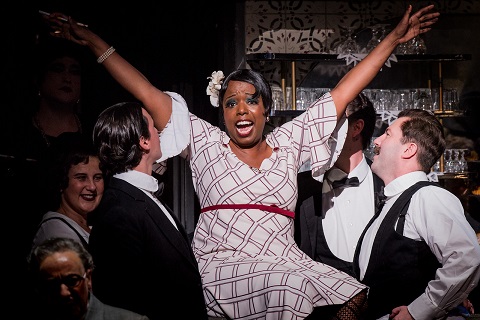 Nadine Benjamin and ENO cast. Photo credit: Robert Workman.
Nadine Benjamin and ENO cast. Photo credit: Robert Workman.
Last yet anything but least, our pair of star-crossed lovers, played by Jonathan Tetelman and Natalya Romaniw, showed themselves (mostly) sensitive artists who could yet project to the back of the largest of theatres. (Alas, the Coliseum remains not the least of ENO’s problems, whatever audience members ‘of a certain age’ might claim.) Romaniw’s Mimì proved perhaps the more moving early on, but that is more likely a consequence of the opera itself than of any great performative disparity; both certainly moved in the final tragedy of the work’s final minutes. If only they had not on occasion - under instruction, I suspect - played to the gallery, treating their ‘big moments’ as stand-alone arias. The real culprit here, I think, was Alexander Joel. His conducting of the ever-excellent ENO Orchestra was incisive and mostly unsentimental, but he seemed incapable of thinking - or at least projecting - a greater unity to each act, let alone to the score as a whole. Of Puccini’s ‘symphonism’, we heard little or nothing.
As for Miller’s production, ably revived by Natascha Metherell - who surely deserved a curtain call - it is what it is. Paris updated to the thirties looks beautiful, occasionally desperate too; Personenregie is keen. As mentioned above, I am more reconciled to its comedy than I first was. Moreover, I rather like - some do not - the glimpses we catch of characters off the set as such, carrying on with their lives. Something a little challenging or interesting, though, would surely not go amiss in the future. As yet, few if any directors seem to have matched Stefan Herheim’s challenge in his superlative Norwegian Opera production, let alone gone beyond it. Will time tell? Perhaps.
Mark Berry
Puccini: La bohème
Marcello: Nicholas Lester; Rodolfo: Jonathan Tetelman; Colline: David Soar; Schaunard: Božidar Smiljanić; Benoît: Simon Butteriss; Mimì: Natalya Romaniw; Parpignol: David Newman; Musetta: Nadine Benjamin; Alcindoro: Simon Butteriss; Policeman: Paul Sheehan; Official: Andrew Tinkler. Director: Jonathan Miller; Revival director: Natascha Metherell; Set Designs: Isabela Bywater; Lighting: Jean Kalman; Revival lighting: Kevin Sleep; Chorus (chorus master: Mark Biggins) and Orchestra of the English National Opera/Alexander Joel (conductor). Coliseum, London; Monday 26 November 2018.
image=http://www.operatoday.com/ENO%20La%20boh%C3%A8me%20David%20Soar%20Nicholas%20Lester%20Bozidar%20Smiljanic%20Jonathan%20Tetelman%20Natalya%20Romaniw%20%28c%29%20Robert%20Workman.jpg image_description= product=yes; product_title=ENO revive Jonathan Miller’s La bohème product_by=A review by Mark Berry product_id=Above: David Soar, Nicholas Lester, Bozidar Smiljanic, Jonathan TetelmanPhoto credit: Robert Workman
Sir Thomas Allen directs Figaro at the Royal College of Music
This autumn, though, ‘canonic’ composers have dominated the programming. The Royal Academy offered us Olivia Fuchs’ sharply observed Semele for the smart-phone age. And, now, following the Guildhall School of Music and Drama’s presentation of Così fan tutte, the Royal College of Music have similarly elected to test themselves in Mozartian waters with this charming production of The Marriage of Figaro.
In the GSMD’s Così, director Oliver Platt eschewed rococo elegance for rowdier revelry, taking us to a 1950’s hot-spot, Alfonso’s Bar , located near a US naval base in the South Pacific. Sir Thomas Allen plumps for tradition and his designer, Lottie Higlett, transforms the RCM’s Britten Theatre into Count Almaviva’s eighteenth-century chateau, taking us on a tour which starts in the tiny, dilapidated garret where Figaro and Susanna will begin married life, continues in the spacious elegance of the Countess’s boudoir, and finishes amid the graceful trellises of the garden - skilfully arranged to allow for sleight of hand and eye, as the nocturnal intriguers carry out their machinations and reconciliations bathed in designer Rory Beaton’s beautiful moonlight glow.
Both sets and costumes are superb. And, by cleverly opening up the depth of the stage when we leave the shabby attic - with its single bed (will there be room for a double, Figaro ponders?), thread-bare chair and rather forlorn mannequin upon which Susanna’s wedding veil perches expectantly - and enter the stately sumptuousness of the Countess’s bedroom, Higlett emphasises the class tensions and injustices which propel the drama. The colour schemes are beguiling, with Susanna’s simple sky-blue dress set against the rose-gold luxuries of the aristocracy. And, the cast wear their frock-coats and fineries with confidence and style; they’ve clearly worked very hard at the particulars of characterisation and the production has been meticulously rehearsed.
I struggle, however, to say anything of import or interest about Sir Thomas Allen’s direction - other than that he has evidently exercised what must be described as a ‘light touch’. Nothing wrong with that, of course - indeed, we often have cause to lament directorial dabbling and conceptual muddling. But, it’s a credit to the singers’ alertness and rapport that, especially in Acts 3 and 4, the drama was so engaging, for they seemed to have been largely left to their own devices. Allen’s only ‘intervention’, as far as I could see, is the introduction of several ‘babes-in-arms’ - or, in the case of the Countess, a babe-in-a-crib which is whipped away by a nursemaid (is that why she’s ‘off-limits’ for the Count at this time, leading to his extra-marital forays?). Among the chorus who serenade the Countess and celebrate the weddings, there are several young girls whose arms are encumbered by a swaddled child: a reminder of the welcome responsibilities of married life, or a warning perhaps that romance ends with wedlock? Certainly, the risks of indulging one’s passions are evident, as Marcellina palpitates on the bed during ‘La vendetta’ - Bartolo’s wish for revenge firing her own desire for Figaro - and the Countess almost expires from an overdose of sensual craving aroused by Cherubino’s serenading.
During the performance there was much excellent singing to admire, but I had misgivings as proceedings got underway as conductor Michael Rosewell (Director of Opera at the RCM Opera Studio) seemed determined to make a dramatic impact at the expense of idiomatic style. The overture was fast and unremittingly loud, but where was the elegance and wit of phrasing, the grace of line, the carefully delineated contrasts of colour and timbre? Accents were hammered home and the relentless tempo and temperature adversely affected the ensemble and intonation. There was little sense that the structure of the overture might articulate its own, and the opera’s, drama; impact was favoured over inference. Fortunately, though the pit was very ‘present’ throughout the performance, things settled down, the woodwind and horn tuning improved, and there was some pleasing playing as the evening progressed.
Adam Maxey has a handsome baritone, a relaxed manner, and - being of imposing height - a strong stage presence, but he needed to use greater variety of colour and dynamic to define Figaro’s character and his response to the unfolding drama more precisely. As Susanna, Julieth Lozano stole the show. Her soprano has a juicy middle range and there were flashes of real brightness at the top; she controlled the vocal line as skilfully as she commanded events. Indeed, this was not a Susanna to be messed with, as Conall O’Neill’s disconcerted Antonio discovered when she ripped his potted geranium to shreds when he frustrated her plans and wishes. But, Susanna’s charm was equally apparent and ‘Deh vieni, non tardar’ was beautifully sung.
I first enjoyed Sarah-Jane Brandon’s singing in 2010 when she performed with Mark Morris’s Dance Group in Handel’s L’Allegro, il Penseroso ed il Moderato at the London Coliseum, and since then she’s been a frequent and rewarding presence on London’s concert and opera stages. She seemed out of sorts, though, in ‘Porgi, amor’ which, while controlled and firm of tone, lacked Brandon’s usual sensitivity of phrasing and colour. That she was unwell was confirmed when the cause for the extended interval was revealed by an announcement that Brandon would be replaced in Acts 3 and 4 by Josephine Goddard (the Countess in the alternative cast). Goddard demonstrated impressive variety of tone and the poignancy of ‘Dove sono’ was enhanced by some lovely pianissimo nuances.
Harry Thatcher was a convincing Count, complex, angry, frustrated and repentant. He was no fool, but he was outwitted, and his growing irritation and confusion was skilfully delineated by Thatcher in Act 3, culminating in a fiery but stylish ‘Vedro mentr’io sospiro’. This was a thoughtful characterisation, one which encouraged us to both condemn and understand, and ‘Contessa perdano’ was touching. Thatcher’s elegant bearing and urbanity were tempered with genuine human feeling, and we were inclined to forgive this Count for his frailties.
Lauren Joyanne Morris has a full, rich mezzo but she didn’t entirely persuade me in the role of Cherubino. A little too tall to be gamine, Morris did not seem to have determined precisely how to convey the page’s adolescent yearning - perhaps a little more direction would have helped. She sang strongly, but I’d have preferred a lighter approach, particularly in ‘Non so più’ which needs to sound both youthfully innocent and slightly breathless with a passion barely understood. Poppy Shotts was excellent as Barbarina, and her Act 4 aria ‘L’ho perduta, me meschina’ was confident and poised.
The comic trio entered into the Christmas-panto spirit, though the young singers inevitably found it a challenge to really convince as aged intriguers. Katy Thomson defined Marcellina strongly, though occasionally over-did the Hyacinth Bucket caricature. Timothy Edlin was terrific as Bartolo, relishing ‘La vendetta’ - and he was more dramatically persuasive when he removed his tricorn hat and we could see Bartolo’s bald pate and stringy curls. Joel Williams, as Basilio, completed the fine cast.
This was a long but enjoyable performance. The cast worked incredibly hard, to good effect, and the drama grew in charm and shine as the evening progressed. Tradition proved a real treat.
Claire Seymour
Mozart: The Marriage of Figaro
Count Almaviva - Harry Thatcher, Countess Rosina - Sarah-Jane Brandon/Josephine Goddard, Susanna - Julieth Lozano, Figaro - Adam Maxey, Cherubino - Lauren Joyanne Morris, Marcellina - Katy Thomson, Bartolo - Timothy Edlin, Basilio - Joel Williams, Don Curzio - Samuel Jenkins, Barbarina - Poppy Shotts, Antonio - Conall O’Neill, Bridesmaid 1/Chorus - Camilla Harris, Bridesmaid 2/Chorus - Jessica Cale; Director - Sir Thomas Allen, Conductor - Michael Rosewell, Designer - Lottie Higlett, Lighting Designer - Rory Beaton, Choreographer - Kate Flatt, Chorus and Orchestra of the Royal College of Music Opera Studio.
The Britten Theatre, Royal College of Music, London; Monday 26th November 2018.
image=http://www.operatoday.com/RCM%20Figaro%20image.jpg image_description= product=yes product_title=The Marriage of Figaro: Royal College of Music, Britten Theatre product_by=A review by Claire Seymour product_id=November 27, 2018
Unknown, Remembered: in conversation with Shiva Feshareki
The answer is Unknown, Remembered: a site-specific production which interweaves diverse materials, memories, media and meanings, and which will be presented at this year’s Spitalfields Music Festival , between 4th and 9th December. I met with composer Shiva Feshareki - who has composed a new work setting lyrics by Joy Division which, as Unknown, Remembered unfolds, will interact with Haroon Mirza’s 2010 film The Last Tape and Handel’s musico-dramatic characterisation of his tragic, desolate heroine - to discuss the ways in which these varied forms of expression come together to articulate a complex, multi-faceted, three-dimensional narrative which charts a journey from trauma to euphoria.
Shiva begins by explaining the genesis of her own contribution to Unknown, Remembered. Spitalfields Music Festival’s Artistic Curator André de Ridder was keen to centre a new work around the rock band Joy Division, formed in the 1970s and fronted by singer Ian Curtis. Shiva began exploring the lyrics of the band’s debut album, Unknown Pleasures (1979), thinking about ways of restructuring the narrative and finding a way of assimilating and communicating the voice of Deborah Curtis - the wife of Ian who took his own life in May 1980 aged just 23-years-old.
The desire to present a female perspective and voice, which might counter, engage with, reflect upon and assimilate the perspective of the male poet-narrator of these songs, was clearly central to Shiva’s artistic aims. But there is no ‘literal character’ in this work - which will be performed by soprano Katherine Manley, accompanied by viola da gamba, piano and live electronics; rather there is an accumulation of sung sentences that gradually coalesce to form a visceral echo-chamber of memory, experience and mediation. Shiva explains that she selected ten sentences from Curtis’s lyrics which during her 30-minute composition are presented in different orderings, arranged so that there is always ‘sense’ but that this ‘sense’ evolves as the permutations unfold. The use of live electronics, which create a ‘delay’ resonance, further complicates issues of time, place, meaning.
There is no defined ‘starting-point’ and preconceived ‘destination’; rather there are words which infuse, cohere and conflict to create what Shiva describes as a ‘sonic sculpture’. Linearity is rejected in favour of an aesthetic based upon accumulation, engagement and interaction. I ask Shiva whether there is any aleatoric dimension to the performance, and she explains that the use of live electronics does mean that there is an element of chance, but that it is fairly small. The chosen ten sentences have been carefully selected and arranged, though it is the physicality of the sound rather than its intellectual conception which is clearly at the forefront of Shiva’s aesthetic. Sound and movement, sound and space, the geometry of musical sound, the psychology of this geometry: these are her preoccupations and expressive aims and stimuli.
I ask Shiva about her approach to text-setting and, in keeping with the above described aesthetic, she speaks of the vocal line as being a spatial concept - a sculptured musical text - in which repetitions, silences and spaces between words define meaning. At the start of her composition the sentences are longer and more fluid; subsequently, there is more animation, shorter textual units, increased velocity.
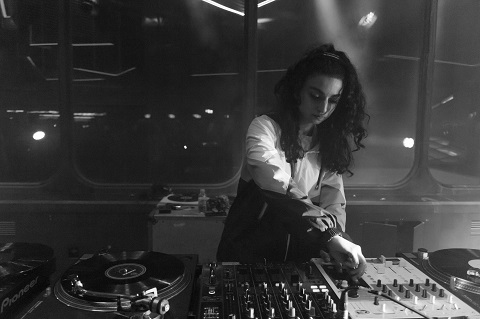 Shiva Feshareki. Photo credit: Rupert Earl.
Shiva Feshareki. Photo credit: Rupert Earl.
I suggest that, while Shiva feels her conception of ‘sculptured sound’ is something new, one witnesses such ‘sound-worlds’ - the communication of lives, minds and hearts that are defined by the sonic architecture of voiced experience - in music from Monteverdi to the composers of the modern-day. I mention Richard Strauss’s early operas, Salome and Elektra, Schonberg’s Erwartung, as well as the work of Stockhausen and others who developed concepts of spatialization, not only in electronic music: after all, Stockhausen called for new kinds of concert halls to be built, ‘suited to the requirements of spatial music’. Shiva agrees that Stockhausen’s aesthetic is relevant to her own work; but she seeks a simpler, more ‘stripped back’ form of expression, one which communicates more directly. And, she explains that the music of James Tenney - in particular his conception of the psychology of sound, and his use of text - has exerted a stronger influence on her own work.
We come back to the varied components which will contribute to the audience’s experience of Unknown, Remembered. Haroon Mirza’s The Last Tape was first presented in VIVID’s garage space in Birmingham’s industrial Eastside district in 2010, and comprises film and sculpture, bringing sound and light together to form a literal and metaphorical electric current which is kinetic and immersive. An actor-musician, Richard ‘Kid’ Strange, reinterprets Beckett’s last play - in which the protagonist, Krapp, looks back at the events of his life as recorded onto tape - using previously unrecorded lyrics written by Ian Curtis; Mirza’s film presents Strange enacting the lyrics onto magnetic tape as the actor engages with audible sounds created by accompanying sculptures. The latter include furniture, radio and an LCD screen, as well as turntables which Shiva herself will manipulate, in an improvised fashion, during the video.
Unknown, Remembered is described by the Spitalfields Festival as being ‘site-specific’ although Shiva explains that while the relationship between sound and movement is always ‘specific’ to a performance venue, this aspect is not the starting-point for the projected evening performance. It’s important to create a work that is fluid; that can sustain and develop a ‘life’ as it moves through time and across space. Each repetition of Haroon’s installation involves an exploration of context and fresh experimentation and interaction.
And, then, there’s Handel, whose dramatic soliloquy will also part of the aesthetic mix. Emotions such as love and anger, betrayal and anger, seem to hover over the diverse components. But, if I’m honest, I’m both bewildered and fascinated as to how the parts might form a ‘whole’. I guess I will have to let go of concepts such as coherence and submit to immediacy and interaction, dialogue and dialectic, though Shiva - who leaves me to head to the first staged rehearsal of Unknown, Remembered - is still herself to see how the various parts might speak to each other and embody sonically and spatially expressive architectural forms. She speaks too of her appreciation of the unusually broad expanse of time that has been available to develop, create and rehearse Unknown, Remembered.
For those who want a foretaste and further explication, there’s an insight event at 4.15pm at Chapel Royal of St. Peter Ad Vincula, HM Tower of London at which at which Handel’s La Lucrezia will be performed, and when André de Ridder, director Marco Štorman and Shiva Feshareki will host a Q&A session. Otherwise, you’ll have to wait for my cogitations after the performance on Sunday 9th December.
Claire Seymour
image=http://www.operatoday.com/Shiva%2040%20by%20Igor%20Shiva.jpeg%20%281%29.jpg
image_description=
product=yes
product_title=Unknown, Remembered, Spitalfields Music Festival 2018
product_by=A preview by Claire Seymour
product_id=Above: Shiva Feshareki
Photo credit: Igor Shiva
November 25, 2018
Old Bones: Iestyn Davies and members of the Aurora Orchestra 'unwrap' Time at Kings Place
Muhly’s Old Bones adopts an idiosyncratic angle from which to reflect upon ‘Time’. Heard here in a new arrangement, conducted by the composer, for harp, celeste and string quartet, the text (by Richard Buckley, Philippa Langley and Guto’r Glyn) narrates the discovery and exhumation of the bones of Richard III in a car park in Leicester in 2012. A fragmented texture suffused with the cello’s pizzicato energy conjures the excitement of detection and revelation - “They dug in that spot, and the leg bones were revealed”. Davies’ composure and narrative focus drew us into the significance of the unearthing, and we soon became as compelled as the onlookers whose transfixed gaze is suggested by the harp’s oscillations and the repetitions of the viola’s melody. The fusion of past and present is embodied in the text itself, with third-person narration from the perspective of the present juxtaposed with first-person observation and reflection from the medieval past. The participant’s resonant announcement, “King Henry won the day”, was celebrated by the assertive lower strings, while the strange, disturbing feelings experienced by the modern-day ‘archaeologist’, “I am standing on Richard’s grave”, were evoked by churning, twisting harmonies. Slowly rising from a sustained pianissimo pause, the dead King himself seemed to reclaim life, “Now you can understand me”, “I’m ready”, the clarity and strength of Davies’ vocal exclamation suggesting the ghostly compulsion to speak from the grave as well as the madness of the modern-day observer: “Everyone else was looking at old bones, and I was seeing the man.”
Muhly’s Clear Music for cello, harp and celeste also unites present and past, being thematically based upon an early choral work by John Taverner, Mater Christi Sanctissima. Unfolding an eloquent opening melody, cellist Sébastien van Kuikj fell from a beautiful high-lying opening to richer, heavier grains of the lower strings, while the entry of the harp and celeste conjured the luminous spaciousness of Renaissance choral polyphony and the towering cathedrals that such music evokes in musical form. Motion for clarinet, piano and quartet similarly builds upon a Renaissance fragment, from Orlando Gibbons’ verse anthem See, see the Word, and the instrumentalists ranged with a rapidly accelerating sweep through vivid terrain.
Interweaved between old and new were instrumental works from the late-nineteenth century. Pianist John Reid opening the concert with the quietly breathing pulse of Satie’s Third Gymnopédie while harpist Sally Price conjured first heavenly light and air, and then ripples of colour, in Debussy’s Danse Sacrée et Danse Profane. Against the sensitive nuance of the piano accompaniment and the low silkiness of Hélèle Clément’s viola obbligato, Davies worked hard to communicate the yearning and fulfilment of Brahms’ Gestillte Sehnsucht (Assuaged Longing) but while there was firm resoluteness and a relaxed power the countertenor struggled to convey the Straussian passion which infuses this lied.
Two works by Thomas Adès made the strongest impression. Written when the composer was just eighteen-years-old, The Lover in Winter (1989) is a delicate miniature song-cycle whose Latin texts speak of the warmth with which love can assuage and transform the cold, bleak season. At the start, the strangeness and menace of this winter world is evoked by the unsettling intervals of the voice’s descending scale, ‘Iam nocetteneris’ (Now the cold harms what is tender). Here, Davies’ pure sound was a shining ray of wintry sunlight, while in the third song, ‘Modo figescit quidquid est’ (Soon all that exists grows cold), a beautiful, blanched tone captured the frozen immobility of the landscape, cracking icicles sparkling in the piano accompaniment. The fire of the lover’s kisses surged through the wavering vocal line at the opening of the final song, ‘Nutritur ignis osculo’, while the fragmentation of text and melody at the close conveyed a quasi-transcendental force: ‘nec est in toto seculo plus numinis’ (there is not in all our age more of the holy power).
Adès’ mysterious Four Quarters (2010) was brilliantly played by the four string players from the Aurora Orchestra. At the start, ‘Nightfalls’ opened up vast vistas of time and space, as high and low lines wove an ethereal web. The rhythmic displacements of ‘Morning Dew’ were skilfully controlled, accents pointedly placed, while in ‘Days’ the instrumental voices piled upon one another creating thick textures and tones of lovely colour, underpinned by the shapely cello phrases. The wildest wanderings conjured by the fiendishly complex 25/16 time-signature of ‘The Twenty-fifth Hour’, representing time spilling beyond the clock, did not ruffle the composure established by Alex Wood’s serene harmonics at the start, against the viola’s brushed chords and the cello’s gentle pizzicato.
Adès’ cycle evokes a tradition of English song stretching back to the Middle Ages and Renaissance, and the recital fittingly closed with Muhly’s arrangement - for an ensemble comprising all the present musicians - of John Dowland’s beautiful lute song, Time Stands Still. Now, Davies’ voice seemed somehow ‘released’, more freely expressive than previously, hovering above and then nestling gently into the muted strings’ cadential consonances. Viola and cello echoed and intertwined with the vocal phrases, while the contrasting harp colour seemed to embody the innate rhetoric and inner debate of the lyrics: ‘If bloudlesse envie say, dutie hath no desert,/Dutie replies that envie knows her selfe his faithfull heart.’
The text of Dowland’s song, which was published in 1603, is laden with emblems which suggest that the lyrics are a panegyric to Queen Elizabeth I - fittingly so, for, looking ahead, if at Kings Place Time will shortly come to a point of rest and silence, then Venus is soon to be awoken and given voice.
Claire Seymour
Iestyn Davies (countertenor), Sally Pryce (harp), John Reid (piano/celeste), Principal Players of Aurora Orchestra
Satie - Gymnopédie No.3; Thomas Adès -The Lover in Winter; Nico Muhly - Clear Music; Debussy -Danse Sacrée et Danse profane; Brahms - Gestillte Sehnsucht; Muhly - Old Bones (world premiere of new arrangement), Motion; Adès - The Four Quarters; Dowland (arr. Muhly) Time Stands Still
Kings Place, London; Friday 23th November 2018.
image=http://www.operatoday.com/iestyndavies-40-Chris-Sorensen.jpg image_description= product=yes product_title=Old Bones: Iestyn Davies and members of the Aurora Orchestra at Kings Place product_by=A review by Claire Seymour product_id=Above: Iestyn Davies (countertenor)Photo credit: Chris Sorensen
November 24, 2018
Cinderella goes to the panto: WNO in Southampton
The single ‘comic’ opera alongside the nine serious works that he wrote for the Teatro San Carlo in Naples between 1815 and 1822, it was regarded by the French poet Théophile Gautier as “a bottomless treasure, as if someone, in a fit of extravagance, plunged their arms up to their elbows into a pile of precious stones and then randomly started to throw handfuls of rubies and diamonds up into the air”. However, others lamented Rossini’s subversion of sentimental comic convention. Stendhal, after attending performances in Milan and, two years late, in Rome, expressed his dissatisfaction: “performance after performance left me cold and unmoved, beautiful as it is, [the music] seems to me to be lacking in some essential quality of ideal beauty.”
Above all, Stendhal lamented what he felt was the absence of ‘true’, elevating emotion in the portrayal of the characters of humble origin. Jacopo Ferretti’s libretto places the well-known fairy tale in a bourgeois context. Out with the fairy godmother and in with a charitable philosopher-cum-tutor who wishes to see his princely charge marry a ‘good’, honest lass. Out with the cruel step-mother and in with a socially and financially grasping step-father, Don Magnifico. Out with the glass slipper and in with a glittery bangle, a simple gift from the disguised Prince Ramiro which confirms Cinders’ lack of snootiness and avarice. Stendhal complained that Rossini’s score illuminated nothing but “the petty hurts and pettier triumphs of snobbishness”.
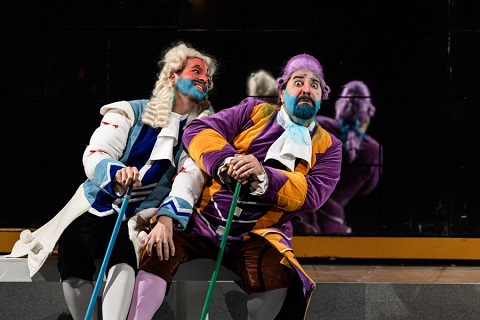 Giorgio Caoduro (Dandini), Fabio Macchioni (Don Magnifico). Photo credit: Jane Hobson.
Giorgio Caoduro (Dandini), Fabio Macchioni (Don Magnifico). Photo credit: Jane Hobson.
Director Joan Font’s production - first performed by Welsh National Opera in 2007 - tries to resurrect some of the transformative magic of Alice’s Wonderland … by making a trip to Poundland. Designer Joan Guillén’s sets and costumes are bold and brassy: all plastic and plasticine and primary hues. Font and his Barcelona-based company Comediants have often exploited Mediterranean carnivalesque, and one might wonder if Font’s conception was influenced by Gautier’s praise: “Looking again at the music one sees how, just like playing the castanets, a sparkling line of trills and arpeggios blossoms forth. The music sings and laughs!” For, Font conjures the eighteenth-century Enlightenment through the vitality of a Spanish palette and the hyperbole of cartoon caricature.
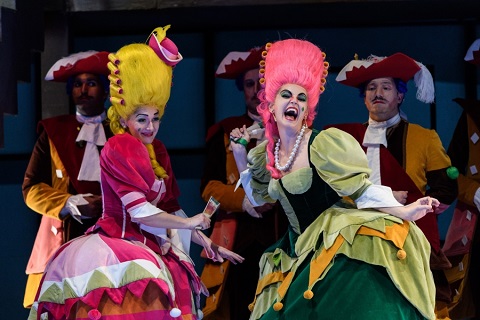 Heather Lowe (Tisbe), Aoife Miskelly (Clorinda). Photo credit: Jane Hobson.
Heather Lowe (Tisbe), Aoife Miskelly (Clorinda). Photo credit: Jane Hobson.
The mundane, magical and plain mischievous co-exist. Cinders goes to the ball in a sedan chair which her rodent ‘courtiers’ and carpenters have assembled from a shabby chest of drawers; the Prince’s coach is magicked into being by some rotating mirrors … but later its miniature model is derailed by a roguish rat. Font puts the panto back into a period piece which had itself embodied the tension between ‘pure’ sentimentality and sensibility as hijacked by middle-class social climbers, but in so doing takes away much of the genuine enchantment of Rossini’s music as visual gags overpower vocal expression.
To some extent, though, this production was defeated by the size of Southampton’s Mayflower Theatre; when it opened in 1928 it was the largest theatre in the south of England, and still seats almost 2,300. Guillén’s designs seem to carry the cast to the far reaches of the vast stage; when atop the raised balcony at the rear, descending the framing stairs, or nestled within the grey-brick inglenook - especially when the mantle was raised to reveal the grand entrance to the Prince’s palace - the soloists sometimes struggled to project.
Likewise, in this barn of an auditorium conductor Tomáš Hanus struggled at times to keep the ensemble forces together. Proceedings got underway with a somewhat sluggish, desultory overture, with some questionable tuning from horns and wind, and rather listless Rossinian crescendos which were aching for an injection of ‘Formula-1’ acceleration. The patter of Don Magnifico’s first aria - sung briskly and ebulliently by Matteo Macchioni - in which he curses his daughters for waking him from his dream of being turned into a donkey - left the WNO Orchestra trailing in his wake. But, subsequently, Hanus put his foot on the pedal and left the Prince’s courtiers lagging behind. The ensembles were often metrically messy and occasionally in danger of skidding of the circuit. Perhaps it did not help that the laughs came from the visual trappings rather than from the dramatic interaction of the cast who were often left languishing in theatrical isolation in the ensemble numbers.
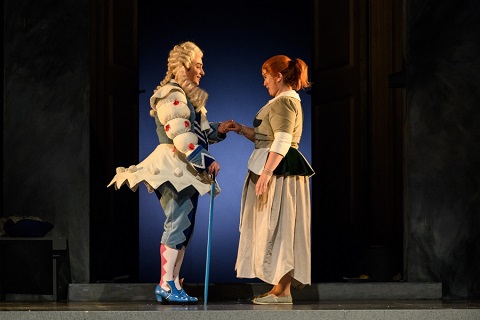 Matteo Macchioni (Don Ramiro), Tara Erraught (Angelina) Photo credit: Jane Hobson.
Matteo Macchioni (Don Ramiro), Tara Erraught (Angelina) Photo credit: Jane Hobson.
That said, some superb singing offered much to admire. Don Magnifico might come across as a mean-spirited materialist but Fabio Capitanucci gave him a patina, at least, of lovability - and demonstrated a fine technique and good dramatic judgement. As Clorinde and Tisbe, Aoife Miskelly and Heather Low established their respective characters well at the start - much poncing, preening and ‘prettifying’ - and despite the parody which infects their song, and the brittleness of their boasting and bullying, they never sounded shrill.
As the human philosopher, Alidoro, Wojtek Gierlach - denied a magic wand but cloaked in a star-spangled cape - was a sonorous Prospero-cum-Sarastro, and if he didn’t quite attain a spiritual stature then he sang with beauty and authority.
Prince Ramiro was neatly sung by Matteo Macchioni; his tenor has brightness if not real bloom, and he presented a charming characterisation of a man who is more an emblem than an embodiment of royalty, and who doesn’t really find his ‘self’ until he’s wearing someone else’s suit.
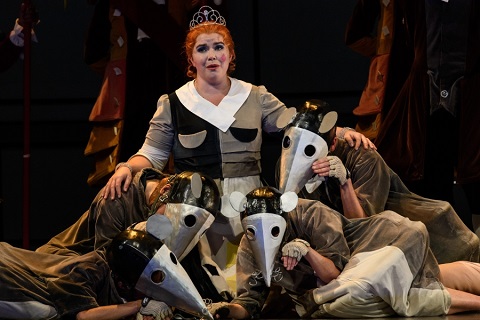 Tara Erraught (Angelina), WNO Dancers. Photo credit: Jane Hbson.
Tara Erraught (Angelina), WNO Dancers. Photo credit: Jane Hbson.
Wearing the figurative crown though, appropriately, was Tara Erraught, who somehow imbued Cinderella’s lovely first aria, ‘Una volta c’era un re’, with sadness, longing, and hope, simultaneously. She was both of this world - down-to-earth and without illusion - and innocently unworldly. Vocally, her line was pure and controlled; the coloratura clean and clear; the pristine, polished evenness and sparkle of her tone heart-winning. No wonder the Prince was smitten. A pragmatist rather than a Prince hunter, this Cinders did not let good fortune tarnish her innocence or dull her natural glow of goodness.
Cinders’ helpmate-rodents - ever-present, ever-twitching - both stole the show and kept it on the road: observing and facilitating, overseeing and fixing. But, when the loudest applause is generated by the balletic unrolling of the red carpet by a pair of rats, something must surely be amiss. But if, like Stendhal, one missed a certain nobility of feeling, then at least, and luckily for the rats, there was no Cheshire Cat lurking in the inglenook.
Claire Seymour
Rossini: La Cenerentola (co-production between Welsh National Opera, Houston Grand Opera, Gran Teatre del Liceu and Grand Théâtre de Genève)
Angelina (Cinderella) - Tara Erraught, Clorinda - Aoife Miskelly, Tisbe - Heather Lowe, Don Ramiro - Matteo Macchioni, Don Magnifico - Fabio Capitanucci, Alidoro - Wojtek Gierlach, Dandini - Giorgio Caoduro, Rats/Dancers - Colm Seery, Darío Sanz Yagüe, Ashley Bain, Meri Bonet, Lucy Burns, María Comes Sampedro, Lauren Wilson; Director - Joan Font, Conductor - Tomáš Hanus, Revival Director/Choreographer - Xevi Dorca, Designer - Joan Guillén, Lighting Designer - Albert Faura (realised on tour by Paul Woodfield), Welsh National Opera Orchestra.
Mayflower Theatre, Southampton; Thursday 22nd November 2018.
image=http://www.operatoday.com/WNO%20La%20Cenerentola%20Cast%20of%20La%20Cenerentola%20Photo%20credit%20%C2%A9%20Jane%20Hobson.jpg image_description= product=yes product_title=Welsh National Opera’s La Cenerentola, at the Mayflower Theatre, Southampton product_by=A review by Claire Seymour product_id=Above: Cast of WNO La CenerentolaPhoto credit: Jane Hobson
November 23, 2018
It's a Wonderful Life in San Francisco
Maybe you’ve seen the 1946 film It's a Wonderful Life. It seems many of you have, maybe most of you, and it seems that Jake Heggie and San Francisco Opera know you are yearning to return to that simpler time when the housing crisis was easily solved by simple community economics, big government was no where to be seen or felt, and winged Christian angels, like the one once atop your Christmas tree, watched over you. And, well (there can be no doubt), you are Christians and that prayers actually worked.
Though you once might have dreamt about college and a larger world, the world of Bedford Falls, NY is already pretty big in itself, or big enough to satisfy the ambitions of a good husband and father and citizen. When an outside evil intrudes (the “yellow peril”) you hold a spine-chilling rally to "Make America Great" again.
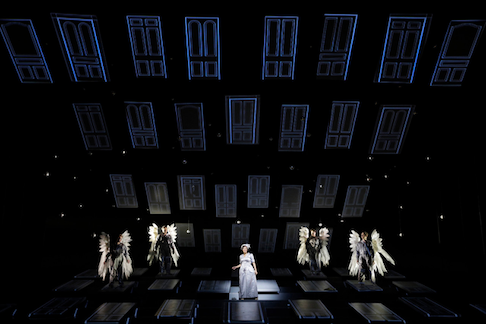 Set design by Robert Brill, costume design by David C. Woolard
Set design by Robert Brill, costume design by David C. Woolard
Mr. Heggie and Mr. Scheer’s It’s a Wonderful Life is a tight (it enjoyed a gestation period in Bloomington and Houston before arriving at the War Memorial), beautifully crafted opera that tells its story in high operatic terms — it is a string of lyric moments woven into compelling, if trivial episodes that propel us to a final crisis that even the opera’s hero, George Bailey of Bedford Falls, NY learns is trivial — that it’s not worth killing yourself over $8000 ($111,000 in today’s dollars).
Mr. Scheer proved himself a brilliant librettist in his masterful adaptation of the Great American Novel Moby Dick for composer Heggie. Jake Heggie himself now has resolutely proven himself the Great American Composer with It’s a Wonderful Life, following Moby Dick and Dead Man Walking, works that embody the American spirit in flowing, intensely lyrical, American middle high-art musical terms. In It’s a Wonderful Life Mr. Heggie exploits the richness of American vaudeville, and dwells incessantly on the mannerisms of the American musical as well. Startlingly the opera begins with an ear-splitting imitation of the primitive sound of postwar movie theater amplification.
The opera’s coup de théatre is the moment George Bailey understands that if he had never existed there would be no music. It becomes a spooky, spoken world that makes us encourage George to quickly get back to the world of everyday problems that you can easily sing about — eschewing, of course, any whiff of the psycho-sexual violence that is the meat of real opera.
But wait. There was a second coup de théâtre and that was an urge to sing "Auld Lang Sang" that gripped us all when George at last hugged his wife and kids standing before a brilliantly lighted Christmas tree under the loving gaze of his suspended Guardian Angel. Well, we all belted it out with the maestro before leaping to our feet to salute the very fine artists and the excellent production.
Orchestrally It’s a Wonderful Life is scored for single winds (except two horns) and strings making it easily accessible for smaller holiday productions in regional theaters. On the other hand there can be no doubt that It’s a Wonderful Life will find international success in theaters throughout the world as a throbbing example of Americana.
Though of great sophistication the production by Leonard Foglia and Robert Brill was quite simple — a unit set of countless, identical floating panels that were doors, maybe tombs, other times wallpapered panels, floors, clouds that were heaven, streets, etc. The angels in heaven were breathtakingly flown in from the celestial spheres of the War Memorial fly loft. Costuming was the period of the film (1946).
There was considerable choreography, some maybe expertly fronted by dancers of the San Francisco Opera Ballet, but mostly executed by the principals together with 28 members of the San Francisco Opera Chorus, presumably chosen for their lithe bodies to fit the costumes of students of Bedford Falls High School and then the not-too-well-fed Irish and Italian immigrants that lived on the other side of the tracks.
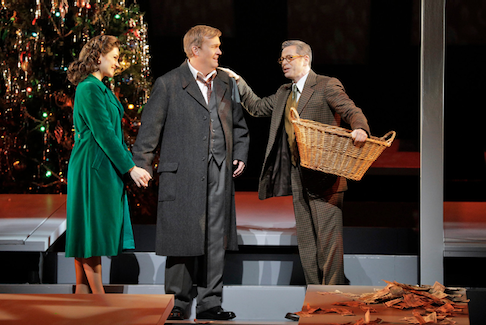 Andriana Chuchman as Mary Hatch, William Burden as George Bailey, Keith Jameson as Uncle Billy Bailey
Andriana Chuchman as Mary Hatch, William Burden as George Bailey, Keith Jameson as Uncle Billy Bailey
The casting for the production made its bow to multi-culturalism by casting George Bailey’s guardian angel Clara [as in The Nutcracker] with the South African soprano Golda Schultz who set the standard for the high-level vocal performances that characterized the evening. American baritone William Burden successfully embodied the young George Bailey to then become the distraught middle aged banker and the loving husband. Canadian soprano Andriana Chuchman brought force and beauty of voice to create George’s emotional anchor, his wife Mary Hatch (who did escape to New York but came right back to Bedford Falls to create a home for George).
Confined to a wheelchair as the crooked businessman Mr. Potter, Los Angeles bass-baritone Rod Gilfry exuded greed and selfishness, his wheelchair coldly and calculatedly guided by the production’s one supernumerary. George’s brother Harry who does go off to college was sung by Canadian baritone Joshua Hopkins with vibrant presence. Genuinely batty Uncle Billy was aptly played by Keith Jameson, and George’s mother found big prominence as sung by San Francisco mezzo soprano Catherine Cook.
There are 34 named roles in It’s a Wonderful Life. Of the principals identified above Mr. Burden, Mr. Gilfry and Mr. Hopkins survive from the Houston cast. Conductor Patrick Summers from the Houston Opera ably helped the singers carve out their roles, evoking suitable orchestral pizazz.
Disclaimer: I have not seen the Frank Capra film, It’s a Wonderful Life.
Wise opera goers could pay $10 for standing room for the brief 2 1/2 hours that fly by fairly quickly, though you may wish to suggest a few economies to Mr. Heggie.
Michael Milenski
Cast and production information:
Clara: Golda Schultz; Angels First Class: Sarah Cambidge, Ashley Dixon, Amitai Pati, Christian Pursell; George Bailey: William Burden; Harry Bailey; Joshua Hopkins; Uncle Billy Bailey: Keith Jameson; Mother Bailey: Catherine Cook; Mary Hatch: Andriana Chuchman; Mr. Potter: Rod Gilfry; Helen Bailey: Carole Schaffer. Chorus and Orchestra of the San Francisco Opera. Conductor: Patrick Summers; Stage Director: Leonard Foglia; Set Designer: Robert Brill; Costume Designer: David C. Woolard; Lighting Designer: Brian Nason; Projection Designer: Elaine j. McCarthy; Choreographer: Keturah Stickann. War Memorial Opera House, San Francisco, November 20, 2018.
image=http://www.operatoday.com/WonderfulLife_SF1.png
product=yes
product_title=It’s a Wonderful Life in San Francisco
product_by=A review by Michael Milenski
product_id=Above: Golda Schultz as Clara [All photos copyright Cory Weaver, courtesy of San Francisco Opera]
Des Moines: Glory, Glory Hallelujah
Scheduled in the wake of Veteran’s Day celebrations, and performed at Camp Dodge, the work had an especial, gut-wrenching resonance as it tells the true story of
an American family torn apart during the unsettling era of the unpopular Vietnam War. Cipullo’s masterfully taut adaption of Tom Philpott’s book of the same name, makes a cogent impression in just seventy-five compact minutes with a score that is by turns chaotic, angular, melodic, harmonious, and even at times, serene.
This chamber opera utilizes just four characters, or really just two. I will explain. As the American soldier held longest in captivity during that prolonged conflict, Colonel Jim Thompson suffered unimaginable hardship in the jungles of Southeast Asia. His wife Alyce suffered with her own daunting challenges back home, raising four children and facing brutal, heartrending choices.
The story largely concerns their complicated relationship, as each must contend with personal struggles arising from Thompson’s disappearance, liberation, repatriation, and it is revealed, abandonment by his spouse. The opera utilizes a brilliant device of having a second couple, a “younger” Jim and Alyce reflecting, challenging, and informing their “older” selves. By seeing where the couple began, we see how they arrived at their current state of affairs.
The four actors interact freely and seemingly spontaneously, sometimes in a certain reality of the moment, and on other occasions, time traveling to speak with and about their alternate incarnations. They sometimes briefly enact other characters. This is not a strictly linear narrative but rather an intriguing mosaic of impressions and factual information, stunningly interwoven in a soul stirring evening of profound suffering and eventual forgiveness and redemption. Jim Thompson is truly a heroic subject, worthy of ennoblement by a thrillingly varied score, mesmerizing libretto, and a flawless, kaleidoscopic staging by the abundantly gifted director, Kristine McIntyre.
The central playing space has audience members on all four sides and Ms. McIntyre has devised fluid, continuously morphing stage pictures that not only underscore the dramatic truth of the situations, but also keep each segment of the audience fully immersed in the drama by having at least one character playing in their direction. She drew deeply personal portrayals from her superb cast. And she has obviously toiled to great effect as she developed “younger” and “older” versions of Jim and Alyce that share identical personality cores as well as an eerily unified approach to the roles’ physicalization. We really believed that these were two embodiments of the same two souls.
I may have said it before, but it bears repeating: Kristine McIntyre is one of the foremost directors working in opera today. If you see her name in the credits, rest assured it is going to a top tier, often revelatory experience. She was ably abetted by a superlative creative team.
Adam Crinson’s effective set design features a simple island, an “X” of platforms, with flats masking entrances on all four corners, which are painted in shades of tropical green, marked with images of falling palm fronds that “spill” onto the stage. There is something almost sacrificial of the altar-like raised central platform. The simple, short bamboo stools and piles of (unread? unreceived?) letters guttered in the corners of the set are the only real dressing, save for the silver stars hanging from the grid that reinforce an important “beat” in the plot. Judicious use of well-produced film projections added immeasurably to the visual impression.
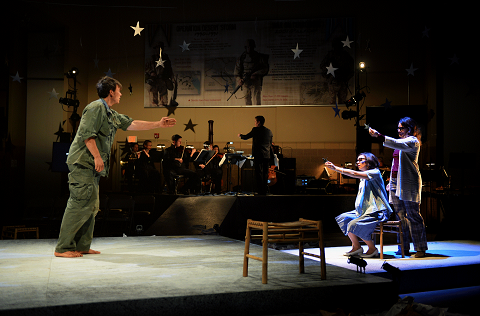 Photo credit: Duane Tinkey.
Photo credit: Duane Tinkey.
Kathy Maxwell has worked wonders with a beautifully calibrated lighting design, all the more remarkable for the economy of instruments and the difficulty of lighting an arena configuration. Ms. Maxwell devised a moody, expressionistic, characterful look that served the dramatic moment at every turn. Heather Lesieur’s deceptively simple costume design was a key factor in visually defining these characters, especially the eternally pregnant “younger” Alyce, and the well chosen black horn-rimmed glasses for both Alyce’s.
As Jim Thompson, baritone Michael Mayes anchored the evening with a star turn that was simply amazing. (Or is it, A-Mayes-ing?). There is no aspect of this tremendously complex role that eludes him musically or dramatically. His deep personal commitment to portraying this eminently tragic figure is exceeded only by his incredibly effective vocalizing. Having experienced his straightforward, powerfully sung Scarpia a few seasons ago, I was not prepared for the total mastery of the nuances he brought to bear on this evening.
Mr. Mayes not only gifted us with the powerful beauty of his burnished instrument, but he also made my jaw drop with meticulously calculated, wondrously controlled sotto voce effects, including some breath taking forays above the staff. His complete immersion into the suffering and physical disintegration of his character were as commendable as they were poignant. His tour de force impersonation was well matched by his “younger” counterpart.
John Riesen’s “Younger Thompson” held the stage with a vibrant, focused tenor, and an impassioned performance of complete commitment and coltish deportment. Mr. Reisen bolted about the stage, flailed at his captors’ abuse, repeatedly flung himself on the floor, and managed to do all of this while singing with secure abandon.
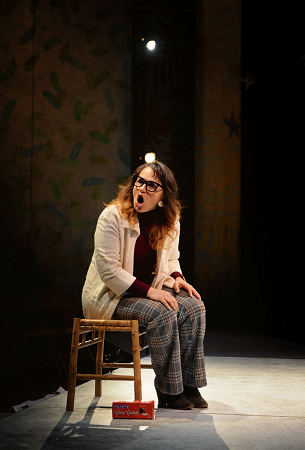 Photo credit: Duane Tinkey.
Photo credit: Duane Tinkey.
Kelly Kaduce was a magnificent Alyce, turning in yet another finely etched performance. The soprano was in especially fine voice, her secure, pliable tone and dramatic delivery in complete service to the role at hand. She is a beautiful woman, often presented in glam make-up and attire to luxurious effect. On this occasion, Kelly appeared against type, embodying a rather plain hometown girl. Her acting was simple, candid, and she totally believed in the correctness of her character’s choices. The horrible stillness encompassing her confessional aria was underscored by her alluring, purposeful delivery.
As “Younger Alyce,” Emma Grimsely showed off a silvery, gleaming soprano that was a perfect contrast to Ms. Kaduce’s weightier delivery. Ms. Grimsley was a wholly sympathetic figure, and her limpid, freely produced singing was enchantingly delivered. One caution: her subtle singing early on may have eluded the ears of a few audience members. One caveat to Mr. Cipullo: “Younger Alyce” is the only character who does not have an aria. Although she does have the radiant final phrase of the opera, might you please give her a solo “scena” to balance the quartet?
In the pit (here an elevated platform), Joshua Horsch conducted with steady acumen and considerable aplomb. Maestro Horsch has helmed this piece before and it shows in his well-controlled, colorful reading. The orchestration calls for substantial exposed playing from a small band of (for all intents) soloists, and the conductor drew a highly satisfying ensemble reading from his highly skilled instrumentalists. Horsch ably collaborated with his quartet of singers with a completely realized orchestral partnership.
There are many highlights in Tom Cipullo’s score that deserve mention: “Older Thompson” has a riveting litany of (mostly) shit happenings that occurred, unbeknownst to him owing to his isolation, that echo Billy Joel’s We Didn’t Start the Fire. The 23rd Psalm serves as a disturbing Cantus Firmus sung by “Younger Thompson,” as the other three characters embellish it with edgy, turbulent vocal lines. The orchestration includes many instances of telling effects, including the cruel interjections of a slapstick as the captive Jim is being abused.
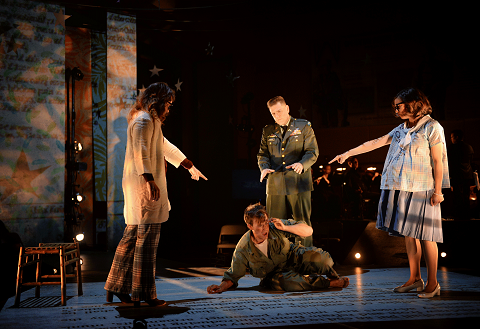 Photo credit: Duane Tinkey.
Photo credit: Duane Tinkey.
Whether by luck or design, there was also a stunning impression created by the “younger” duo being shorter than their “older “ counterparts, conveying the impression that the weathered adults are looming over, dominating their remembered selves. This wholly successful presentation was complemented by a meaningful talk back after the show that included Vietnam vets and military personnel currently serving.
Des Moines Metro Opera is a major force in the national opera scene, and if any reinforcement of that was needed, after this remarkably effective mounting of Glory Denied, I can emphatically say: Mission Accomplished.
James Sohre
Glory Denied
Music by Tom Cipullo
Text by Tom Cipullo based on the book
By Tom Philpott
Older Thompson: Michael Mayes; Older Alyce: Kelly Kaduce; Younger Alyce: Emma Grimsley; Younger Thompson: John Riesen; Conductor: Joshua Horsch; Director: Kristine McIntyre; Set Design: Adam Crinson; Lighting Design: Kathy Maxwell; Costume Design: Heather Lesieur
image=http://www.operatoday.com/DSC_3106.png
image_description=
product=yes;
product_title=Des Moines Metro Opera: Glory Denied
product_by=A review by James Sohre
product_id=
Photo credit: Duane Tinkey
November 22, 2018
In her beginning is her end: Welsh National Opera's La traviata in Southampton
McVicar seems to have taken a leaf out of T.S. Eliot’s book: ‘say that the end precedes the beginning,/ And the end and the beginning were always there/ Before the beginning and after the end.’ For, during the overture we gaze at designer Tanya McCallin’s shrouded room, its dark, pendulous drapes countered by frail white coverings, shadows the only inhabitants illuminated by lighting designer Jennifer Tipton (lighting realised on tour by Benjamin Naylor). A cloaked figure appears, pauses in melancholy reflection, then is carried by ponderous steps the length of the fore-stage, head bent, to the accompaniment of fragile strings, so light as to suggest a chamber-like intimacy which the visual scene denies.
Before we know it, the room has gone, swept aside by a falling front curtain and the cellos’ melodic gaiety (although on this occasion at Southampton’s Mayflower Theatre the section sang less as a gleeful coterie and more as individual revellers), as we swing back into the past and into the insalubrious fin-de-siècle salons of the French capital where the courtesans tease and tussle, frothing their skirts and spreading the legs, amongst the bustled and bow-tied bourgeoisie. Think John Singer Sargent meets Toulouse Lautrec.
The dining table and grand piano totter with sparkling glasses, piled plates and gustatory pleasures. It’s clear as they gather eagerly and sway to a buoyant lilt that during the brindisi the guests are truly enjoying themselves. But, they are literally walking on Violetta’s grave: the floor is a black-marble slab, etched with the dates that mark La traviata’s beginning and end. When Alfredo subsequently takes Violetta in his arms and tells her she must give up a life that will kill her the proleptic irony is disturbing.
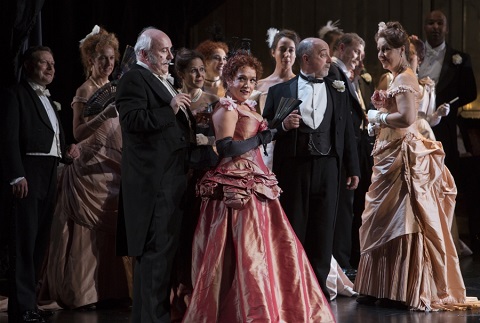 Philip Lloyd Evans (Marquis d’Obginy), Rebecca Afonwy-Jones (Flora) and WNO Chorus. Photo credit: Betina Skovbro.
Philip Lloyd Evans (Marquis d’Obginy), Rebecca Afonwy-Jones (Flora) and WNO Chorus. Photo credit: Betina Skovbro.
If the choral crowd are sometimes a little static - though hearty of voice - then individuals are brought to the fore. James Cleverton’s resounding Baron Douphol watches the nascent courtship from the front of the stage isolated from the other carousers’ carnality and excess by his jealousy and anger. Sian Meinir’s Annina hovers watchfully; Flora’s indigo-blue frock gleams as richly as Rebecca Afonwy-Jones mezzo-soprano and as brightly as her smile.
Then, suddenly Violetta and Alfredo find themselves alone; the viewer is disorientated by the change of perspective, sucked into their intimacy. Kang Wang’s evening-dress looks a little on the large size but his voice is stylish and secure, if lacking in a really Italianate warmth and ring at the top. Anush Hovhannisyan is taking the role of Violetta in the two Southampton performances; her soprano perhaps does not have the fullness of tone and nuance of colour to really engage our sympathies but the Armenian soprano has undeniable theatrical presence, and she worked hard to communicate Violetta’s determination and courage, as well as to intimate her frailty - no easy task when vocally the singer in the role must be so robust and sparkling. Hovhannisyan may sometimes have only found a secure line upon the repetition of a vocal phrase, but she has a lovely way of withdrawing the note at the top to convey fragility and femininity - and who would begrudge her repetition of this winning gesture.
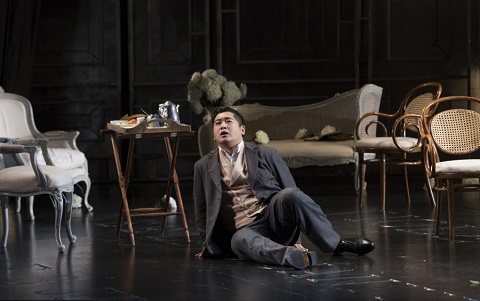 Kang Wang (Alfredo). Photo credit: Betina Skovbro.
Kang Wang (Alfredo). Photo credit: Betina Skovbro.
Act 2 finds Violetta prone on her bed, the stage divided by a the curving hoops of a half-lowered curtain revealing first the lovers’ bedroom, the shadows looming like ghosts, and then, with a balletic swish, the brightly lit, gracious ante-room in which Violetta awaits her visitors. If Act 2 is fired by a greater intensity and truly compelling dramatic momentum, then this is in no small part due to Roland Wood’s gripping Giorgio Germont. Wood’s baritone imposes itself with wonderfully supercilious smoothness and colour, matching the contemptuous condescension of his gestures - the lifting of frilled layer of Violetta’s dress with his cane, as he sneers about the extravagance of life is the apex of arrogance. Wood’s encounters first with Violetta and then with his son in this Act are both menacing and moving. His iron-rod back, as he refuses to take the open-hearted Violetta in his arms, as a daughter, is chilling.
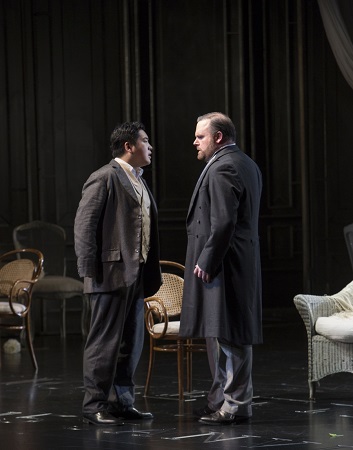 Kang Wang (Alfredo) and Roland Wood (Giorgio Germont). Photo credit: Betina Skovbro.
Kang Wang (Alfredo) and Roland Wood (Giorgio Germont). Photo credit: Betina Skovbro.
Back in Paris, the excitement at Alfredo’s luck at cards is matched by the exuberance of the gypsy dancers’ displays; and the entertainment cleverly integrates the themes of class and money, as Philip Lloyd-Evans’ oily Marquis d’Obigny shoves some crumpled louis down the cleavage of one of the can-can girls, and a male ‘matador’ scrabbles on the floor for the revellers’ carelessly thrown loose notes. Later there is a terrible desperation and degradation when Alfredo (inelegant in out-sized suit) showers his gambling profits at the horrified over the salon marble, insulting and intimidating Violetta, who shrinks under his scornful, spiteful retort that he has now repaid his debts. Again, some of choral blocking is a little staid: when towards end of chorus, Flora ventures forward to comfort Violetta and is restrained by the Marquis, one wishes that McVicar had integrated more such telling details. Similarly at the close of the scene, the principals too are static, strung out along the front of stage - a little disengaging in their spatial isolation and stillness, with Pere Germont seated exhaustedly stage-right, Alfredo slumped on floor centre-stage, and Violetta standing, just, stage-left.
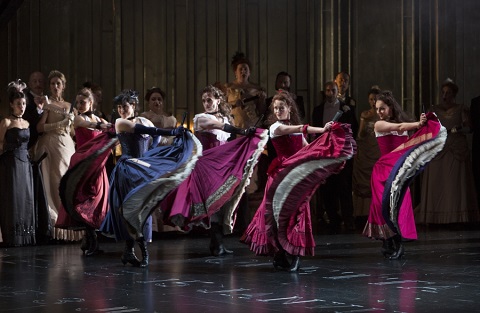 WNO Dancers and WNO Chorus. Photo credit: Betina Skovbro.
WNO Dancers and WNO Chorus. Photo credit: Betina Skovbro.
Hovhannisyan comes into her own in the last Act much of which she delivers while horizontal on bed or floor, but with dramatic magnetism and vocal focus, her opening agonises accompanied with beautifully shaped violin accompaniment. Violetta’s fervent grasping, with faux optimism, at the arm of Martin Lloyd’s pragmatic Grencil recalls the superficiality of her earlier merriments. Past and present are fusing: when, Germont arrives to embrace her as a daughter, Violetta’s cry, “It is too late!”, is visually reinforced by the terrible funereal darkness and erasure of colour and warmth - even the meagre fire is extinguished, as Violetta’s heart essays its final flickers.
Conductor James Southall had kept a tight rein on the Welsh National Opera Orchestra up until this point, taking care that in the Mayflower ‘barn’ they did not overwhelm the singers. But, now the rat-a-tat of trombones was a spine-curdling knock of Death. One could only hope that T.S. Eliot was right when he professed that ‘to make an end is to make a beginning./ The end is where we start from.’
Claire Seymour
Verdi: La Traviata
Violetta - Anush Hovhannisyan, Alfredo - Kang Wang, Germont - Roland Wood, Flora - Rebecca Afonwy-Jones, Baron Douphol - James Cleverton, Marquis d’Obigny - Philip Lloyd-Evans, Annina - Sian Meinir, Doctor Grenvil - Martin Lloyd, Gaston - Howard Kirk, The Messenger - George Newton-Fitzgerald, Flora’s Servant - Laurence Cole, Dancers/Actors (Colm Seery, Darío Sanz Yagüe, Ashley Bain, Mori Bonet, Lucy Burns, María Comes Sampredo, Lauren Wilson; Director - David McVicar (revival director - Sarah Crisp), Conductor - James Southall, Designer - Tanya McCallin, Lighting Designer - Jennifer Tipton (realised on tour by Benjamin Naylor), Choreographer - Andrew George, Chorus and Orchestra of English National Opera.
Mayflower Theatre, Southampton; Wednesday 21st November 2018.
image=http://www.operatoday.com/La%20traviata%20Kang%20Wang%20Alfredo%20and%20Linda%20Richardson%20Violetta%20Photo%20credit%20Betina%20Skovbro.jpg image_description= product=yes product_title=Welsh National Opera’s La traviata, at the Mayflower Theatre, Southampton product_by=A review by Claire Seymour product_id=Above: Kang Wang (Alfredo) and Linda Richardson (Violetta)Photo credit: Betina Skovbro
Hubert Parry – Father of Modern English Song – English Lyrics III
By extension this also serves to highlight Parry's unique role in British music history. Britain has strong literary traditions : composers like Purcell worked with playwrights like Dryden. British audiences were receptive to Handel because he wrote for the theatre. His oratorios, like Mendelssohn's, connected to the role of music in British religious culture. Hence the predilection for vocal music and for choral music in particular. British music is music for voice, either declaimed or sung. The situation isn't dissimilar to France or Italy where sacred music and opera dominated, and even in Germany and Austria, symphonic music in the modern sense didn't take root until the 18th century. So much for the myth of Das Land ohne Musik !
Because Parry's songs specifically address English art poetry, they mark a departure into new territory which would later be developed by composers like Vaughan Williams and others who sought out folk tradition and by by composers like Finzi, who addressed Tudor, Stuart and Restoration poetry. Notice Parry's term “English Lyrics”, focusing on English as a language. Parry's outlook was progressive, alert to contemporary European influences, which is no demerit, given the extremely high quality of 19th century Austro-German music. Effectively, he was the father of modern British music. Please read more here about Volume I in this series (settings of Shakespeare and 17th and 18th century poets) and about Volume II (where Parry sets poets of the 19th century, close to his own time, not unlike the way that Schubert, Schumann and others set Goethe and Heine.
My heart is like a singing bird dates from 1909, and was written for the soprano Agnes Hamilton Harty, (wife of the pianist Hamilton Harty). The lines fly and soar - like a songbird - and Sarah Fox's clear, lyrical singing does it justice. The text is Christina Rossetti's A Birthday. Extending the imagery, The Blackbird, If I might ride on puissant wing and A Moment of Farewell. The first is relatively straightforward but its very simplicity evokes the folk song adaptations that became popular in the Edwardian period. A Moment of Farewell, (to a poem by John Sturgis) however is more sophisticated with an elaborate, rolling piano line, (pianist Andrew West) evoking the “buoyant emotion” of a “bird flying far to the ocean”. With The Sound of Hidden Music, Parry is writing art song as fine as any German composer’s. The piano introduction flows elegantly, almost caressing Sarah Fox's lines. Although the poem, not specially adept, is by Julia Chatterton, unknown today, Parry's response lifts it well above the ordinary. The memory of “things of life that touch the heart are things we cannot see” warm the spirit in winter. It was signed on his 70th final birthday in 1918, inscribed with the words “Slowly and with deep feeling”. This was to be his last birthday, and final completed song. There is some evidence that he did not think he would live out the year, and indeed, he died some months later.
Just as Schubert set poems by people he knew, Parry chose poems by friends who meant a lot to him, which tells us much of his humane and caring personality. Nine of his seventy-four English Lyrics (eight included in this collection) are settings of John Sturgis, Parry's classmate at Eton and fellow student at Oxford. Like Parry himself, Sturgis was able to switch to art from business. Through the Ivory Gate describes a vision of a dead boyhood companion. “No friendship dies with death”, sings Roderick Williams, whose style of direct communication makes the song feel personal. A Stray Nymph of Dian, another Sturgis setting, describes a Grecian nymph, and draws from Parry a more declamatory approach. A Girl to her Glass is flirtatious, while Looking Backward is not melancholy - not a Parry characteristic - but thoughtful. Grapes is boisterous, as befits a paean to Bacchus. “Grapes, grapes, grapes beyond all measure!” sings Williams with good humour.
Alfred Perceval Graves, an Inspector of Schools, was well known in Victorian times. “I am weaving sweet violets, sweet white violets” sings Williams in A Lover's Garland. Parry's setting is elegant, reflecting the classical reference to “Heliodora's brow”. At the Hour the Long days Ends in lesser hands than Parry's might have veered close to parlour song, but he treats it with dignity. Graves's poem The Spirit of the Spring, with its references to Taunton town and archaic words like “maund” (a unit of weight) is quaint in an artificial way - he was no Housman or Hardy - but Parry, like Schubert, could elevate less than ideal verse with good musical setting.
The rather better poetry of Langdon Elwyn Mitchell inspired Parry to greater heights. Nightfall in Winter captures a sense of enveloping darkness. The piano plays single notes in succession, suggesting the steady coming of night, cold and frost. “The clouds obscure the sky with gloom”, sings Williams, his voice rising upwards for a moment before settling back into somnolent mood. Mitchell also wrote the text for From a City Window, one of Parry's best-known English lyrics. “I hear the feet below”, sings Sarah Fox, as West plays the bustling piano part, “(which) go on errands bitter or sweet whither I cannot know”. A long pause, for rumination before the second verse, “A bird troubles the night” evoking “vague memories of delight”. Another, shorter, pause before the final strophe “And the hurrying, restless feet below, on errands I cannot now, like a great tide ebb and flow”. A strikingly modern song, with its urban context and sense of unknown possibilities, the bird a symbol of longing yet disquiet. Although Parry's Twelve Sets of English Lyrics have been recorded before in various forms, this series from SOMM is a landmark because it presents the complete collection, together with good notes and good performances, establishing Parry's role as the pioneer of modern English song.
Anne Ozorio
image=http://www.operatoday.com/SOMMCD272-cover-1024x1024.jpg
image_description=SOMMCD 272
product=yes
product_title=Sir Ch. Hubert Parry : Twelve sets of English Lyrics, Volume III
product_by=Sarah Fox, Roderick Williams, Andrew West, SOMM Recordings.
product_id=SOMM Recordings SOMMCD 272 [CD]
price=$18.99
product_url=https://amzn.to/2S4PU0j
Ravel’s Magical Glimpses into the World of Children
I loved vol. 4, whose main work was Ravel’s first opera, L’heure espagnole. Conductor Denève has, in the meantime, has become an ever-more-prominent figure on the world scene: during the 2019-20 season he will become music director of the Saint Louis Symphony Orchestra, after some years as Chief Conductor of the Stuttgart orchestra heard here, as Music Director of the Brussels Philharmonic, and as Principal Guest Conductor of the Philadelphia Orchestra. Denève has an interest in exploring new and forgotten repertoire: he recorded operas by Dukas and Prokofieff, as well as numerous works by Roussel.
The longer of the two works on this CD is the second of Ravel’s two operas (both of which are in a single act lasting less than an hour). Its title, impossible to translate, means something like “The Child and the Magical Things that Start to Happen to Him.” The opera consists of a series of very short scenes, in which a young boy, unnamed, refuses to do his schoolwork, taunts animals, breaks household objects, rips illustrated characters out of the wallpaper and his storybook, gets chastised by Mommy, then (I am interpreting a bit from this point on) falls asleep and dreams of the various objects, animals, and illustrated characters that he has mistreated in his waking life. They sing and dance and accuse, and he begins to understand. Finally, he binds (or dreams that he binds) the wounds of the squirrel that he has injured and calls out to his Mommy. Animals of the fields, concerned, take up his powerful cry, and the child, apparently now back from dreams, turns toward his mother and stretches out his arms.
The verses, written by the popular fiction-writer Colette, are inventive and full of subtle humor, mystery, and touches of violence—as well as much imitation of animal noises plus some pidgin English and Chinese. Ravel’s music is enchanting beyond description: a kaleidoscopic survey of musical styles, from sacred-choral to cheeky foxtrot and Piaf-like cabaret waltz (several years before Piaf began her career). L’enfant et les sortilèges is hard to stage, both for dramaturgical reasons and for musical ones—especially in a large hall, in which the frequent quick vocal patter and much of the orchestral tracery can get lost. But it is a delight to listen to on CD.
There have been numerous much-admired recordings: I join other critics in recommending the earliest one (1947, conducted by Ernest Bour) and the modern versions conducted by, most notably, Maazel, Previn, Jordan, and Rattle. (Ansermet’s recording, though somewhat uneven, also has splendid assets.) To these can now be added the fine rendering by Denève and the Stuttgart Orchestra, recorded in 2015. The vocal soloists are all native French-speakers, which helps enormously, especially when the text has to be spit out quickly (e.g., by the tenor who plays “The Little Old Man”: this character is the embodiment of the rules of arithmetic that the boy has refused to learn). They all sing with firm tone and with little or no wobble. The best-known of the singers, Annick Massis, has performed leading operatic roles (e.g., Lucia and Violetta) in major houses. In my aforementioned review of Denève’s vol. 4, I admired Paul Gay’s performance of the role of Don Iñigo Gomez.
The two participating choruses handle the French text beautifully. The innocent quality of the Karlsruhe Youth Chorus adds immeasurably to the final minutes of the work. The orchestral playing ravishes the ear.
Throughout the opera, the recorded quality is balanced and true, inviting you to listen attentively and rewarding you for doing so. The music flows with a natural lilt and lift. I wouldn’t want a single detail to be different, though some things are of course done differently on other recordings and are no less convincing there. (Late update: yet another first-rate recording of the opera has just been released, conducted by Mikko Franck: see the review here.)
The five “Mother Goose” pieces that complete the CD were recorded in the same hall (the Beethoven-Saal of Stuttgart’s Liederhalle) during a 2013 concert rather than under studio conditions. The sonics here, too, are remarkably detailed. The audience members are as quiet as church mice and, I suspect, deep in concentration—that’s how engaging the music-making is. They applaud vociferously at the end. A few quick wind passages are not perfectly rendered, but the advantages of a live performance here outweigh the small disadvantages, revealing how fine the SWR Orchestra is “in real time,” at least when led by the man who was their Chief Conductor for seven years (2005-12).
On the outside of the box, the title of this orchestral work is. astonishingly, mistranslated into German as Meine Mutter, die Gans , i.e., “My Mother, the Goose”! Fortunately, the English translation of the informative booklet essay is well handled, except that, in the cast list for the opera, it leaves Bergère untranslated. The word does not, here, mean a shepherdess (as some might assume) but a small upholstered armchair or loveseat. (As I said, furniture sings in this opera—long before a certain Disney movie.)
The booklet includes no libretto for the opera. An imaginatively updated singing translation in English is here.
How lucky the folks in St. Louis are going to be to have a conductor with such a fine sense of atmosphere, pacing, and color!
Ralph P. Locke
The above review is a lightly revised version of one that first appeared in American Record Guide and appears here by kind permission.
Ralph P. Locke is emeritus professor of musicology at the University of Rochester’s Eastman School of Music. Six of his articles have won the ASCAP-Deems Taylor Award for excellence in writing about music. His most recent two books are Musical Exoticism: Images and Reflections and Music and the Exotic from the Renaissance to Mozart (both Cambridge University Press). Both are now available in paperback, and the second is also available as an e-book. image=http://www.operatoday.com/Ravel-Orch-Works-5.jpg image_description= product=yes product_title=Ravel: L’enfant et les sortilèges; Debussy: Ma Mère l’Oye (five pieces) product_by=Camille Poul (Child), Annick Massis (Fire, Princess, Nightingale), Maïlys de Villoutreys (Shepherdess, Bat, Owl), Marie Marall (Mother, Chinese Cup, Dragonfly), Julie Pasturaud (Small Upholstered Seat, Shepherd, Female Cat, Squirrel), François Piolino (English Teapot, Little Old Man, Tree-Frog), Marc Barrard (Grandfather Clock, Male Cat), Paul Gay (Large Wooden-Armed Chair, A Tree), Stuttgart Radio Orchestra, SWR Vocal Ensemble, Cantus Juvenum Karlsruhe, conducted by Stéphane Denève product_id=SWR Music 19033—62 minutes
About an enfant: Ravel’s Opera about Childhood and Debussy’s Prodigal Son
The only thing I minded were some inconsistencies of tuning in the opening two minutes and at the very end. The detailed sonics lack some of the mystery that Stéphane Denève brings out so well at various points in the studio recording of the work, reviewed here. But the clarity of detail also brings ample compensation. The music is conducted with keen stylistic awareness by Mikko Franck, music director of the French radio orchestra that is heard here (and former music director of the Finnish National Opera).
There will probably never be an absolute “best” recording of this remarkable work. It has twenty singing roles divided among eight or so singers, all in a work that lasts some 43 minutes. Characters rarely sing at the same time, and some passages are choral or orchestral. Thus, as simple arithmetic tells us, each role contains only a few minutes of singing!
The singers on this recording characterize their various roles vividly and, in a few cases (Grandfather Clock, Fire), are more precise with the pitches and articulation than are the singers in the Denève recording. I was surprised that the two singers who participate in both the Denève recording and this one (Pasturaud and Piolino) seem even more in command in this concert recording than they already were when they had the advantage of studio conditions and the possibility of multiple retakes. Perhaps the presence of an audience that could understand, without supertitles, the nuances of the text that was being sung, made a difference.
The discovery for me is Sabine Devieilhe, as Fire, Princess, and Nightingale. Her coloratura singing is as close to perfection as humanly possible. Her lyrical singing is no less wondrous. I hope to hear her in much other repertoire soon. (I have read praise of her three recital discs for the French firm Erato.) I must also praise three of the other singers who, like Devieilhe, were not on the Denève recording. The renowned Nathalie Stutzmann brings enormous warmth and seeming spontaneity to her three roles. Jean-François Lapointe takes care to sing, not talk-sing, Grandfather Clock. And, as the Child, Chloé Briot reveals her impressively diverse vocal abilities ever more as the opera unfolds. (Briot has a touch of wobble on sustained notes, but is otherwise perhaps the best Child on any recording.) The four “animals” who speak, near the end of the opera, are members of the French Radio Chorus, and the booklet nicely names them. They do their lines superbly.
The libretto is given complete, including the extensive stage directions, all in the superb old Felix Aprahamian translation. But the latter could use a bit of updating or clarification by now. For example, the character known as La Bergère is translated as The Sofa, which seems to imply a largish object. But the stage directions make clear that this piece of upholstered furniture is smaller than the big armchair (Le Fauteuil, sung by a bass), which of course is why Ravel assigns the role to a higher voice (mezzo-soprano). Perhaps we might call it (or her) a “Small Upholstered Seat.”
In addition to famous older recordings (see the previous review), I should add that there are two different Glyndebourne DVD versions of this opera. Both pair the work with Ravel’s first opera, L’heure espagnole, and both are apparently wonderful in different ways.
The opera comes as part of a 2-CD set, with two works by Debussy. One is another “child” work: Debussy’s The Prodigal Son (1884). Of course, this child is fully grown, for the story is the one in Luke 18 about a son who has left his father and brother and wasted his inheritance, then returns and is forgiven. The other work is a little-known early symphonic movement.
There is much less recorded competition for the Debussy cantata (or, in its alternate title, “operatic scene”) than for Ravel’s opera. And for good reason: it’s an early work, composed to please the professors at the Conservatoire and help win Debussy the Prix de Rome. (It succeeded!) Debussy was pleased enough with it to allow it to be published twenty-four years later. Still, whole chunks of it sound highly conventional. My favorite passage is the opening prelude, which is clearly meant to sound exotic—in the manner of Rimsky-Korsakov, Borodin, and Balakirev—so as to place the listener in the ancient Middle East.
Whatever the mixed merits of the piece itself, the singing here is magnificent, as one might expect from a project that includes the renowned Roberto Alagna (as the Son). The soprano, Karina Gauvin, sings the role of the mother to perfection. I had heard of Gauvin and will now look for other recordings by her. Lia’s aria, the first vocal number in the work, has been often recorded separately, but surely never better. The famous “Cortège et air de danse,” a self-enclosed orchestral piece likewise sometimes performed apart from the cantata, beautifully conveys the graciousness of family and community life from which the wastrel Azaël has chosen to absent himself.
The vivid sonics capture every detail of this concert performance of L’enfant prodigue. The booklet gives an antiquated singing translation that takes some effort to decode.
There have been at least three previous recordings, including a monophonic one featuring an exemplary French tenor, Henri Legay, and a much more recent one that is part of a 2-CD set of Debussy’s various Prix de Rome compositions, conducted by Hervé Niquet. (The latter set, which comes with a small book, is sponsored by the enterprising Center for French Romantic Music, located at the Palazzetto Bru Zane in Venice.) The best known recording is a 1982 release conducted by Gary Bertini and featuring Jessye Norman, José Carreras, and Dietrich Fischer-Dieskau, all in splendid voice. But I am nearly always happier hearing Francophones singing French, as in the new recording.
The early Debussy symphonic movement in B minor survives only as a piece for piano four-hands and has been recorded several times in that guise. There is no evidence that Debussy ever got around to orchestrating it. The style is remarkably varied: its opening is surprisingly Brahmsian. (For further description, see the chapter that I wrote on French symphonies in the book The Nineteenth-Century Symphony, ed. D. Kern Holoman.) Here the movement is heard in a somewhat dense but workable orchestration by Colin Matthews, conducted rather straightforwardly by Franck. (Naxos has released a recording that uses an orchestration, by American composer-arranger Tony Finno, that feels more playful and exploratory than the Matthews. Finno’s version is made particularly attractive by conductor Jun Märkl’s frequent and apt-feeling changes of tempo.)
The Erato 2-CD set is available at the price of a single CD. It thus represents a remarkable bargain, and nobody will regret snapping it up. If you have never encountered Ravel’s L’enfant et les sortilèges, I suggest that you treat yourself to this recording, or to any of the aforementioned ones (including, by all means, the atmospheric Denève). But make sure you read the delightful libretto and detailed stage directions--either beforehand or while listening.
Ralph P. Locke
The above review is a lightly revised version of one that first appeared in American Record Guide and appears here by kind permission.
Ralph P. Locke is emeritus professor of musicology at the University of Rochester’s Eastman School of Music. Six of his articles have won the ASCAP-Deems Taylor Award for excellence in writing about music. His most recent two books are Musical Exoticism: Images and Reflections and Music and the Exotic from the Renaissance to Mozart (both Cambridge University Press). Both are now available in paperback, and the second is also available as an e-book.
image=http://www.operatoday.com/Warner_Debussy_Ravel_CD_Cover_LG_05B.jpg image_description= product=yes product_title=Ravel: L’enfant et les sortilèges; Debussy: L’enfant prodigue, Symphony movement in B Minor (here called Finale) product_by=Ravel: Chloé Briot (Child), Nathalie Stutzmann (Mother, Chinese Cup, Dragonfly), Sabine Devieilhe (Fire, Princess, Nightingale), Jodie Devos (Bat, Owl, Shepherdess), Julie Pasturaud (Small Upholstered Seat, Female Cat, Shepherd), Francois Piolino (English Teapot, Little Old Man, Tree-Frog), Jean-Francois Lapointe (Male Cat, Grandfather Clock), Nicolas Courjat (Wooden-Armed Armchair, Tree)Debussy: Karina Gauvin (Lia), Roberto Alagna (Azaël), Jean-Francois Lapointe (Siméon), French Radio Chorus, Children’s Chorus, and Orchestra, conducted by Mikko Franck product_id= Erato 9029 589692 [2 CDs] 89 minutes
November 21, 2018
'So sweet is the pain': Roberta Invernizzi at Wigmore Hall
Invernizzi and her instrumental partners - lutenists Craig Marchitelli and Franco Pavan, and viola da gamba player Rodney Prada - began with two solo madrigals by Caccini. It took a little time for the musicians to settle, the sparse lute textures of the opening of ‘Dolcissimo sospiro’ (Most gentle sigh) providing only the mildest anchor for the voice, while the piquant chromaticism freed the vocal line still further. But, Invernizzi did not compromise the purity of her tone, floating dreamily. The entry of the viola da gamba underpinned the tangibility of the ‘sweet pain’ and drama accrued at the close, with a sudden injection of fleetness at the protagonist’s self-chastisement for futilely addressing a rambling sigh that would surely fly off to another’s heart - ‘Ad un sospiro errante/ Che forse vola in sen ad altro amante’.
All the qualities that would make this such an enthralling recital were present in this song. Invernizzi contrasted a ‘clean’, sincere sound, employing little vibrato, with richer colours, rippling through a musical or textual gesture to indicate a surge of anger or pain. Dynamic contrasts were similarly emotive and enhanced by vocal exclamations. Ornamentation was restrained, ensuring the listener’s engagement with the text, but the decoration of sustained notes was beautiful, and complemented by virtuosic diminutions and gestural flourishes in the accompanying parts. Most notable, though, was Invernizzi’s phrasing. She was responsive to the harmonic insinuations, bringing musical phrase, text and chromatic nuance together in a flexible line, often ‘bending’ the pitch towards a particular note or syllable and so blending the pain and pleasure which are the essence of these songs.
Caccini’s strophic dance ‘Dalla porta d’Oriente’ (From the gateway to the East) tripped along freely, until an affective rallentando at the close conveyed the suffering of the dawn sky, whose colorific splendour is paled by the fire of rubies that burns in two lovers’ hearts, an extravagant lute flourish sharpening the bitter tears which infuse the ‘roseo manto’ (rosy mantle).
It was good to hear some rarer songs too. Tarquinio Merula’s ‘Folle è ben che si crede’ (He is indeed mad, the man who believes’ was a droll protestation of fidelity, the final repetition of the stanzas’ indifferent refrain - ‘Dica chi vuole,/ dica chi sa’ (Let them speak who want to,/ let them speak who know’ - thrown away with an insouciant wry shrug. Luigi Rossi’s ‘La bella più bella’ (The most wondrous beauty) sparkled with the flightiness of the woman who vanishes abruptly from a sleeper’s dream, before the wriggling vocal line revealed his self-indulgent revelling in the piercing pains of love. The winding vocal line of Sigismondo d’India’s ‘Intenerite voi, lagrime mie’ (Move to pity, my tears) fired chromatic darts of pain, twisting and burning; the composer’s ‘Crud’Amarilli’ (Cruel Amarilli) was more pensive, submitting in crushed resignation in the final two lines, ‘Poi che col dir t’offendo,/ I’ mi morrò tacendo’ (and by saying this I offend you,/to my death silent will I go’).
The music of Monteverdi was the heart of the recital. ‘Ecco di dolci raggi il sol armato’ (See the sun armed with gentle rays) was a drama of fire and ice, the arioso fluid and seemingly spontaneous. A lovely bloom was followed by the soft diminishment of the voice at the close of ‘Si dolce è’l tormento’ (So sweet is the pain) to convey first the ardent lover’s unrequited passion, then his bitter resignation: ‘Ben fi ache dolente/Pentita e languente/Sospirami un dì’ (let her one day, repentant and languishing, suffer and yearn for me) ‘Disprezzata regina’ from L’incorozanione di Poppea was gripping, as Invernizzi communicated all the theatre of the rejected Ottavia’s emotional rollercoaster, in which, vulnerable and confused, she grieves for lost love (‘Dove, ohimè, dover sei’; hurls her anger at her evil deserter, ‘empio Nerone’; and imagines her tears reflecting her husband’s sensuous delights mingled with her own distress, the slippery chromatic line culminating in a delicious slow trill.
Woven between the vocal items were instrumental toccatas and passacaglias. In a passacaglia by Giovanni Kapsberger, the contrasting musical characters of the two lutenists made for an engaging duet discourse, as Marchitelli, more extrovert, leaned over his chitarrone towards Pavan, as the initial mood of gentle intimation and mystery became invigored with stronger animation and definition. Kaspberger’s Toccata Arpeggiata (from Libro I d’intavolatura di chitarrone) was rhythmically playful and impulsive, retreating to a whispered pianissimo and then, just when the threads of sound seemed about to disappear, propulsively swelling once more. Rodney Prada roved across the full range of his viola da gamba in Orazio Bassani’s Tocatta per B Quadro, producing a full, juicy bass tone, while in a Canzone by Giralomo Frescobaldi an engaging discourse ensued between the sweet, decorative melody of the viola da gamba and the vigorously brushed chords of the lutenists.
Invernizzi returned to Caccini at the close, offering one of the best-known madrigals of the period, the composer’s ‘Amarilli, mia bella’, as her encore. Once again, one marvelled at her declamatory technique and style, which gave such life to the fictional poet-singer that one could believe he was indeed present in Wigmore Hall.
Claire Seymour
Roberta Invernizzi (soprano), Rodney Prada (viola da gamba), Craig Marchitelli (lute), Franco Pavan (lute)
Caccini - ‘Dolcissimo sospiro’, ‘Dalla porta d’oriente’; Kapsberger - Passacaglia; Monteverdi - ‘Ecco di dolci raggi il sol armato’, ‘Disprezzata Regina’ (from L’incoronazione di Poppea); Bassani - Toccata per B Quadro; Frescobaldi - Canzone a basso solo; Merula - ‘Folle è ben che si crede’; Rossi - ‘La bella più bella’; Kapsberger - Toccata Arpeggiata from Libro I d’intavolatura di chitarrone; d’India - ‘Intenerite voi, lagrime mie’, ‘Cruda Amarilli’; Monteverdi - ‘Sí dolce è’l tormento’, ‘Voglio di vita uscir’.
Wigmore Hall, London; Monday 19th November 2018.
image=http://www.operatoday.com/Roberta%20Invernizzi%20Davide%20Capelli%20.jpg
image_description=
product=yes
product_title=Roberta Invernizzi, at Wigmore Hall (BBC Radio 3 Lunchtime Concert)
product_by=A review by Claire Seymour
product_id=Above: Roberta Invernizzi
Photo credit: Davide Capelli
November 19, 2018
Staging Britten's War Requiem
The words of Benjamin Britten in his speech, On Receiving the First Aspen Award, on 31st July 1964, two years after the premiere of the composer’s War Requiem on 30 th May 1962 in Coventry Cathedral, the destruction, rebirth and consecration of which the work was commissioned to commemorate and celebrate.
Interestingly, in his Aspen Award speech Britten also reflected upon what he called the ‘so-called “permanent” value of our occasional music’, noting that we should not worry too much as, ‘A lot of it cannot make much sense after its first performance, and it is quite a good thing to please people, even if only for today’. And, pragmatically Britten observed, ‘One must face the fact today that the vast majority of musical performances take place as far away from the original as it is possible to imagine’.
There have, inevitably, been numerous performances of Britten’s War Requiem this year, some in gothic cathedrals, others in venues of diverse function, form and acoustic. English National Opera’s Artistic Director Daniel Kramer and Turner Prize-winning artist Wolfgang Tillmans have now brought the War Requiem into the opera house and placed it upon the theatrical stage. In so doing, they continue the trend for staging Passions, oratorios and Requiem masses which has seen Deborah Warner, Peter Sellars, Jonathan Millar, Calixto Bieito et al attempt to make ‘drama’ from ritual and liturgy.
Britten’s War Requiem captured the sentiments of a world reeling with the grief of a century of war. Britten spoke in his Aspen Award speech of the ‘many times in history the artist has made a conscious effort to speak with the voice of the people’. His belief that it was the responsibility of the creative artist to communicate directly to society was expressed time and again: in his speeches on receiving the Freedom of the Borough of Aldeburgh and on Receiving Honorary Degree at Hull University’, both in 1962, for example.
But, the Requiem is many things. It is a public statement of the composer’s own pacifism, prompting our understanding that war does not cease when warring nations put down their guns. It is also a homage to Wilfred Owen, whom Britten described as ‘by far our greatest war poet, and one of the most original and touching poets of this century’. Britten scholar Philip Reed has suggested that what Britten admired was the directness of Owen’s poetry and the fact that it highlighted the ‘ironic conflict of verbal and musical messages’ when juxtaposed with the Latin Requiem text.
So, in additional to the verbal and musical messages, do we need visual images too? What will they add, diminish, change?
Essentially, Kramer’s and Tillmans’ War Requiem is a series of such visual images, presented with technological slickness and potently lit by Charles Balfour. None of these images are inappropriate; some, in my view at least, are somewhat hackneyed; some are striking.
Kramer and Tillmans begin with reference to a visually driven narrative which was designed to bring about social and cultural change. Two halves of an open book tower over and straddle the stage in the ‘Requiem aeternam’. The pages of Ernst Friedrich’s War Against War flick over, exposing the captions and photographs which the young German - an anarchist and anti-militarist activist who had been incarcerated during WW1 for his refusal to fight - intended to unmask nationalistic propaganda and lay bare the false narratives of militaristic rhetoric. Disfigured faces - ‘The Visage of War’ - stare at us, as we stare at them: through such visual activism Friedrich aimed to challenge politically correct ‘ways of seeing’ and create an experienced, rather than imagined, intimacy between viewer and viewed.
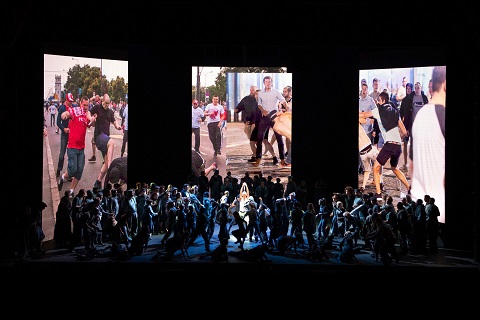 Roderick Williams and Ensemble. Photo credit: Richard Hubert Smith.
Roderick Williams and Ensemble. Photo credit: Richard Hubert Smith.
But, the pages of the book turn quickly, evading our gaze, and are succeeded by images of other conflicts, horrors and inhumanity. During the ‘Liber scriptus proferetur’, a poster, ‘Breaking the Silence: Gender and Genocide’, urges us to remember the massacre in Srebenica in 1995. Then, the uniforms are of a different kind of patriotic allegiance as bottle-throwing football thugs march through the streets. Monochrome photographs of the ruined shards of Coventry Cathedral remind us of the origins of the work - composed in the aftermath of another world war, and at the height of the Cold War with the threat of nuclear conflict terrifyingly real - and of Britten’s remark, made during rehearsal for the 1963 Decca recording, that the ‘Libera Me’ “happens today to mean something”.
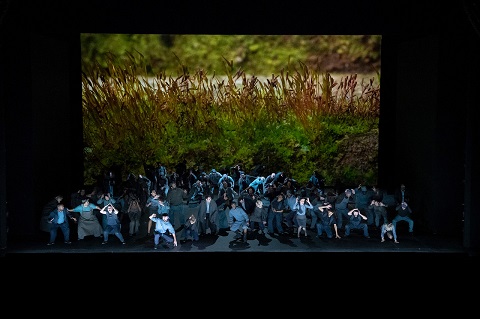 Photo credit: Richard Hubert Smith.
Photo credit: Richard Hubert Smith.
Juxtaposed with man’s inhumanity are nature’s cycles of decay, death and renewal. The camera scrutinises the stripped bark of a fallen tree trunk as it sheds its protective skin, skims sea-surf scummy with pollution, and hugs a ground embraced by ferns and moss. A cloud of snow explodes, bringing another war poem by Owen to mind, with its image of ‘air that shudders black with snow’. The snow-dust blankets the stage - assuaging and beneficent, or hostile to man who has negated nature and alienated himself from its nurture?
There are some moments where image, word and movement are brought together. ‘So Abram rose’ and the ‘Quam olim Abrahae’ are illustrated by an aerial shot of a sacrificial sheep, as tenor David Butt Philip, dressed in an officer’s great-coat, oversees a procession children: lambs to the slaughter, indeed, or as Owen bitterly describes, ‘men who die like cattle’.
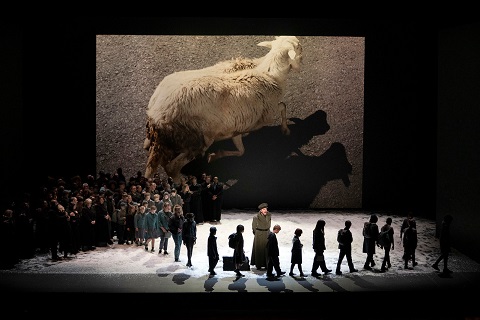 Photo credit: Richard Hubert Smith.
Photo credit: Richard Hubert Smith.
When asked about the ‘sweetness’ of the War Requiem’s final pages, in an interview with Charles Osbourne in 1963, Britten responded, “I can’t see any great defect in sweetness as long as it’s not weakness”. At the close, Kramer and Tillmans open a window on dense, verdant leaves of renewal, though the lingering agitations of the side drum and snares seem more in keeping with the ambivalent questions of Owen’s poem ‘The End’: ‘Shall Life renew these bodies? Of a truth/All death will He annul, all tears assuage?’
The choreography of the enlarged ranks of the ENO Chorus - who sang with fervency and impact - offers no surprises. They lie motionless, are marshalled in ranks, they march, they mourn. They, and the projected images, don’t ‘show’ us anything that we can’t already hear. Fluctuating grey-green fogginess backlights the ‘Libera me’, but we can hear the cacophonous slaughter in the violence of the percussion and, later, in the quasi-hysterical eruptions of the ‘Dies irae’. Moreover, the power of the customary spatial separation of the three ‘strata’ of the War Requiem - with the two soldiers exposed in the foreground, the liturgical consolations of the soprano and full chorus behind them, and the innocence of the children’s choir placed at an unreachable remove - is lost; as is the contrast between the chamber orchestra and full symphony, though the ENO Orchestra gave us clanging colours and vivid textures, and conductor Martyn Brabbins successfully balanced spaciousness and intensity.
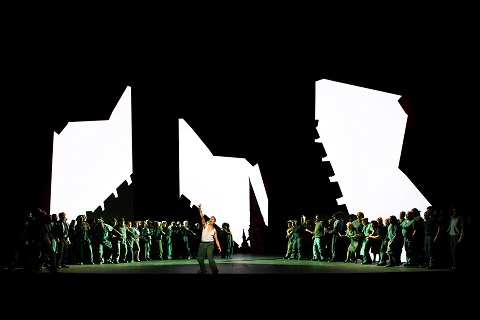 Roderick Williams and Ensemble. Photo credit: Richard Hubert Smith.
Roderick Williams and Ensemble. Photo credit: Richard Hubert Smith.
The members of Finchley Children’s Music Group were well-regimented choreographically and vocally spick and span. Emma Bell’s vivid but sometimes overly feverish rendition of the soprano solos offered few of the consolations that we might expect of a celebrant of the Mass. But, tenor David Butt Philip and baritone Roderick Williams both gave committed and musically affecting performances.
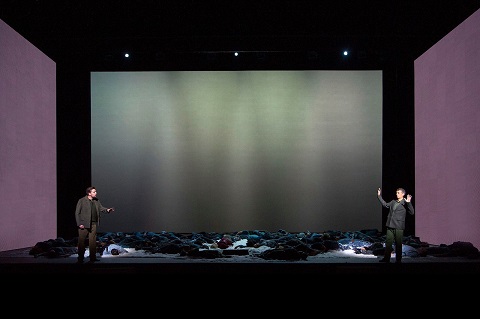 Roderick Williams and David Butt Philip. Photo credit: Richard Hubert Smith.
Roderick Williams and David Butt Philip. Photo credit: Richard Hubert Smith.
The most powerful moments are those of stillness and simplicity. After some uncomfortable music-hall style gestures in ‘Out there, we’ve walked quite friendly up to Death’, which weakened the irony inherent in the music, Butt Philip and Williams stood motionless in ‘Strange Meeting’, freed from the horrors of the battlefields they have left behind but trapped, restless, in a mysterious nightmare. The strength of Butt Philip’s tone betrayed all of the dead soldier’s bewilderment and disillusion, while Williams’ gentleness accommodated both the bitterness and pity of the counterpart who rises from the piles of languishing souls and whose ‘dead smile’ expresses his wry recognition of the futility of war: ‘I am the enemy you killed, my friend.[…]/ Yesterday through me as you jabbed and killed./ I parried; but my hands were loath and cold./ Let us sleep now …’.
Here, surely, was the place for Friedrich’s mutilated men for whom there are no ‘friends/enemies’ or ‘us/them’, only victim-soldiers, and whose shattered bodies and faces short-circuit conventional oppositional narratives of conflict?
Kramer and Tillmans demonstrate care and respect for Britten’s work, but the result feels oddly passive and distanced. And, they risk, in their emphasis on the visual at the expense of the verbal and musical, turning the War Requiem into a film score.
Claire Seymour
Britten: War Requiem
Emma Bell (soprano), David Butt Philip (tenor), Roderick Williams (baritone); Daniel Kramer (director), Martyn Brabbins (conductor), Wolfgang Tillmans (designer), Nasir Mazhar (costume designer), Justin Nardella (associate designer, Charles Balfour (lighting designer), Ann Yee (choreographer), ENO Orchestra and Chorus, Finchley Children’s Music Group, Sylvia Young Theatre School.
English National Opera, Coliseum, London; Friday 16th November 2018.
image=http://www.operatoday.com/Friedrich.jpg image_description= product=yes product_title=Britten’s War Requiem, English National Opera product_by=A review by Claire Seymour product_id=Above: Ensemble, War RequiemPhoto credit: Richard Hubert Smith
November 18, 2018
Halévy’s Magnificent La reine de Chypre (1841) Gets Its Long-Awaited World Premiere Recording
La reine de Chypre , in its day, was one of the most successful examples of French grand opera, a genre that produced, among other masterpieces, Meyerbeer’s Le prophète and Verdi’s Don Carlos. Ever since the work’s premiere at the Paris Opéra in 1841, noted musicians and commentators, including Berlioz and Wagner, have heaped praise on the work. (Wagner’s piano arrangement of the overture can be heard HERE.) Yet the work has, I believe, never been recorded before. At most a few excerpts are familiar from recordings, notably the tenor-baritone duet “Triste exilé,” which ends Act 3 to splendid effect , and which Berlioz described as being “penetrating in expression” and particularly “original” and “distinguished”--high praise from a composer whose own works are original almost to excess.
Wagner, in his late 20s, got to know La reine de Chypre well during a stay of more than two years in Paris, during which he earned much-needed cash by making a piano-vocal score of the work for its publisher. In two separate reviews of the work (one for a Paris journal, the other for a Dresden newspaper), the German composer drew attention to the work’s admirable (from his own point of view) avoidance of “all those intolerable prima donna ornaments” and predictable “fixed structures” that he felt were overused by “contemporary composers who aim for popularity come what may”. Berlioz, discussing the Act 5 duet between Catarina and Gérard, wrote: “The abiding ardent love and secret sorrow of these two wounded hearts are exceptionally well portrayed. Gérard’s solo in the minor, accompanied pianissimo by syncopated figures in the violins over a pizzicato in the basses . . . [amounts to a] desolate song, over an orchestra in the grip of a suffering barely able to contain its cry”. In our own day, Hugh J. Macdonald (in OxfordMusicOnline ) admires Halévy’s “craft in building big scenes and in engineering harmonic surprises” in the work.
Can any opera live up to such a reputation? Those who know and love Halévy’s even bigger hit, La juive, will probably answer: “Absolutely, yes!” They would be right. Moment after moment, this recording reveals a major opera composer capable of finding a fresh musical equivalent for each specific dramatic situation. And using means that are not at all as bombastic as one might expect from the generalized negative characterizations to which the genre of French Grand Opera has been subjected for a century and a half (most famously by Wagner himself at mid-career). I am almost tempted to think, now that I have lived with this recording, that Halévy was very much the equal of Meyerbeer in technique, and, in his best works, more consistently inventive and inspired.
The recording does not offer every possible passage of music that belongs to any version of the score; indeed, the work was constantly cut and altered by the composer himself in successive performances and revivals. (Details are given in the superb essays by Diana Hallman and others published in French and English in the elegant small book that comes with the recording.) But all the most striking and crucial scenes are present, some of them in versions fuller than were heard at the time. Volker Tosta prepared the version used here, drawing upon his complete critical edition, which is scheduled to be published by Nordstern Musikverlag (Stuttgart).
The plot contains elements that will sound familiar, not least from operas that came later. Cornaro, a young Venetian noblewoman, is entirely surrounded in the work by male characters, except for various mixed choruses of courtiers, peasants, and such. (Verdi’s Ernani, three years later, would feature a heroine similarly isolated.) The most important of these numerous men are the Frenchman Gérard de Coucy (whom she loves and who loves her), the intriguer Mocénigo (a member of Venice’s ruling Council of Ten), and the King of Cyprus (Jacques de Lusignan), to whom Mocénigo attempts to marry Catarina off. Indeed, Mocénigo, through threats, persuades Catarina to tell Gérard that she no longer loves him (much as will happen in La traviata, which was first performed in 1853).
Lusignan (in disguise) ends up saving Gérard’s life, and the two, after sharing parts of their stories (but not revealing their identities), join in the aforementioned “same-boat” duet that closes Act 3--a duet (and, indeed, scene) that will resonate 21 years later in a famous tenor/baritone duet in Verdi’s La forza del destino. At the opera’s end, Lusignan (poisoned by the Venetians) dies, but not before making it possible for the two lovers to unite and for Catarina to succeed him as ruler of Cyprus.
The performance, recorded primarily during a concert performance (and two previous days of read-throughs) in June 2017 in Paris’s famous Champs-Elysées Theater, is of consistently high quality. It helps that the singers are all, or nearly all, native French-speakers, as seems to be a (welcome) principle for the whole “French Opera” series. The participation of the ever-radiant, ever-soulful Véronique Gens, in the lone female role, ensures special interest on the part of lovers of French opera. The role lies a little low for her. Other singers will find ways to bear down with dark intent on certain phrases through which Gens moves somewhat briskly and lightly. But I hope they can also launch the many high-lying phrases with as much dignity and confidence as we hear here from Gens.
Cyrille Dubois is eloquent in timbre as Gérard de Coucy, taking some high notes softly, others full-voice yet without a hint of blare. As reported in the French press, Dubois stepped into the role on short notice. Future tenors who take on this role may bring yet more heft to it. Eric Huchet is witty and alert in the very word-oriented role of the nasty Mocénigo. Etienne Dupuis displays a velvety baritone in the role of Jacques de Lusignan. (I was reminded at times of Robert Merrill or Sherrill Milnes!) The smaller roles are all well taken (this is the fourth recent recording in which I have reveled in the sound of Artavazd Sargsyan’s sweet tenor), and the chorus is marvelous.
The orchestra is recorded with more presence and warmth than has been the case on some other recordings from the Center for French Romantic Music, allowing us to admire many details in the writing, such as brief, dramatic interjections from individual woodwind or brass instruments during tense discussions between characters. (The colorfully orchestrated ten-minute finale to Act 4 can be heard HERE.) I sometimes felt that conductor Niquet kept things moving a bit too metronomically: other conductors will surely want to enliven such spots with more (unwritten) accents and tempo modifications, as they normally do in many standard-repertory operas. I recently heard a new recording of Verdi’s Otello, conducted by Lawrence Foster, and found myself admiring it precisely for the way it avoided all kinds of traditional interpretive accretions. But, considering that this Halévy opera is being heard for the first time, perhaps it is better that the reading is relatively “straight” rather than colored by, say, a strongly individual viewpoint bordering on the eccentric.
I urgently recommend this recording to anybody who enjoys such works as Rossini’s Guillaume Tell, Meyerbeer’s L’Africaine, or that culminating work of French Grand Opera, Verdi’s aforementioned Don Carlos. The “French Opera” series publishes only 4000 copies of each recording-plus-book. (My copy bears the number 0068.) Will individual offerings go out of print after that?
You can hear the Act 5 quartet and view a short video with further excerpts at the Palazzetto Bru Zane’s website. Or read Robert Hugill’s fine review for yet other details about this first-rate work and recording. The entire recording is available on YouTube, Spotify, and other streaming sites, but of course you don’t get the libretto and the scholarly essays, which bring out unsuspected aspects of one of the most impressive operas to have been rediscovered in recent decades.
Ralph P. Locke
The above review is a lightly revised version of one that first appeared in American Record Guide and ArtsFuse.com . It appears here by kind permission of both ARG and The Arts Fuse.
Ralph P. Locke is emeritus professor of musicology at the University of Rochester’s Eastman School of Music. Six of his articles have won the ASCAP-Deems Taylor Award for excellence in writing about music. His most recent two books are Musical Exoticism: Images and Reflections and Music and the Exotic from the Renaissance to Mozart (both Cambridge University Press). Both are now available in paperback, and the second is also available as an e-book.
image=http://www.operatoday.com/La-Reine-de-Chypre-Fromental-Hal%C3%A9vy.png image_description=Ediciones Singulares 1032 product=yes product_title=Fromental Halévy: La Reine de Chypre product_by=Véronique Gens (Catarina Cornaro), Cyrille Dubois (Gérard de Coucy), Étienne Dupuis (Jacques de Lusignan), Eric Huchet (Mocénigo), Christophoros Stamboglis (Andréa Cornaro), Artavazd Sargsyan (Strozzi), Tomislav Lavoie (officer, herald). Paris Chamber Orchestra, Flemish Radio Choir, conducted by Hervé Niquet. product_id=Ediciones Singulares 1032 [2 CDs] price=$30.20 product_url=https://www.amazon.com/Veronique-Cyrille-Christophoros-Stamboglis-Orchestre/dp/8469798715/ref=as_sl_pc_tf_til?tag=operatoday-20&linkCode=w00&linkId=b9d759e152220c098ab0168ca1ee79af&creativeASIN=8469798715
November 17, 2018
Moshinsky's Simon Boccanegra returns to Covent Garden
But, once the incipient flickers got a sure grip on the dramatic wick, some terrific individual performances, which were both strong and subtle, brought Verdi’s tense, urgent drama vividly alight.
Although Boito later worked his magic on the Piave/Montanelli libretto of the first, failed 1857 Simon Boccanegra, even Verdi’s revised 1881 version has its dramatic short-comings and inconsistencies. Moshinksy’s production, now nearly thirty-years old and oft-revived, at Covent Garden and overseas, may be ‘traditional’ - the chorus blocking is rather uninspired, making both mob and ministers a rather faceless mass - but it brings clarity to the inherent improbabilities and coherence to the contradictions, despite the time-shift of twenty-five years between the Prologue and Scene 1.
It’s also a handsome production. The nefarious machinations of Paolo and Pietro, as they seek to overthrow the aristocracy and elect the former Corsair, Boccanegra, as Doge, are preceded by a vision of the rolling spume of the Ligurian sea, lending the scene a romantic detachment to add to the historical ‘distance’ of Renaissance setting. The colonnades and piazzas are imposing in expanse and weight, but simple in design, and beautifully lit by John Harrison. After the shadow-cloaked intrigues of the Prologue, the terrace upon which Amelia sits waiting for her beloved Adorno to arrive shines with a gentle sky-blue shimmer: with its vista of a calm, dawn-drenched ocean, it seems a spot where one might come upon Othello regaling Desdemona with a ‘travailous history’ she devours with greedy ear.
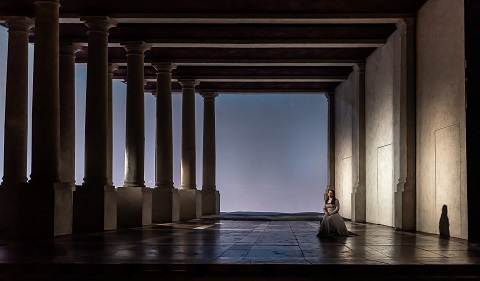 Hrachuhi Bassenz as Amelia Grimaldi. Photo credit: Clive Barda/ROH.
Hrachuhi Bassenz as Amelia Grimaldi. Photo credit: Clive Barda/ROH.
There is much to beguile, but on the first night of this revival run, which has been overseen by Moshinsky, initially things didn’t seem to gel. The singers are often set to the rear of the deep set and their voices occasionally seemed detached from the orchestral fabric, not exactly ‘all at sea’ but somehow floating along without ever really riding the waves. The Council Chamber scene was a visually arresting canvas of golden sceptres, silver swords and fiery red - the crimson robes and regalia of office, the heated blood of the baying plebeians - but, despite the intensity of the scene, which tightened like a sprung coil, the drama didn’t quite seem ‘real’.
The five male roles were vocally individualised, but the principals also need to work together, something that they struggled to achieve in Act 1. And, Hrachuhi Bassenz seemed uncomfortable in this Act, her voice sliding up to, or just under the note, and floating thereabouts but never quite settling into a true lyrical line - of the kind that would fulfil the dramatic requirements of the role. Though Bassenz’s tone was not harsh, it lacked a soft shimmer and was occasionally a little murky. The Armenian soprano was stronger in the ensembles, attacking the words and investing her interventions in the Council Chamber with both anxiety and anger.
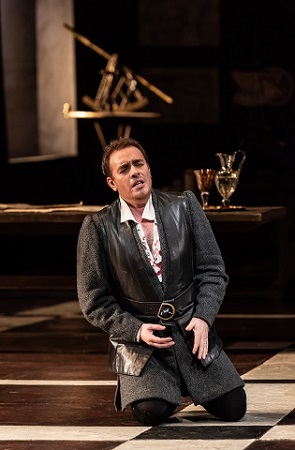 Francesco Meli as Gabriele Adorno. Photo credit: Clive Barda/ROH.
Francesco Meli as Gabriele Adorno. Photo credit: Clive Barda/ROH.
The move from public domains to private dramas in Act 3, however, seemed to initiate fresh intensity and to inject the singing and playing with a passion which had authenticity and power. Francesco Meli got the ball rolling, his fervent ‘Sento avvampar nell’anima’ fuelling both his own jealous rage and the opera’s emotional thermometer. It also prompted a fairly sedate ROH audience, whose coughing and fidgeting had outweighed their attentiveness up until this point, to offer their first endorsing applause. Meli certainly conveyed Adorno’s hot-headedness, and the crests of his phrases were ardent and aching, but both his vocal volume and characterisation were a little unalleviated, and he didn’t fully convey Adorno’s divided and fluctuating allegiances.
It was left to the two men who are locked in a conflict which is both historical and haunting to reveal the opera’s real, human drama. As the man who comes from low beginnings to rule in Genoa for twenty-five years, Carlos Álvarez was following some ‘big names’ in this production, including Domingo in 2010 and Hampson in 2013 . He impressed immensely, using his warm tone and consistent focus to create a credible portrait of a man whom misfortune and misery, alongside the powers of public office, have made tyrannical, but who learns to forgive, shows magnanimity, and finds redemption.
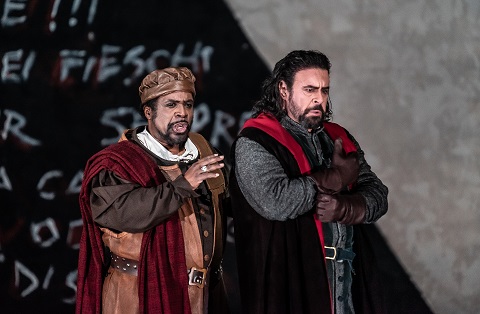 Mark Rucker as Paolo, Carlos Álvarez as Boccanegra. Photo credit: Clive Barda/ROH.
Mark Rucker as Paolo, Carlos Álvarez as Boccanegra. Photo credit: Clive Barda/ROH.
The long scene in which Boccanegra discovers that Amelia is in fact Maria, his long-lost daughter, was beautifully structured, but it was Boccanegra’s framing confrontations with Ferruccio Furlanetto’s Jacopo Fiesco that struck the most incisive emotional punch. The two men had equal dignity, might and majesty, ensuring that both their conflict and their conciliation were gripping. Furlanetto’s voice may not have the firmness of old, and some passages at the top were not as full-toned as one might wish. But, his diction was superb; and, the trembling depths of his bass in the Prologue’s ‘Il lacerate spirito’, when Fiesco learns that Maria has died, evoked the shuddering grief of a stricken heart with a power that resonated in my own.
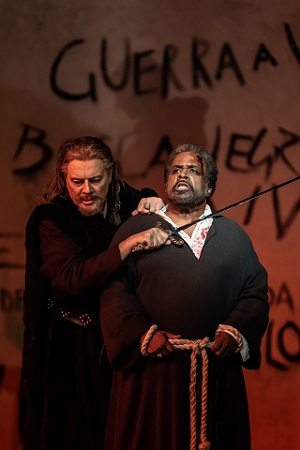 Ferruccio Furlanetto as Fiesco, Mark Rucker as Paolo Photo credit: Clive Barda/ROH.
Ferruccio Furlanetto as Fiesco, Mark Rucker as Paolo Photo credit: Clive Barda/ROH.
Simon Shibambu sang with confidence and presence as Pietro, but Mark Rucker’s Paolo made less impact vocally. Under conductor Henrik Nánási the ROH Orchestra matched the darkness of the drama on stage, though I’d have liked rather more urgency in the opening scenes.
By the end, though, the chilling horror conjured by Boccanegra’s blood-curdling curse, ‘Sia maledetto’, had been both released with tremendous visceral force and tamed through real human compassion and reconciliation. Those political plotters currently planning coups and crises in another Palace just a bit further up the river might do well to take note.
Claire Seymour
Verdi: Simon Boccanegra
Simon Boccanegra - Carlos Álvarez, Jacopo Fiesco - Ferruccio Furlanetto, Amelia Grimaldi - Hrachuhi Bassenz, Gabriele Adorno - Francesco Meli, Paolo Albiani - Mark Rucker, Pietro - Simon Shibambu, Amelia’s Maidservant - Dervla Ramsay, Captain - Simon Davies; Director - Elijah Moshinsky, Conductor - Henrik Nánási, Set designer - Michael Yeargan, Costume designer - Peter J. Hall, Lighting designer - John Harrison, Fight director - Philip d'Orléans, Orchestra and Chorus of the Royal Opera House.
Royal Opera House, Covent Garden, London; Thursday 15th November 2018.
image=http://www.operatoday.com/181112_0225%20Simon%20Boccanegra%20Production%20Image.jpg image_description= product=yes product_title=Simon Boccanegra: Royal Opera House, Covent Garden product_by=A review by Claire Seymour product_id=Above: Simon BoccanegraPhoto credit: Clive Barda/ROH
November 16, 2018
Royal Academy's Semele offers 'endless pleasures'
So suggests Olivia Fuchs, in her new production of Handel’s Semele for the Royal Academy of Music. King Cadmus of Thebes may proclaim ‘flashes of auspiciousness’ to the wedding guests awaiting the nuptials of his daughter Semele and Athamas Prince of Boethia at the Temple of Juno, when the Goddess accepts his sacrifice, but the guests’ celebratory chorus, ‘Lucky omens!’, proves deluded and short-lived.
Their mobile ’phones record every marriage-moment, Instagram-ready for public consumption, but Semele has her eyes on a higher prize: Jupiter. There’s nothing wrong with ambition, but when one’s desires are a merely the reflection of a mirror, aspirations become warped. Not content with being worshipped by mere mortals, Semele desires immortality itself, but her dalliance with the deities seals her own destruction: death not by thunder-bolt but by flash-bulb.
Fuchs’s modern-dress production finds some neat parallels between the marital infidelities of the Ovidian myth; the fears of Handel’s contemporary public that King George II would make his mistress, Amalie von Wallmoden - whom he had set up with a title and large income - Queen of England; and modern-day celebrity-dom, a realm fuelled not by heavenly spheres but by a paradoxical and toxic mix of excess and emptiness. If she pillories those who, in a crisis of identity and authenticity, believe they are ‘stars’ through the seemingly hackneyed opera-trope of the snapping mobile ’phone, then that seems to be Fuchs’ point: the celebs, and the malleable masses, never learn. There’s little star-dust to be found in a life lived as a commodity: an image without substance, offered up for public consumption.
The simple and clear designs, by takis, cleverly elucidate the incompatibility of the earthly and the celestial, and the destruction that is unleashed when these realms interact. During the overture, the curtain lifts to reveal a rather inauspicious wedding venue: a dingy, subterranean ‘bunker’ where, amid the assorted wooden chairs that anticipate the guests’ arrival, the principals enact a mime which usefully outlines allegiances and motivations. If their gestures are sometimes reminiscent of the expressionism of 1920s’ silent cinema, then the hint of histrionics is apt. The guests’ black evening-wear proves fitting when Jupiter’s eagle sweeps Semele up to the stars and events take a more funereal turn.
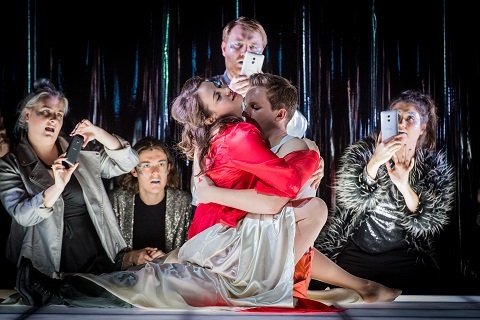 Lina Dambrauskaite (Semele), Ryan Williams (Jupiter) and Chorus. Photo credit: Robert Workman.
Lina Dambrauskaite (Semele), Ryan Williams (Jupiter) and Chorus. Photo credit: Robert Workman.
An overhead light-box is lowered and, like a floating four-poster bed, wafts Semele upwards to Jove’s palace, where ‘endless pleasures, endless love’ await her. This Semele’s appetites, both material and carnal, prove insatiable: the chorus swap black for celestial silver and pander to her whims, while the enraged Juno-cum-Anna Wintour (a fine performance by Frances Gregory) plots her demise with her put-upon but willing PA, Iris. Lighting director Jake Wiltshire gives the star-spotted sky a glow of night-club pink and green, creating a palpable sense that the heavenly hedonism is going to come to an end with that metaphorical midnight-chime.
The young cast, the first of two, sang superbly on opening night. Even more impressively, they did so while accomplishing Fuchs’s busy stage directions. In the title role, Lina Dambrauskaitė skilfully showed how Semele’s solipsism grows, from sulky beginnings as she is reluctantly divested of her dressing gown and forced into a frothy gown, through sensuous self-indulgence when she subsequently sheds the candyfloss confection for a crimson silk camisole, to stubborn self-delusion as Jove’s acolytes fawn over and fondle her. Despite the dramatic distractions, Dambrauskaitė’s delivery of the coloratura was near faultless, peppered with some judiciously extravagant elaborations. Her tone was beautifully bright as she anticipated those ‘endless pleasures’, there was a delicious wryness about ‘Myself I do adore’ and few could surely deflect the determined, near-deranged, demands and desires which Dambrauskaitė threw at the hapless Jupiter in ‘No, no, I’ll take no less’.
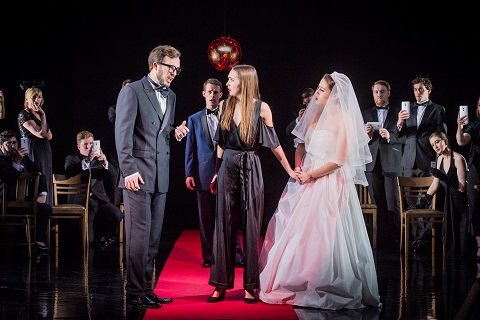 Thomas Bennett (Cadmus), Alexander Simpson (Athamas), Olivia Warburton (Ino,) Lina Dambrauskaite (Semele), and Chorus. Photo credit: Robert Workman.
Thomas Bennett (Cadmus), Alexander Simpson (Athamas), Olivia Warburton (Ino,) Lina Dambrauskaite (Semele), and Chorus. Photo credit: Robert Workman.
Ryan Williams did his best to sway his beloved though, and when the champagne, chocolates and flowers, helpfully supplied by Aimée Fisk’s Cupid, failed to win over the piqued and pouting Semele, it seemed for a moment that the sparkly Jimmy Choos might just do it. But, no. This Jupiter shaped his recitative wooing and worship elegantly, lovingly comforted in ‘Lay your doubts and fears aside’, beguiled with gentle lyricism in ‘Where’er you walk’, and warned his wilful woman with vocal punch and persuasiveness in ‘Ah, take heed what you press’. But, the beauties of Arcadia proved less appealing than the temptations of Semele’s own targets.
Olivia Warburton had impressed in the title role of Teseo at the London Handel Festival earlier this year, and here she made a strong impact as Semele’s sister, Ino, finding sadness and serenity in the role: her duet with Dambrauskaitė, when the sisters are briefly re-united in Jupiter’s paradisal gardens was one of the highlights. I’m not sure that her boogie-woogie wiggles to Athamus’s aria of acceptance, ‘Despair no more shall wound me’, sung with clarity and strong projection by Alexander Simpson, were entirely in character, but Warburton’s celebratory cartwheel was certainly impressive.
Thomas Bennett didn’t quite summon sufficient nobility of line as the distressed Cadmus, though his tone was warm; but his recalcitrant Somnus was strikingly sonorous despite his somnolence. Emilie Cavallo (Iris), Maya Colwell (Pasithea) and Joseph Buckmaster (Apollo) completed the fine line-up.
The Chorus were superb: their diction, strength, tone, co-ordination and choreography were all equally notable. The monumental terror and majesty of ‘O terror! and astonishment’ were terrifically emotive and powerful. I found the playing of the Royal Academy Sinfonia a little lacking in colour and character, though the lightness of the ensemble sound did make for some fleet runs. And, there was impressive virtuosity from individual players, especially from the bassoon player who underpinned Jupiter’s worried warning to ‘take heed’. The chamber organ was used to good effect.
At the close, Buckmaster’s Apollo, resplendent in purple suit and silver lame trainers, descended with a babe in his arms: the phoenix that arises from Semele’s ashes, the unborn child of mortal and god. But, despite the choral rejoicing, ‘Happy shall we be’, Athamus seemed disenchanted by Apollo’s reassurance that this baby Bacchus will be a god ‘more mighty than love’, taking umbrage at Ino’s apparent devotion to the new addition to their family and storming off in a jealous sulk, leading Ino to seek solace in father’s arms once more. So, this lieto fine was less than fortunate: disillusionment and disappointment, not dreams, will be your lot, Fuchs seems to say.
Claire Seymour
Handel: Semele
Semele - Lina Dambrauskaitė, Ino - Olivia Warburton, Cadmus/Somnus - Thomas Bennett, Athamas - Alexander Simpson, Jupiter - Ryan Williams, Juno - Frances Gregory, Iris - Emilie Cavallo, Cupid - Aimée Fisk, Apollo - Joseph Buckmaster, Pasithea - Maya Colwell; Director - Olivia Fuchs, Conductor - Laurence Cummings, Designer - takis, Lighting designer - Jake Wiltshire, Royal Academy Chorus and Sinfonia.
Susie Sainsbury Theatre, Royal Academy of Music, London; Wednesday 14 th November 2018.
image=http://www.operatoday.com/Juno%20et%20al.jpg image_description= product=yes product_title=Semele: Royal Academy of Music product_by=A review by Claire Seymour product_id=Above: Fran Gregory (Juno), Lina Dambrauskaite (Semele) and ChorusPhoto credit: Robert Workman
November 13, 2018
The Eternal Flame: Debussy, Lindberg, Stravinsky and Janáček - London Philharmonic, Vladimir Jurowski
When I interviewed Lindberg back in 2001, just before the Related Rocks festival devoted to his music at the Southbank Centre, he explained how if you wanted to compose for the voice you had to solve the problem of melody - and that was something he found difficult to do. It’s probably true to say in Triumf att finnas till… that Lindberg has now resolved the issues he had with writing for the voice, though he has had to abandon much of his earlier style to achieve that. The composer who wrote Kraft in 1985, with its rhythmic punch and rough sonorities, or even works like Aura (1993-4) and Engine (1996) which were works of friction and owed at least something to the kaleidoscopic sound world of Berio or Stravinsky, has now become unmistakably Sibelian - the connectivity between Triumf and Kullervo feels as if it has been fully embraced.
I think if Södergran’s text is specifically an affirmation of the human will to triumph over slaughter, a more existential meditation on life rather than death, then Lindberg’s score sometimes tries to reflect the opposite. Although the work is written in seven stanzas, there is no discernible break between them. Lindberg’s writing for percussion is sustained throughout the work - and if it sounds like shell-fire, the dynamics adjusted to reflect distance and space, this is part of the effect. Your ears adjust to the muffling, just as they do to the penetrating explosions. It often feels like a rather bleak score; tenebrous, and rather like an instrumental requiem. My guest for this concert found it “somnambulant” (and I don’t believe he was alone in this view).
Vladimir Jurowski and the London Philharmonic Orchestra played it well - though it ended up being considerably longer than the advertised playing time. For some, I can imagine Lindberg’s thematic material not surviving the length of time it took Jurowski to get through the music; for others, the score is powerful enough to suggest the apocalypse of war. I think the presumption that every syllable of Södergran’s text was meant to be heard was somewhat undermined by the occluded phrasing of the London Philharmonic Choir. I found much of it rather unintelligible.
Stravinsky’s Requiem Canticles has no particular connection to the Armistice, though it is a ritual for the dead if not specifically relating to any one period of time. Radical to the last, Stravinsky’s Requiem Canticles (virtually his last completed score from 1965-66) is not in the remotest liturgical, though its fusion of excoriating catharsis, skeletal writing and latent power is more than equal to the terrors of the First World War. Perhaps the most obviously cinematic of the works on the programme - the very opening sounds like gunfire - this is a piece that in a great performance can send shivers through the spine as it creates tension and dread through its terrifying climaxes. For such a compact work it amplifies astonishing force and mourning.
Jurowski and the London Philharmonic gave a very taut performance of it - pungent enough to yield much of the work’s fury and ritualism. The Dies irae had chorus and brass in almost perfect synchronicity, rich and resonant, and this was well contrasted with the piano and strings, almost strained to breaking by a feeling of tremulousness. Maxim Mikhailov’s bass in the Tuba mirum never felt on the verge of the collapse as I’ve sometimes felt in a few performances of this work - and it was idiomatically sung, with a beautifully phrased final note that is never easy to manage. Angharad Lyddon’s Lacrimosa wasn’t in perfect balance to the Tuba mirum, perhaps less divine than the writing suggests.
Janáček often feels as if he has been overlooked as a composer in the United Kingdom. Although Janáček’s The Eternal Gospel had been composed just before the outbreak of the Great War, it was subsequently revised after its premiere in Prague in February 1917. The text, although inspired by events centuries before that of Edith Södergran, does share a vision with her that is less bleak - even though by the time Janáček revised the score at the height of the war Jaroslav Vrchlický’s 1891 ‘legend’ had become completely unrecognisable. The score itself is magnificent, and is oddly reverential and deeply spiritual coming from the pen of a deeply agnostic composer.
This was in many respects a stand-out performance from the London Philharmonic Orchestra. Particularly notable were the detailed and exquisite violin solos of the orchestra’s leader, Pieter Schoeman; composed to represent the angel and his gospel of love they were meticulous and perfectly tuned. Such was the clarity of the string playing in this performance, that even when the rest of the violin desks were playing, and no matter what the dynamic range, the different bar lines were absolutely audible. But this is also a score that surges with huge waves of sound - the opening movement rises inexorably and you never quite feel it relents. Janáček vividly described this music as representing “open arms longing to embrace the whole world” something which Jurowski’s conducting achieved by never scaling back on the dramatic impact.
Vsevolod Grivnov, singing Joachim of Fiore, seemed a little hesitant at first but had become mercurial and stentorian by his final epilogue. Andrea Danková, singing as the Angel, actually looked rather sinister; the way she glowered into the audience was, frankly, a little unsettling. But what a voice! I found her singing absolutely compelling. It’s certainly arguable this a soprano which is more resonant than most, has much darker tones, and it was distinctly less ethereal than the magical lines floated by the violin, but the contrast was magical. The London Philharmonic Choir gave their best performance of the evening; the only thing that disappointed was the Festival Hall organ which didn’t really register.
The inclusion of Debussy’s Berceuse héroïque, which had opened the concert, was the slightest of beginnings, though shares with the last work on the programme, The Eternal Gospel, the year 1914. Debussy’s memorial to Belgian forces resisting the German army at the outbreak of the war, it seems to pour into its five-minute duration a lot of elegy, but not much depth. Jurowski managed to make it sound much less like Debussy, and much longer than it needed to.
As with other concerts in this short, but largely compelling, season based on ‘Stravinsky’s Journey’ microphones were present.
Marc Bridle
Andrea Danková (soprano), Angharad Lyddon (mezzo-soprano), Vsevolod Grivnov (bass), Maxim Mikhailov (bass); Vladimir Jurowski (conductor), London Philharmonic Choir, London Philharmonic Orchestra.
Royal Festival Hall, London 10th November 2018.
image=http://www.operatoday.com/Andrea%20Dankov%C3%A1.jpg image_description= product=yes product_title=The Eternal Flame Debussy, Lindberg, Stravinsky and Janáček - London Philharmonic, Vladimir Jurowski at the Royal Festival Hall product_by=A review by Marc Bridle product_id= Above: Andrea DankováNovember 12, 2018
François-Xavier Roth conducts the London Symphony Orchestra and Chorus in Works by Ligeti, Bartók and Haydn
Vladimir Jurowski, the London Philharmonic Choir, and the LPO had set the bar high; François-Xavier Roth, the London Symphony Chorus, and the LSO proved more than worthy successors.
Again, there was no nationalist sentiment in (aural) sight; instead, we heard another fine, thought-provoking programme, with much to savour in performance too.
Ligeti’s Lontano, music from afar, offered an introductory object
lesson in listening and thus a lesson in humanity too. What ill ever came
of listening? Alas, as we remember the victims of war, we know only too
well what ill comes of failing to listen. Infinite subtlety in work,
performance, and yes, reception offered a far greater strength to the
masculinist posturing of militarism. How much we heard, making us realise
how much we often fail to hear. The LSO seemed to act as a chorus of its
own, speaking words, messages that we might well fail to understand - and
which yet were no less real for that. Final silence at the close truly
inspired awe: a lesson for us all, albeit unlikely to be heard by those
most in need of hearing it, of listening.
For Bartók’s Cantata profana, the LSC, tenor Julien Behr, and bass
William Thomas joined Roth and the orchestra. In this particular context,
the ballad of an uncomprehending father sending out his nine sons to hunt,
those sons thereafter, having been transformed to stags, unable to return
home, a grieving mother notwithstanding, took upon resonances perhaps not
originally ‘intended’, yet no less real for that. The transformation taking
place in words and musical form alike, a story retold, both similar to and
yet different from its original telling, invited further resonances both
old and new. It certainly did in performances both thoughtful and exciting,
in the grip of yet also liberated by musical and verbal narrative. Sinister
yet inviting orchestral polyphony at the opening itself seemed to refer to
a Bluebeard’s Castle revisited and yet forgotten - perhaps even an
earthy successor to Mahler’s Klagende Lied. This was before, let
alone after, the entry of the chorus, a world still more primæval. Who
narrated? The forest? Humanity? Particular participants? All and none of
those, one could imagine at different times, as a magical, fantastical, yet
unquestionably ‘real’ narrative unfolded. Multifarious voices, vocal and
orchestral, spoke to us, but did we listen? Emboldened by Ligeti’s example,
we made the attempt. We were amply rewarded too, whether in Behr’s near
faultless handling of the cruel tessitura of his part, in the dark
chocolate of Thomas’s performance that yet lacked nothing in precision, or
in the outstanding command of the Hungarian text and its musical
elucidation from the chorus. Masculinity showed its tender side here too;
the ultimate tragedy nevertheless, quite rightly remained one of
incomprehension - even to the extent of knowing whether it were tragedy at
all.
Haydn’s Missa in angustiis, the so-called ‘Nelson Mass’, offered a different musical and indeed verbal narrative, one which could nonetheless be related to much of what we had previously heard. In its journey from darkness to light, from plea for mercy to divine peace, it offered delight as well as hope, as well, perhaps, as the fear that such might yet remain tantalisingly out of our twenty-first-century reach. The ‘Kyrie’ could hardly have proved more urgent, Camilla Tilling first amongst solo equals, her coloratura duly thrilling. The variegated tone of the LSO here and elsewhere offered a point of contact with Colin Davis’s more ‘traditional’ Haydn with the same orchestra. His way is not Roth’s; nor is there any reason it should be. There was no doubting the integrity of his more ‘period’-influenced approach, which seemed simply to correspond to his understanding of the music rather than to the application of ideology. It outstripped in every respect the meanderings earlier this year of András Schiff with the Orchestra of the Age of Enlightenment in Haydn’s Harmoniemesse , which, whatever their external would-be ‘authenticity’, had shown little engagement with the actual material of the work. Roth’s command of form as dynamic structure was evident from this very first number, the return of the ‘Kyrie’ material as dramatically meaningful as the coming of any symphonic recapitulation.
The ‘Gloria’ had, to quote Haydn himself, my heart leaping for joy. Incisive, warm orchestral playing left plenty of room for darkness too. Behr and Christopher Purves offered finely judged responses to Tilling’s lead, mezzo Adèle Charvet’s subsequent ‘Gratius agimus tibi’ a further, properly symphonic development that lacked nothing in beauty of tone. And so it continued, Haydn’s setting our guide, the hallowed liturgical text remaining his - and our - master. If the opening of the ‘Credo’ were taken faster than one -at least I - might have expected, certainly faster than once would have been the case, it was certainly none the worse for that, likewise the ‘Crucifixus’ material. Once again, in the light of Ligeti’s invitation and, indeed, his invention, we seemed to hear so much more than might often be the case: for instance, a string quartet writ large in the ‘Et incarnatus’ section, those terrible sounds of war too, familiar and yet heard anew - just as they should be. There was no doubting Roth’s relish of Haydn’s invention in the vivid setting - depiction? - of the Resurrection, nor the superlative quality of choral singing, from which one might readily have taken dictation. Haydn’s good nature brought tears to the eyes; it could hardly have done so without such excellence of performance.
Awe in the ‘Sanctus’; emotional gravity in the ‘Benedictus’, further sounds of war and all, whose surrounding setting retained its roots in an older Austrian Baroque; an ‘Agnus Dei’ whose leisurely way brought due relief even as we continued to implore: all paved the way for a peace which, as ever with Haydn, passed both understanding and lazy assumptions as to what might be ‘fitting’. There were, then, lessons aplenty to be heard and, God willing, to be listened to too. Perhaps foremost among them was our continuing human need for a joy which, if hardly prelapsarian, might find good as well as ill in this, our created, fallen world.
Mark Berry
Ligeti: Lontano; Bartók: Cantata profana; Haydn: Missa in Angustiis, ‘Nelson Mass’, Hob. XXII/11. Camilla Tilling (soprano); Adèle Charvet (mezzo-soprano); Julien Behr (tenor); Christopher Purves, William Thomas (bass); London Symphony Chorus (chorus director: Simon Halsey)/London Symphony Orchestra/François-Xavier Roth (conductor). Barbican Hall, London, Sunday 11 November 2018.
image=http://www.operatoday.com/Julien%20Behr.jpg image_description= product=yes product_title= François-Xavier Roth conducts the London Symphony Orchestra and Chorus in Works by Ligeti, Bartók and Haydn, at the Royal Festival Hall product_by=A review by Mark Berry product_id=Above: Julien Behr (tenor)Photo credit: Rudy Waks
November 11, 2018
The Silver Tassie at the Barbican Hall
In recent weeks, there have been so many Armistice centenary events, and commentaries on such commemorations, that the weight of memory, history and collective expectation and responsibility has sometimes felt bewildering or overwhelming. The performance of Mark-Anthony Turnage’s 2000 opera The Silver Tassie - the apex of the ‘Total Immersion’ weekend of performances, screenings and talks inspired by the events of 1914-18 at the Barbican Centre - brought debates about sport and war, violence and religion, love and sexuality, into tense, troubling and heightened theatrical focus. The performance was buffeting and blistering; the musical and emotional punch delivered was knockout; but, just what was being ‘celebrated’ was more equivocal.
As the Guardian’s Senior Sports Editor remarked in the Saturday edition, the centenary of the 1914-18 conflict has seen a veritable ‘blizzard of remembrance’. Barney Ronay was reflecting on the life and achievements of Kent and England cricketer Colin Blythe, who hailed from Deptford in south-east London and, off-season, played violin in concert orchestras around Kent, and whose death - one among half a million men on both sides who were slaughtered in the Battle of Passchendaele, the 101st anniversary of which falls this weekend - was marked in the cricket media and by local people in south-east London this week. Ronay asks, ‘How to grasp this industrialised slaughter? How to remember it in a way that makes any sense?’ One might add a further question: through art? Mark-Anthony Turnage’s opera, The Silver Tassie, certainly upholds the continuing argument for and appeal of WW1 as a source of creative inspiration and monument.
Sean O’Casey’s 1928 play on which Amanda Holden’s libretto for Turnage’s opera is based, laments such loss of life - literal and figurative, for many ‘survivors’ were condemned to a living death - in the First World War. The play’s hero, the dynamic star of the local football team, Harry Heegan, leads his fellow sportsmen to victory in the coveted Championship Cup. With the eponymous trophy secured in the cabinet, Harry, the apple of his parents’ eye and worshipped by his girlfriend Jessie, heads off to war, only to return disabled and embittered. Jessie falls in love with Barney who, ironically, has won the VC for saving Harry’s life; Teddy Foran, an abusive husband who lives in a flat above the Heegans, returns from the frontline blinded and dependent upon the wife he has bullied and threatened. Harry and Teddy have to find a way to survive when, in their youth, they are brought to a state of ‘leg-staggering an’ belly-creeping’.
When W.B. Yeats rejected O’Casey’s play for the Abbey Theatre in 1928, he commented that, ‘There is no dominating character, no dominating action, neither psychological unity nor unity of action ...’. In particular, Yeats lamented the contrast between the expressionistic abstraction of Act 2 and the realism of surrounding three Acts - the home-front of the latter being the predominant forum for the unfolding dramatic conflicts. Moreover, the effect of war on the soldiers and the society from which they hailed is uppermost in O’Casey’s play, and everyone - man and woman, church and state, parent and child - is implicated in the horror.
The playwright’s Act 2 chants and songs may have troubled the critical commentators, but they facilitate Turnage, whose operatic adaptation transforms this section of the drama into a grand choral episode delivered from behind the front lines of the Western Front: it is one of the opera’s strongest theatrical statements. The vigorous male voices of the BBC Singers and the animated Finchley Children’s Music Group were poignantly juxtaposed with the passing parade of boy stretcher-bearers. Brindley Sherratt was a sonorous ‘Croucher’, named after those who huddled in the trenches’ and who associates God with destruction, thereby inverting Ezekiel’s vision of the divine, throned chariot.
After an expository Act 1, it’s only really in Acts 3 and 4 of the opera that the human dimensions of the drama assert their grip. And, in the second half of this semi-staged performance there was a terrific balance between collective, communal suffering and individual and personal experience. In its presentation of a caustic cocktail of sex, religion, violence and love, Turnage’s opera reminds me of Britten’s Billy Budd. The role of Susie, the epicentre for the juxtaposition of violent destruction and religion, was terrifically sung by Sally Matthews who displayed power and evenness over a wide vocal range. Harry’s parents were warmly embodied by the discerning Susan Bickley and Mark le Brocq - Sylvester Heegan’s cardigan buttons were veritably popping with pride.
In the communal dance hall in Act 4, a quarrel between Harry and Jessie threatens to wreck the most recent celebrations of a Silver Tassie victory. As Harry, Ashley Riches was brutal and blunt, and paradoxically eloquent, about the effect of his wounds, both physical and emotional. As the inconstant Jessie, Louise Alder sang with characteristic poise but seemed a little under-characterised, and her need to flick briskly through her score weakened the impact of her moment of physical commitment to Alexander Robin Baker’s vehement, vigorous Barney.
Ryan Wigglesworth conducted a vividly colourful and percussive reading of the score, and if at times it felt a little relentless - the singers were subtly amplified but there were a few imbalances - then who am I to complain of a battery of drums and percussive, grating noise. One other thing: though semi-staged effectively and efficiently, Kenneth Richardson’s dramatic presentation seemed - give or take the odd green-and-white striped football scarf - rather Irish-lite, given that Turnage has said, ‘The fundamental thing I was concerned with was the Irishness of the play. Every line is within that Irish tradition.’
That said, there was so much to admire that I’m not entirely sure why I felt a little disconcerted at the close, as the applause echoed rapturously and extendedly, and the individual singers took their bows, joined by stage director Kenneth Richardson, chorus master James Henshaw, and Turnage himself.
I think, though, I wondered exactly what it was that we were applauding. Next month sees the release of Peter Jackson’s film They Shall Not Grow Old, which digitalises archive footage of WW1, following its television screening on Armistice Day on BBC2. The oft repeated misquotation of Laurence Binyon’s poem, ‘For the Fallen’ - ‘They shall grow not old, as we that are left grow old:’ - seems dispiritedly poignant.
The BBC has recently published on its website an account of survivors’ commemorations in the aftermath of the war : ‘A year after the conflict had ended, villages, towns and cities held parades, church services and observed two minutes’ silence. That was during the day. The evening of 11 November was different. Thousands of people - most of them young - wanted to have fun. “Victory balls” - charity fundraising events involving fancy dress, dancing, singing and copious drinking - were held to cater for this need. […] They celebrated with their comrades and marked the sacrifices of their fellows by living and enjoying their own lives.’
Though such Victory Parties were subsequently criticised, replaced by more sober commemorations, the BBC reports that, ‘One former officer stopped taking part in commemorations, describing them as “too much like attending one’s own funeral”’.
How we commemorate seems no less personal, and political, today.
This performance of The Silver Tassie was broadcast live on BBC Radio 3 and is available on BBC iPlayer for 30 days.
Claire Seymour
Mark-Anthony Turnage:
The Silver Tassie
Harry - Ashley Riches, Susie - Sally Matthews, The Croucher - Brindley
Sherratt, Mrs Foran - Claire Booth, Teddy - Marcus Farnsworth, Barney -
Alexander Robin Baker, Jessie - Louise Alder, Mres Heegan - Susan Bickley,
Sylvester - Mark le Brocq, Dr Maxwell/Staff Officer - Anthony Gregory,
Corporal - Benedict Nelson, Finchley Children’s Music Group, BBC Singers,
BBC Symphony Orchestra, Conductor - Ryan Wigglesworth, Stage director -
Kenneth Richardson.
Barbican Hall, London; Saturday 10th November 2018.
Photo credit: Jamie Simonds
The Last Letter: the Britten Sinfonia at Milton Court
Devised by Dr Kate Kennedy - who is the Weinrebe Research Fellow in Life-Writing at Wolfson College, Oxford - and performed in Milton Court Concert Hall by the Britten Sinfonia, baritone Jonathan McGovern and narrators Sophie Hunter and Richard Pryal - the programme represented, in Kennedy’s words, a ‘re-thinking and re-imagining’ of the First World War: a ‘nuanced’ picture allowing us to hear a ‘multiplicity of voices’ and which ‘put the composers of the war side by side with the writers, both male and female’.
It was certainly a diverse programme, with two musical works - the five songs which form Nico Muhly’s The Last Letter (2015), here performed for the first time in an arrangement for chamber orchestra, and five songs from Ivor Gurney’s settings of Housman, The Western Playland (1919, pub. 1926) - forming the backbone around which assorted poems, letters, prose fragments and other musical items were arrayed.
While the performances, musical and spoken, were unwaveringly committed and engaging, the sequence seemed to me overly complicated and fragmented - not least because of the confusing and unhelpful layout of the printed programme, in which a list of the musical items was followed by a description of the poetry and prose readings (though the texts themselves were not supplied), with the texts of the songs by Muhly and Gurney buried later in the programme amid explanatory notes relating to the other musical compositions to be performed. How was one to negotiate through the sequence, especially as the Concert Hall was repeatedly plunged into darkness, allowing for some atmospheric and theatrical spotlighting of the readers but making it nigh on impossible to read the printed texts supplied? Moreover, the cycles by Muhly and Gurney lost some of their impact because of the dispersal of their movements amid other items which tugged one’s focus in different directions, hindering the development of a ‘narrative’ and weakening the accumulation of expressive intensity through each cycle’s sequence of songs.
That said, I was impressed by the way the evening’s two narrators, Richard Pryal and Sophie Hunter, brought the varied voices, relationships and experiences of the historical past, recorded on the written page, into the living present. Amplification was employed - by necessity, I suppose, though one imagines that any self-respecting schoolmaster of the day would have had little trouble projecting with clarion resonance to the corners of the Concert Hall - and at times I would have liked the spoken voices to have had a little less immediacy, as in Rupert Brooke’s ‘Fragment’ or Wilfred Owen’s ‘Futility’, where I would have welcomed more gradation of tone and volume. But, Pryal and Hunter drew us into the pain and pathos recorded in the memoirs of Helen Thomas - whose poet-soldier husband, Edward, was killed at Arras in April 1917 - and in the letters of Vera Brittain and her fiancé, Roland Leighton.
Frederick Kelly’s letter to Edward Marsh, informing him of the death of his dear friend, Rupert Brooke, was beautifully recited by Pryal, accompanied by an intense rendition of Kelly’s Elegy: In Memoriam Rupert Brooke (1915), arranged for small string ensemble, in which Thomas Gould’s violin solo floated tenderly like an ascending spirit (Kelly was himself killed at the Somme just a few months thereafter). One of the most striking readings was ‘The Relief’, part of ‘Out of the Trenches’ from Broken Carousel by the German, Jewish poet, Leo Sternberg (translated from the German by Peter Appelbaum), with its terrible images of the soldiers ‘snowed in the trenches like snow-covered clods of earth … Our death cry only a signal for the army/ Behind us’.
In the light of the Armistice commemorations and with Brexit on the horizon, the fact that Muhly’s The Last Letter was commissioned by the Barbican Centre and the European Concert Hall Organisation, with the support of the Culture Programme of the European Union, seemed almost painfully ironic. Muhly’s settings of four letters drawn from Mandy Kirkby’s edition, Love letters of the Great War, and Schiller’s poem ‘The Gods of Greece’ (translated by Richard Wigmore) was first performed in this same Concert Hall in October 2015 by baritone Benjamin Appl and pianist Gary Matthewman. Here, members of the Britten Sinfonia played the composer’s new chamber orchestration, accompanying Jonathan McGovern, who gave an earnest and compelling performance.
The sparse textures etched by piano and harp at the start of the first song, threw the vocal yearning into sharp relief, as the husband repeatedly asks his wife, “Please, tell me your name, as I have forgotten it”. McGovern then conjured the urgency of the wife’s reply, surging in short fragments, “Jack - my own - my only love - how I look for our next letter - how much longer shall I have to wait?”, before retreating to a pianissimo of almost visceral intensity, “Oh! Let me feel you crushing,my very life into yours”. The large leap between the first two words of her written request to be permitted a conjugal visit, “Dear Leader of the Company!”, conveyed every atom of the strength she had to summon, before her passion - anger, desire, frustration - seemed to over-spill. McGovern’s focused line in the subsequent slow, simple declamation that she was to divorce her husband and marry another man, masked tragic emotional disturbance, as intimated by the violin’s commentary; the abruptness of the close was brutal. In the final song, in which Schiller describes a deserted landscape, the baritone’s dark tone and robustness through the angular line, “Fair world, where are you?”, was compelling.
The strength of line that McGovern displayed to such good effect in Muhly’s songs was occasionally less effective in Gurney’s Housman settings. In ‘Reveille’, I’d have liked more nuanced phrasing, to complement Gould’s expressive contribution, and while the forthrightness of the poet-speaker’s almost defiant honesty in ‘Loveliest of Trees’ - “Now, of my threescore years and ten,/ Twenty will not come again,/ And take from seventy springs a score,/ It only leaves me fifty more.” - I missed the soft wistfulness of the closing vision of the cherry tree, “hung with snow”. Pianist Mark Knoop engaged expressively with the vocal line and accompanying string quartet in ‘Is My Team Ploughing?’ and McGovern worked hard to differentiate the text’s speakers.
The members of the Britten Sinfonia made their own instrumental contribution to the memorialising medley. I was not familiar with Music for Seven Stringed Instruments (1907-11) by Rudi Stephan, who was killed in action near Tarnopol in Galicia on 29th September 1915, aged twenty-seven, but the Sinfonia’s beautiful performance of ‘Nachspiel’, which ended the first part of the recital, made me want to hear more. The melodies were supple, the tone warm, the harmonies subtly ambiguous, and the players crafted the structure finely, building towards a luminescent close in which the violins soared with silvery translucence above gentle but pointed harp gestures. Two movements, ‘Prelude’ and ‘Forlane’, from Ravel’s Le tombeau de Couperin (1917), arranged by Robert Weiner for oboe and string quartet, were interspersed between vocal items in the second half of the concert, which concluded, perhaps inevitably, with Barber’s Adagio for Strings (1936). The Britten Sinfonia gave a poised and self-possessed performance, employing a restrained vibrato which served paradoxically to increase the focused intensity. Here, at last, after the multiplicity of voices and perspectives, was the singularity and stillness that offered time and space for reflection and remembrance.
Claire Seymour
The Last Letter
: Britten Sinfonia, Thomas Gould (violin/director), Jonathan McGovern
(baritone), Sophie Hunter (narrator), Richard Pryal (narrator).
Nico Muhly, ‘Letter One’ from The Last Letter (world premiere of
chamber orchestral version); Ivor Gurney, ‘Reveille’ fromThe Western Playland; Frederick S. Kelly (arr. Divall),Elegy: In Memoriam Rupert Brooke; Muhly, ‘Letter Two’ fromThe Last Letter; Gurney, ‘Loveliest of Trees’ fromThe Western Playland; Rudi Stephan, ‘Nachspiel’ fromMusic for Seven Stringed Instruments; Gurney, ‘The Aspens’ fromThe Western Playland; Muhly, ‘Letter Three’ fromThe Last Letter; Ravel (arr. Weiner), ‘Prelude’ fromLe tombeau de Couperin; Muhly, ‘Letter Four’ fromThe Last Letter; Gurney, ‘Is my team ploughing?’ fromThe Western Playland; Ravel (arr. Weiner), ‘Forlane’ fromLe tombeau de Couperin; Muhly, ‘Letter Five’ fromThe Last Letter; Gurney, ‘March’ from The Western Playland; Samuel Barber, Adagio for Strings.
Milton Court Concert Hall, London; Friday 9th November 2018.
Photo credit: Gerard Collett
November 10, 2018
Fiona Shaw's Cendrillon casts a spell: Glyndebourne Tour 2018
Cendrillon was the twenty-third of Massenet’s thirty-four operas, to a libretto by Henri Cain based on Charles Perrault’s sober version of the Cinderella myth. The best theatrical fairy-tales are those in which shrewd mockery and schmaltzy magic are kept in fine balance, with a healthy dose of both droll, topical modernity and mythical universality - and Shaw treads the tightrope with élan and wit.
Cinders herself straddles both worlds and it is through the innocent, oppressed maiden that the modern and the magical are assimilated. Shaw’s opening scene is simultaneously a paean to and pillory of the modern worship of the designer mall and the cult of shopping, leading Cinderella’s father, Pandolfe - now married to Madame de la Haltière who comes, like a garish retail package, with two ‘add-ons’, her ghastly daughters Noémie and Dorothée - to lament his lost idyll of rural life with his beloved daughter, Lucette.
Thoughts of wedlock are also troubling Prince Charming. Tossing and turning in bed, the Prince torpidly rejects his father’s insistence that he marry, and marry well, even when the King threatens to have him sawn in half to determine the cause of his lack of romantic ardour. Before we know it, we are whisked by sleight of hand à la glass and mirrors into a fairy-tale quest of seeking and searching, courtesy of Jon Bauser ingenious designs which are beautifully lit by Anna Watson, and find ourselves tumbling through the revolving doors of Alice’s Wonderland.
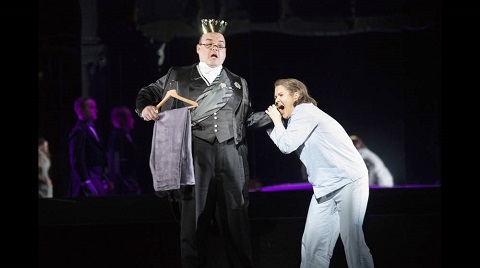 The King (Adam Marsden) and Prince Charming (Eléonore Pancrazi). Photo credit: Richard Hubert Smith.
The King (Adam Marsden) and Prince Charming (Eléonore Pancrazi). Photo credit: Richard Hubert Smith.
One problem - characteristic of the French genre - is what to do with the opera-ballets? Choreographer Sarah Fahie solves the dilemma with aplomb, assimilating tradition and modernism, dance and dramatic development, persuasively. Throughout the dance sequences, there is a lovely fluidity of rhythm and the charm of Massenet’s melodies reminds us that, whatever the kinetic wizardry, it’s the music that’s calling the shots.
A rare false note is the inclusion of a child-Cinders who haunts far too many scenes, to no obvious purpose. During the overture, the blond-ringleted munchkin hop-scotches in outsize glass slippers, tumbling and scraping her knee, which necessitates the application of sticking plaster. But, Cinders’ slipper does fit, surely? Shaw may be tapping into the Freudian overtones of the tale - dead mothers and all that - but, like the over-load of butterfly imagery, it’s a tad too heavy-handed. And, just who is the man in stripy knickerbockers and top hat, who seems to be suffering from a slipper-fetish, and who prances through the overture, reappearing, sinisterly, at intervals?
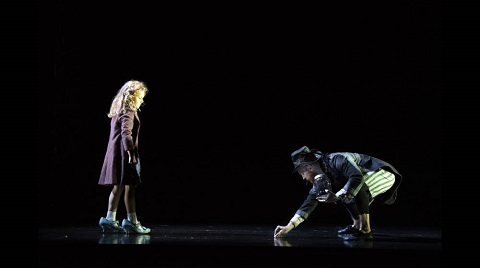 Young Cinderella (Megan Silburn) and dancer (Robin Gladwin). Photo credit: Richard Hubert Smith.
Young Cinderella (Megan Silburn) and dancer (Robin Gladwin). Photo credit: Richard Hubert Smith.
One of the joys and strengths of this production is the marriage of the two voices at the opera’s heart. Though Cinderella is ostensibly a soprano role, much of the writing lies in middle of the voice, and mezzo-soprano Alix Le Saux displayed a soft-grained tone, finely nuanced phrasing and a strong upper extension. She balanced folk-song simplicity and directness - as when her chavvy step-family dress in their ‘finery’ and rush off to ball - with more sophisticated vocal nuance and some lovely floating high notes which made Massenet’s honeyed melodies soar. This oppressed skivvy was no ingenue: loved by her father she was fully aware of what was what and what she wanted.
Shaw has, probably unintentionally, tapped into a zeitgeist debate too. During a much-reported appearance on the US talk-show Ellen, actress Keira Knightley recently announced that she has banned her three-year-old girl from watching Cinderella and The Little Mermaid because of the way in which they portray women. Cinderella ‘waits around for a rich guy to rescue her’, Knightley lamented, asserting her belief that girls must rescue themselves. In the Guardian, Steve Rose offered a countering argument, 'Why Prince Charming is all out of happily ever afters' . Shaw herself plays confidently with the en travesti ambiguities, suggesting that Eléonore Pancrazi’s Prince Charming is not so much feminine in manner, as female in fact. In this way, the director steers clear of over-sentimentality and intimates deeper psychological currents than a Disney-esque presentation would allow, while not banishing fairy-tale enchantment. And, Shaw’s gender games are subtly played - until, that is, the Prince morphs into a serving-maid.
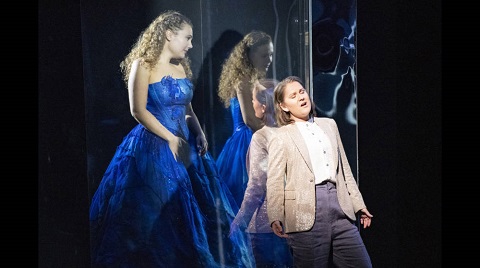 Cinderella (Alix Le Saux) and Prince Charming (Eléonore Pancrazi). Photo credit: Richard Hubert Smith.
Cinderella (Alix Le Saux) and Prince Charming (Eléonore Pancrazi). Photo credit: Richard Hubert Smith.
The wondrous vision of Cinderella in costume designer Nicky Gillibrand’s sumptuous ultramarine confection sends the Prince’s melancholy swiftly packing, and the similarity of the range and timbre of Le Saux and Pancrazi - the latter’s relaxed, supple phrasing was a real joy - made this marriage of minds, souls and voices utterly convincing. If the lightness of the two principals’ voices evoked their innocence, or even immaturity, then their Act 3 duet conjured an almost Straussian ardour. Le Saux and Pancrazi really did make us believe that they are destined to live happily ever after.
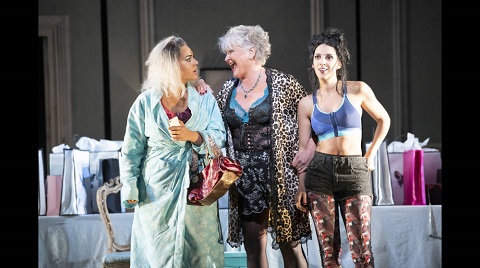 Dorothée (Kezia Bienek), Madame de la Haltière (Agnes Zwierko) and Noémie (Eduarda Melo). Photo credit: Richard Hubert Smith.
Dorothée (Kezia Bienek), Madame de la Haltière (Agnes Zwierko) and Noémie (Eduarda Melo). Photo credit: Richard Hubert Smith.
William Dazeley sang with tenderness and warmth, as Pandolfe. His was a sensitive and discerning portrayal: it’s quite a challenge to be a hen-pecked wimp and to make one’s mark vocally, and Dazeley achieved this impressively. Madame de la Haltière and her daughters formed a grotesque trio of hollow-hearted, empty-headed greed and grossness - did they need to be quite so vulgar? - putting on an over-the-top comic display in which Eastenders met AbFab. Polish mezzo Agnes Zwierko was game and committed as the ghastly, over-bearing mother, and made terrific use of a chest voice which would strike fear in any subjugated spouse. Her fellow Pole, Kezia Bienek (as Dorothée), and Portuguese soprano Eduarda Melo (as Noémie) were superbly awful, but rather over-shadowed by their mother’s antics which included a chair-top striptease act. Caroline Wettergreen’s vocally sparkling Fairy, nonchalantly drawing on a cigarette as she expounded the terms of the spell to Lucette, provided an elegant antidote.
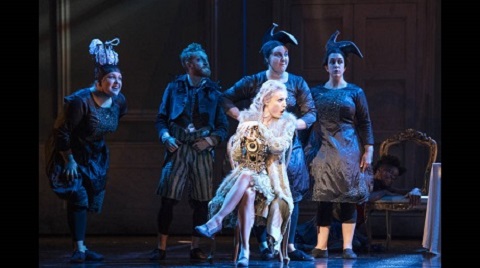 The Fairy (Caroline Wettergreen ). Photo credit: Richard Hubert Smith.
The Fairy (Caroline Wettergreen ). Photo credit: Richard Hubert Smith.
Conductor Jack Ridley waved his own magic wand in the pit, relishing Massenet’s delicacy and daintiness: indeed, at times a little more robustness might have provided greater drama thrust, but Ridley successfully blended the magic and the comic mayhem into a gratifying whole. Shaw’s Cendrillon truly cast its spell.
The previous evening, Tom Cairns’ production of La traviata returned to the Marlowe Theatre, where I first saw it almost four years ago to the day. Revived by James Hurley, the production is well-suited to touring. Hildegard Bechtler’s sets are simple, establishing milieu swiftly and clearly, and, adopting a fairly restrained approach to Verdi’s visceral emotional dramas, Cairns effectively focuses our attention on the eponymous courtesan herself. Not her physical decline - there was more consumptive coughing from the Canterbury audience than there was from the heroine herself; nor her oppression within the rigid class hierarchies and mores of the day. Rather, Cairns shines the spotlight on Violetta’s innate integrity, which isolates her from the surrounding social superficiality and confirms both her goodness and her loneliness.
Bechtler, too, ensures that Violetta commands our gaze. As the curtain rises, and as it falls, she is alone on stage. During the overture, prone on her bed - the latter is ever-present stage-left as we move between Parisian salon and pastoral retreat - Violetta languishes beneath a huge glistening chandelier. By Act 3, the glitter has dulled, the chandelier has shrunk, and beside the bed is a side-table cluttered with pill bottles. In the closing moments, she rises and walks towards the rear before, with her back to the audience, she suddenly slumps to the floor - a surprising denouement, and rare loss of logic and clarity by Cairns, as prior to this collapse Violetta’s death does not seem imminent. Why does she give up the ghost?
The sets and costumes are eclectic: there are some period details alongside 21st-century inferences, and this further reduces the relevance of the social context. The stage is divided by two towering walls and by Peter Mumford’s deep-hued lighting contrasts, emphasising the separation of public and private worlds. Stage-left an upholstered edifice curves graciously; on the opposite side a wooden wall stands ramrod-straight. Opposite Violetta’s bed, the revellers lounge lazily around, sinking into chairs whose curving folds might have been designed by Georgia O’Keeffe. Their evening dress is demure, almost uniformly black, which makes Violetta’s pale silk seem all the more pure, its wearer more innocent and vulnerable. In the gaming scene, the carousers hustle round three circular green baize tables in the central strip of the stage; the red peignoir that Violetta dons in this scene is ugly and ill-suited - no wonder it ends up crumpled on the floor, abandoned and trampled.
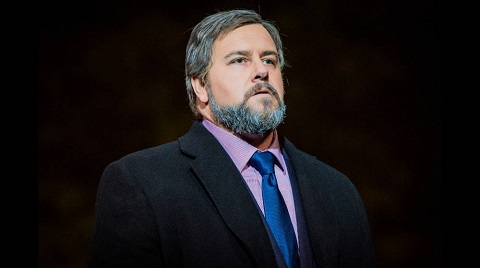 Photo credit: Robert Workman.
Photo credit: Robert Workman.
Act 2 offers freshness and light. Despite the messy clutter - a scruffy sofa is strewn with clothing and oddments, the coffee table topples under the weight of discarded glasses, cups, papers and knick-knacks, as if loyal, dependable Annina simply doesn’t have time to clear up after the self-absorbed couple - a gentle, pastoral backdrop suggests a rural idyll, although the gradual passing of the day visually complements the darkening that accompanies Germont’s arrival and demands.
In Act 1 Mané Galoyan’s Violetta Valéry floated amid the salon clientele, in a beautiful blue floral gown, as if she had risen from a painting by Édouard Manet. The Armenian soprano had the daring and dazzle to despatch the pyrotechnics of Act 1 with minimal fuss, and sang with a lovely lyrical bloom throughout the evening. But it was the sensitivity of her phrasing, and in particular a stunning pianissimo thread that was both whisperingly soft and heart-piercingly clear and true, that impressed most. During Violetta’s Act 2 tussle with Germont, her self-knowledge, submission and sacrifice were conveyed through an almost angelic purity of tone, while Galoyan’s wisps of vocal silk intimated Violetta’s vulnerability and inevitable decline. Her wept words to Alfredo, in the final Act, ‘Oh, tell your daughter, so lovely and pure, that a poor and wretched woman, who has but one precious thing in life - will sacrifice it for her - and then will die!’, were exquisitely delicate, fading almost to nothing but making a deep emotional impact.
 Mané Galoyan. Photo credit: Lynn Lane.
Mané Galoyan. Photo credit: Lynn Lane.
Neglecting contextual concerns such as class and status, Cairns focuses on the theme of thwarted love, and there was a fittingly strong rapport between Galoyan and Luis Gomes’ Alfredo. Gomes acted persuasively, communicating through his engagingly warm tenor all of Alfredo’s love and anger - he hurled his remonstrations vehemently at Claire Barnett-Jones’s patient Annina, when the latter revealed that her mistress had sold off the coaches and horses - as well as his bitterness and despair.
As Giorgio Germont, dressed in a rather non-descript overcoat Noel Bouley seemed earnest rather than coercive or intimidating. Bouley’s tone lacked focus initially, though his demeanour was dignified, but he grew in strength and stature in his Act 2 scene confrontation with Alfredo, restraining himself, just, from striking his son.
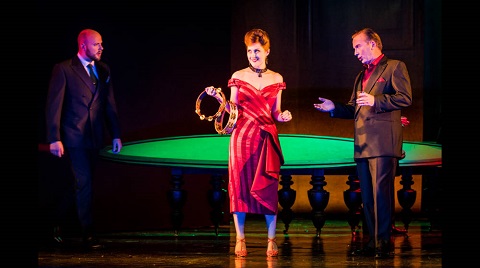 Doctor Grenvil (Donald Thomson), Flora Bervoix (Emma Kerr) and Marchese D’Obigny (John Mackenzie-Lavansch). Photo credit: Robert Workman.
Doctor Grenvil (Donald Thomson), Flora Bervoix (Emma Kerr) and Marchese D’Obigny (John Mackenzie-Lavansch). Photo credit: Robert Workman.
Cairns shows little interest in developing the relationship between Annina and her mistress, but Barnett-Jones gave a strong, sustained performance. Donald Thomson boomed sonorously as Dr Grenvil and Emma Kerr was a vibrant Flora. Conductor Christoph Altstaedt prioritised colour and sensitivity, drawing consistently expressive playing from the Glyndebourne Tour Orchestra and thus complementing Cairns’ conception.
UK opera audiences have had their pick of Traviatas of late: Daniel Kramer’s ENO staging in March was followed, at Opera Holland Park , by Rodula Gaitanou’s acclaimed production. Currently, Welsh National Opera are also taking La traviata to the provinces - likewise paired with fairy-tale, in the form of Rossini’s take on the Cinderella-myth, La Cenerentola. Galoyan’s superb performance ensures that Cairns’ production makes it mark among the many.
The Glyndebourne Tour , which is celebrating its fiftieth anniversary, continues until 1 st December.
Claire Seymour
Verdi:
La Traviata
Violetta Valéry - Mané Galoyan, Alfredo Germont - Luis Gomes, Giorgio
Germont - Noel Bouley, Annina - Claire Barnett-Jones, Flora Bervoix -
Emma Kerr,
Gastone - Nico Darmanin, Giuseppe - Daniel Mullaney, Marchese D’Obigny -
John Mackenzie-Lavansch, Baron Douphol - Nicholas Folwell, Doctor Grenvil -
Donald Thomson, Messenger - Romanas Kudriašovas, Flora’s Servant - Joseph
Padfield; Director - Tom Cairns (Revival Director - James Hurley),
Conductor - Christoph Altstaedt, Set & Costume Designer Hildegard
Bechtler, Choreographer Aletta Collins (Choregraphy revived by Emily
Piercy), Lighting Designer - Peter Mumford (Lighting revived by Keith
Benson), Glyndebourne Tour Orchestra, The Glyndebourne Chorus (Chorus
Master - Nicholas Jenkins).
The Marlowe Theatre, Canterbury; Tuesday 6th November 2018.
Massenet: Cendrillon
Cinderella - Alix Le Saux, Prince Charming - Eléonore Pancrazi, Pandolfe -
William Dazeley, Madame de la Haltière - Agnes Zwierko, Noémie - Eduarda
Melo, Dorothée - Kezia Bienek, The Fairy - Caroline Wettergreen, The Master
of Ceremonies - Romanas Kudriašovas, The Dean - Anthony Osborne, The Prime
Minister - Michael Wallace, The King - Adam Marsden, First Spirit - Suzanne
Fischer, Second Spirit - Jacquelyn Parker, Third Spirit - Jennifer Witton,
Fourth Spirit - Leslie Davis, Fifth Spirit - Rhiain Taylor, Sixth Spirit -
Eirlys Myfanwy Davies, Servants (Sofia Larsson, Rachel Taylor, Natalia
Brzezińska, Michaela Parry, William Blake, David Shaw, Andrew Davies,
Edward Hawkins), Dancers (Robin Gladwin, Ryan Munroe, Emily Thompson-Smith,
Sophie Thorpe, Connor Williams), Children (Olive Dale, Megan Silburn);
Director - Fiona Shaw, Conductor - Jack Ridley, Set Designer - Jon Bausor,
Costume Designer - Nicky Gillibrand, Choreographer - Sarah Fahie, Lighting
Designer - Anna Watson,Glyndebourne Tour Orchestra, The Glyndebourne Chorus
(Chorus Master - Nicholas Jenkins).
The Marlowe Theatre, Canterbury; Wednesday 7th November 2018.
Photo credit: Richard Hubert Smith
November 7, 2018
The Rake’s Progress: Vladimir Jurowski and the London Philharmonic
It may look back to Handel or Mozart, especially in its slightly archaic use of recitative that is woven throughout the opera, but it remains a very distinctively Stravinskian work: that dark, richly chromatic string quartet which opens the prelude to the churchyard scene, and how it atmospherically sounds so sepulchral and sparse, could in many ways have only come from the pen of Stravinsky.
But this is opera as morality play too. Inspired by Hogarth’s A Rake’s Progress, a series of paintings and engravings from 1733-5, it’s a parable of a young rogue in search of wealth and love but ultimately led astray by the Devil and into insanity. Stravinsky was probably wise to retain the setting of his opera to London because atmospherically it is just so right. Hogarth was particularly adept at objectifying madness - but Stravinsky had a whole pool of artistic influences to draw on extending back to Bosch, and looking beyond Hogarth to the work of Géricault, Goya, Fleury and Richard Dadd, who spent much of his life incarcerated in psychiatric hospitals - and even to the novels of Dickens. But Stravinsky is nothing if not a touch indebted to allusion because his Rake’s Progress is also a much wider allegory on the decline of western culture. It’s perhaps for this very reason that he suggested that this opera is difficult to stage, but musically rather simpler to perform. This was probably why the London Philharmonic’s concert performance, given in a subtle semi-staging, worked as well as it did.
Stravinsky’s music, of course, is just half of what makes this such as exceptional work; the libretto, by W H Auden and Chester Kallman, is also one of the great operatic texts. It’s not a coincidence that the greatest librettos come from the pens of writers who happened to be great poets - John Dryden, Hugo von Hoffmanstahl - and Auden. Not all of Auden’s text is metrically, or even rhythmically, musical to be honest and it probably takes a conductor like Vladimir Jurowski - whose clear beat and ability to unpeel the layers of chromaticism in the music - make this even more apparent. At times the libretto sounds a little old fashioned; but it also soars to a level of inspiration and poetry that recalls TS Eliot in lines like: ‘Although I do not hope to turn again/Although I do not hope/Although I do not hope to turn’. Lines rhyme sparingly - but this was always an Auden characteristic.
The LPO’s performance of Stravinsky’s opera was simply magisterial. From the opening fanfare on trumpets and horns, to a quartet of oboe, cor anglais and two bassoons Jurowski set the tone of what was to largely become hallmarks of this performance: elegant phrasing, with woodwind and brass playing in stanzas, precisely as a great opera orchestra should, and individual instrumental solos (notable ones on horn, trumpet and cello) which spoke so wonderfully and poetically with the inflexions of a voice. Even something as simple as the pattering of semiquavers on strings were given the benefit of a scale that went way beyond the mere orchestral. A really notable feature of the performance was the superb harpsichord playing - it shifts between major and minor keys, but the effect was quite magical. If it was staged in such a way as to look like a grave, musically the playing conjured up a scent of creeping oppressiveness, but also of skeletal fragility and horror. The Bedlam scenes were brooding and powerful - unleashed by Jurowski with chords that were given the broadest of brush strokes culminating in a ‘Mourning Chorus’ that was steeped in graphically resonant playing from bassoons, brass and timpani.
Vocally, there was much to cherish in this performance. Certainly the most interesting piece of casting was Andrew Watts (replacing Patricia Bardon) as Baba the Turk. If this changed the concept of the bearded lady into something more homoflexible, even transgendered, it was a welcome one. Watts was the right side of camp - but it was also entirely in keeping with how this vision of London, a more modern, perhaps less Hogarthian one, was being projected too. Vocally, it was a terrific performance - drenched in risky humour, but the trills, and runs, were given to resemble a nagging ‘wife’ wonderfully. He launched into his aria ‘Scorned! Abused!’ with unusual venom - it was both powerful and dramatic - the fury unrepressed, resorting to tearing up what looked like a music score and throwing it around in anger. Tom simply covered his head with a tablecloth.
There was also much to enjoy in Sophia Burgos’s Anne Trulove. The voice is a rich one, deeply expressive, but entirely capable of meeting the demands of Stravinsky’s writing for the soprano part. Her Cabaletta at the end of Act I was truly memorable - a declaration of love for Tom that was shining in its vocal brilliance and elegant phrasing and a ringing high C to end. If there is a criticism, it’s that she sometimes felt just a little too fragile and you didn’t always feel her love for Rakewell was quite worth pursuing. Her Act III Lullaby sounded just a touch weary too. Marie McLaughlin’s Mother Goose - if vocally having little to do - proved something of a scene stealer. The brothel scene was a tour de force of dramatic intervention, as Mother Goose evocatively flirted with the orchestra and the choir (the superb London Voices), as well as Jurowski, and the whole scene was brimming with humour.
A great Rake’s Progress, however, turns on the casting of Tom Rakewell and his Shadow, Nick. And this is what we got here. The apotheosis and climax of this interaction happens in the graveyard - it is a resolution that is haunted by menace, and one where Tom comes to recognise the despair and hopelessness which will be his lot, and his Shadow refuses to release him from his torment. Fate comes to rest on a card game - on chance - though it is one that is to ultimately precipitate Rakewell’s descent into madness. Toby Spence (as Tom) and Matthew Rose (as Nick Shadow - and, in a clever piece of dual casting, as the Keeper of the Madhouse) were superb. Spence brought vulnerability and gullibility to his Rakewell; Rose, a sinister flourish of menace. If you feel at the beginning of the opera there is something slightly reminiscent in this relationship to that of Mozart’s Don Giovanni and Leporello it has become transformative by Act III. The achievement of Spence and Rose was that they brought such wonderful symbiosis to their parts.
Stravinsky had always been pragmatic about the problems of staging this opera and in this concert performance much relied on creating a sense of atmosphere rather than attempting to place it in the context of the opera’s drama. Malcolm Rippeth’s lighting was in some ways quite extravagant - it could be both impressively wide, taking in whole swathes of the stage - or it could do quite the opposite focusing on individual singers, or even individual orchestral players. Off stage voices were just as important as those on stage - Nick Shadow first emerged from the stalls. In every sense this was a performance which had a deep sense of how sound should be used to create operatic effect and emotion.
This was a memorable performance - and with microphones present was recorded.
Marc Bridle
Igor Stravinsky: The Rake’s Progress
Tom Rakewell - Toby Spence, Anne Trulove - Sophia Burgos, Nick Shadow - Matthew Rose, Baba the Turk - Andrew Watts, Father Trulove - Clive Bayley, Sellem - Kim Begley, Mother Goose - Marie McLaughlin, Keeper of the Madhouse - Matthew Rose, Whores, roaring boys, servants, citizens, madmen - London Voices; Conductor - Vladimir Jurowski, Lighting Designer - Malcolm Rippeth, Costume - Kitty Callister, London Philharmonic Orchestra.
Royal Festival Hall, London; 3rd November 2018.
Image=http://www.operatoday.com/Vladimir%20Jurowski%20with%20LPO%20at%20RFH%20credit%20Simon%20Jay%20Price%20%281%29.jpg image_description= product=yes product_title=The Rake’s Progress: Vladimir Jurowski and the LPO at the Royal Festival Hall product_by=A review by Marc Bridle product_id= Above: Vladimir JurowskiPhoto credit: Simon Jay Price
Bampton Classical Opera to perform Gian Carlo Menotti's Amahl and the Night Visitors
Amahl, a poor widow’s son, who can only walk with the help of a crutch, is amazed one evening to see a huge star hovering over their house. Three regally dressed strangers arrive and seek shelter for the night. For Amahl, these wondrous events lead to a miraculous healing and his own long journey to follow the star.
Bampton Classical Opera , well known for their performances of rare eighteenth-century opera, bring this magical twentieth-century classic on Sunday December 16 to the annual St John’s Smith Square Christmas Festival (and also the St John’s ‘Americana’ Festival), in a new semi-staged production in costume especially aimed at families and children. This will be followed by another performance at St Mary’s Church, Bampton, Oxfordshire on 21 December, the annual St Beornwald’s Day concert in Bampton.
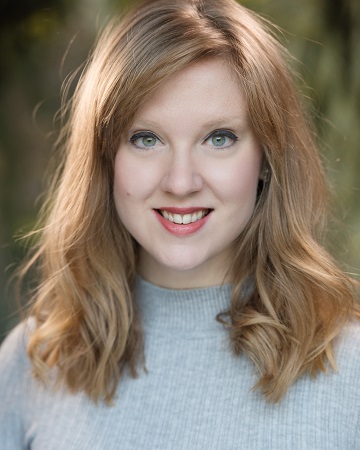 Emma Stannard.
Emma Stannard.
St John’s Smith Square, London: 16 December 3pm
St Mary’s Church, Bampton, Oxfordshire: 21 December 7.30pm
Semi-staged production, performed in Menotti’s 2-piano version
A raucous Così fan tutte at the Guildhall School of Music and Drama
Not intrinsically, anyway. These things can happen anywhere, at any time; these emotions, these physical and metaphysical truths are for many of us as close to universal as makes no matter. Nevertheless, the idea of a southern port city as a venue for touristic licence may well prove an apt setting for what is at dramatic stake. It helped Mozart and Da Ponte tread the fine line between realism and artifice that is surely fundamental to this, (one of) the very greatest of all operas; it also did to outstanding effect in Opera Holland Park’s new production this summer.
In a different way, or at least in a different southern port setting, so too does it in the Guildhall’s new staging. I only realised after the event - indeed upon starting to write this paragraph - that the director had been one and the same: Oliver Platt, albeit with a different design team. Perhaps, then, there was something after all to my hitherto innocent thesis of a common theme, notwithstanding the move forward a couple of centuries to the 19-80s to Alfonso’s Bar. Close to an American (West Coast? San Diego?) naval base, with all the potential for conflict between transience and long-term ‘home life’ that might imply, mood was superficially very different, likewise the consequences for particular directorial choices. Rarely, if ever, for instance, have I seen quite so raucous an opening scene, as the licentious ways of the naval boys (and at least one girl), their partners, and their would-be partners got under way, our quartet of lovers to be schooled taken from their number. That sense of a social context, however - a meaningful social context rather than a mere setting, ‘pretty’ or otherwise - remained common to both productions.
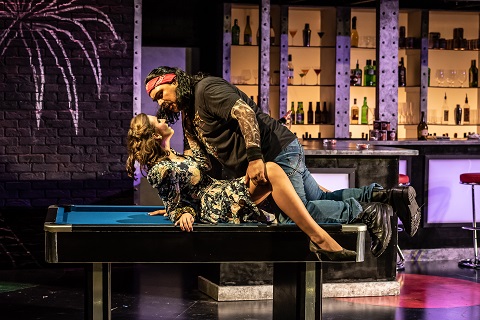 Carmen Artaza (Dorabella), Benson Wilson (Guglielmo). Photo credit: Clive Barda.
Carmen Artaza (Dorabella), Benson Wilson (Guglielmo). Photo credit: Clive Barda.
So too, again in different ways according to the different requirements of this particular production and performance, were the spatial, eminently musical visualisations of Mozart’s extraordinary and extraordinarily telling musical symmetries and oppositions. Così fan tutte is a labyrinth and a laboratory like no other, as worthy a successor to the experimental Bach of the cantatas as a precursor - a successor too - to Tristan und Isolde. Indeed, though Don Giovanni was the Mozart opera Pierre Boulez said he had long wished to conduct, yet never did; it is surely Così he should ultimately have come to, not least in light of his revelatory late recording of the Gran Partita, KV 361/370a. Whatever the ‘incidental’ detail of tequila shots, of entertainment in sombreros, of Despina the notary as Judge Judy, the fundamentals - related, not necessarily identical - were present both in Holland Park and at the Guildhall. So too was the existential devastation, the clear-eyed, merciless refusal to transcend, of the close.
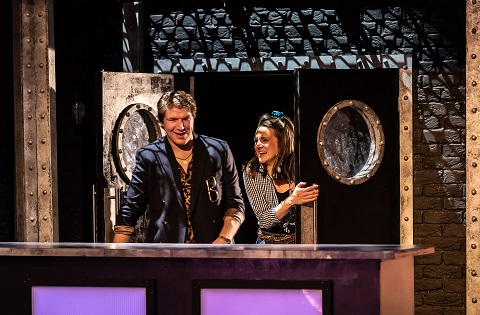 Christian Valle (Alfonso), Zoe Drummond (Despina). Photo credit: Clive Barda.
Christian Valle (Alfonso), Zoe Drummond (Despina). Photo credit: Clive Barda.
For that to be the case, of course, one needs musical drama too - indeed, musical drama above all. This one took a little while to get going: perhaps more a matter of opening night nerves than anything. The Silk Street Theatre acoustic did not help, I suspect, not least when married to a certain, rather surprising heaviness of hand - tending, in the Overture, even to the brutal - from Dominic Wheeler in the pit. Throughout the first act, some of his tempo choices were distinctly odd: not so much in themselves - as a listener, one should always be willing to adapt, to rethink in that respect - as in relation to one another. (Once again, doubtless idiosyncratically, I thought of Boulez and his admiration for Wagner’s Essay on Conducting, not least the claims for proportionality rather than ‘absolute’ tempo therein.) The second act worked much better, though, blessed by some gorgeous woodwind playing, even if the strings were a little too often thin of tone.
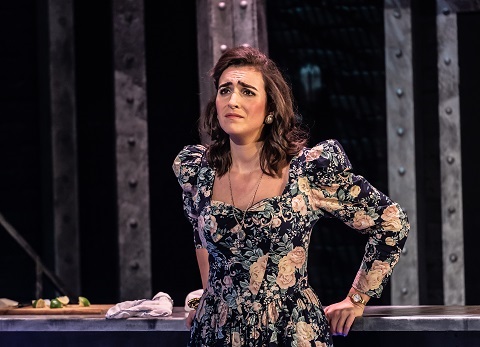 Carmen Artaza (Dorabella). Photo credit: Clive Barda.
Carmen Artaza (Dorabella). Photo credit: Clive Barda.
There was much both to enjoy and to admire in the singing - as there must be, if a performance and production are to have the slightest chance of working their dramatic effect. Carmen Artaza’s dignified, often exquisitely spun line, trickily married - that tightrope I mentioned above between realism and articificality - to sparky, well-defined personality proved a particular joy as Dorabella. So too did the patent sincerity of Filipe Manu’s Ferrando, his second-act aria truly moving, Benson Wilson’s Guglielmo a swaggering yet not insensitive contrast. Fiordiligi will always prove a great challenge: one to which Alexandra Lowe rose with considerable success in a performance finely differentiated from Artaza’s, her soprano coloratura meaningful as well as accurate. Christian Valle’s Don Alfonso ruled the roost as he must, Zoe Drummond’s excellent Despina intriguingly disillusioned at the close. Called upon to do far more in the way of acting and movement than would usually be the case, members of the chorus impressed too, individually and corporately. This, as the cliché has it, was considerably more than the sum of its parts. After all, if ever there were an opera to demonstrate both the truth and depth of what might first appear to be, and indeed what might actually, be buffo cliché, it is Così fan tutte.
Mark Berry
Wolfgang Amadeus Mozart, Così fan tutte, KV 588
Fiordiligi: Alexandra Lowe; Dorabella: Carmen Artaza; Despina: Zoe Drummond; Ferrando: Filipe Manu; Guglielmo: Benson Wilson; Don Alfonso: Christian Valle. Director: Oliver Platt; Designs: Neil Irish; Lighting: Rory Beaton; Movement: Caitlin Fretwell Walsh. Orchestra and Chorus of the Guildhall School of Music and Drama/Dominic Wheeler (conductor). Silk Street Theatre, Guildhall School of Music and Drama, London, Monday 5 November 2018.
image=http://www.operatoday.com/Benson%20Wilson%2C%20Filipe%20Manu%2C%20Christian%20Valle%2C%20Alexandra%20Lowe%2C%20Zoe%20Drummond%2C%20Carmen%20Artaza_%28c%29Clive%20Barda.jpg image_description= product=yes product_title=Così fan tutte: Guildhall School of Music and Drama product_by=A review by Mark Berry product_id= Above: Benson Wilson, Filipe Manu, Christian Valle, Alexandra Lowe, Zoe Drummond, Carmen Artaza
Photo credit: Clive Barda
November 6, 2018
For the Fallen: James Macmillan's All the Hills and Vales Along at Barbican Hall
There is nothing sentimental about Sorley’s own poetry which, like that of Wilfred Owen and Siegfried Sassoon, looks with sardonic objectivity upon themes such as duty and the glory of war, and does not shy from examining, with frank intensity and authenticity, violence and death in relation to private and public commemoration.
This concert at the Barbican Hall was one such public commemoration. James MacMillan’s oratorio, All the Hills and Vales Along, for solo tenor, chorus, brass band and orchestra was commissioned by the London Symphony Orchestra and 14-18 NOW. It sets five poems by Sorley who, aged just 20, was killed by a sniper at the Battle of Loos in 1915 (a smaller-scale version of the work, for string quintet and solo winds was presented at MacMillan’s Cumnock Tryst festival in Ayrshire last month).
The sight of the eighty or so members of the National Youth Brass Band of Great Britain crowding around the London Symphony Orchestra and beneath the London Symphony Chorus on the Barbican Hall stage was both tremendous and somewhat troubling. After all, many of these young musicians are little younger than Sorley himself and the millions of others who died in the conflict.
The opening moments of Macmillan’s setting of ‘All the hills and vales along’ exacerbated this unease. The pastoral intimations of the poem’s title are disregarded; landscape is an indifferent onlooker here. Macmillan begins with an eerie ‘noise’ that brings to mind Owen’s image in his poem ‘Exposure’, of the ‘air that shudders with black snow’ as the men wait, in terrible anticipation of the forthcoming battle: ‘Worried by silence, sentries whisper, curious, nervous,/ But nothing happens.’ The bows of the LSO strings seemed unmoving and no pulse gave life to the dry, grey huskiness which emanated, until the still, cupped hands of conductor Gianandrea Noseda opened and the brassy vigour of a march burst forth. The summons of the side drum and the measured thump of the bass drum inspired fortitude and focus, countered by crescendo-ing blares and rhythmic shifts which conjured both excitement and peril. (At the Cumnock performance, the ironic medley of marches and hymn-like melodies was played by the Dalmellington Band, founded in 1864, in which MacMillan’s coal-miner grandfather played euphonium.)
The unison entry of the male voices of the London Symphony Chorus were lifted aloft by the beating drum, their marching song robustly declaimed but lacking in hope: ‘And the singers are the chaps/ Who are going to die perhaps’. The full choral voices rang with a stirring hymn, ‘So sing with joyful breath’, though more honest spirituality was evoked by the quieter description, accompanied by vibraphone, of an ‘Earth that knows of death, not tears.’ The return of the title line, this time sung by the soft female voices evoked the distance between those who march away and those who remain, with only memories and echoes to comfort them: ‘Earth will echo still, when foot/ Lies numb and voice mute.’
There is no deceit or denial in Sorley’s poem, which urges the marching men onwards, ‘To the gates of death with song’, and which concludes with the cynically trite couplet, ‘Strew your gladness on earth’s bed./ So be merry, so be dead.’ Macmillan captures this unflinching honesty in his setting, and in the subsequent movement ‘Rook’, for tenor and orchestra which was sung by Ian Bostridge with soul-piercing focus. So often, in lieder recitals, Bostridge seems to ‘live’ the experience of the poetic protagonists; here, though his engagement and communication were no less emotive or affecting, he retained a certain detachment and poise - the experiences and lives described where not so much ‘lived’ as felt and communicated. The vocal challenges that Macmillan presents are considerable, and at the top and bottom of his range Bostridge did not always seem at ease but, characteristically, the tenor did not once shy from full commitment to the vocal embodiment of poetic meaning. The first word, ‘There, where the rusty iron lies’, was a shout of pained bewilderment, the sound ironically sweet and clean above tremulous string fluttering. The violas’ counter-melody seemed to push the questioning, wondering voice upwards - ‘Perhaps no man, until he dies,/ Will understand them, what they say’ - as Noseda summoned ever greater intensity, driving towards the climactic statement: ‘The world is half content.’ This declaration marked a change: gentle, soaring explorations by the strings, and the stuttering pianissimo triplets which whispered as the players lightly dropped their bows onto the strings, suggested a motionlessness which was complemented by the chiasmus of Bostridge yearning reflection on ‘the soul that flies/ From day to night, from night to day.’
These first two movements created a powerful and disturbing impact which I did not feel was wholly sustained in the subsequent parts of the oratorio. The thunderous bass drum roll that introduced Sorley’s sonnet, ‘When you see millions of the mouthless dead’, was succeeded by a chamber group of solo strings whose timbres and harmonies recalled the elegiac wistfulness of the music of those - Howells, Finzi, Ireland - who themselves experienced the conflict. However, Macmillan does inject growing energy, and uses dynamic contrast effectively as the Chorus relay the poet-speaker’s instructions to ‘Give them not praise … Nor tears … Nor honour.’: ‘Say only this. “They are dead.”’ And, the distorted muted ‘fanfares’ at the close were aptly disconcerting, for: ‘Great death has made all his for evermore.’
‘A hundred thousand million mites we go’ is quite cinematic in its initial bracing string rush, and brutal snap-pizzicato representation of the curses that ‘snap the air’. Both the rhythmic style and text-setting reminded me of Britten. (Echoes of the timeless observations of the Male and Female Chorus in The Rape of Lucretia seemed discernible in Macmillan’s settings of the lines, ‘And nations, ankle-deep in love or hate,/ Throw darts or kisses all the unwitting hour/ Beside the ominous unseen tide of fate:’.) Indeed, it was Bostridge’s characteristically discerning and intense delivery of the text which gave this movement its power. Elongated vowels were weighted, as the soldiers set off ‘Wheeling and tacking o’er the endless plain’, and later swayed ‘Writhing and tossing on the eternal plain’. As the vocal line sank, Bostridge’s tone became blanched, ‘Some black with death’; melodic ascents gained intensity, accompanied by the strings’ horrid scurrying. Consonants were viciously enunciated, ‘And some are mounted on swift steeds of thought’; a violently rolled ‘r’ infused the poem’s final question with agonised inconclusiveness: ‘Who brings us home again?’
In 1914, prior to taking up his place at Cambridge University, Sorley visited Germany, and when war broke out he found himself troubled by divided loyalties, which he made public in ‘To Germany’. This seemed to me the weakest of the movements, redolent not just with a Shostakovich-like bitterness - the angular unison string exclamations brought to mind the Fifth Symphony - but also with an Elgarian nostalgia, even nobilmente in the hymn for chorus and tenor which dominates the movement. Macmillan does return to the raspy whisper which began the oratorio, disturbing the dry murmur with blasts of brass and string tremolandos as Sorley describes ‘the storm,/The darkness and the thunder and the rain’ which will precede the coming of peace. But, I did not feel that Macmillan fully re-established the sardonic tone or emotional lucidity of Sorley’s poetry, which shows just how profoundly the young Scottish poet had grasped the truth about war - a truth he expressed with wariness and honesty.
There is much that is both sardonic and ‘heroic’ about Shostakovich’s Fourth Symphony, which requires the largest instrumental forces of any of the composer’s symphonies. It was begun in September 1935 and completed in May the following year, during which time the composer came under attack when Pravda accuses him of creating ‘Confusion instead of Music’ in Lady Macbeth of Mtsensk; Shostakovich withdrew the symphony in December 1936, while it was in rehearsal, and it was not heard until the Khrushchev era when, having been revised by the composer, it was premiered in Moscow on 30th December 1961. Moreover, the symphony represents the young Shostakovich’s ambitious endeavour to reconcile his developing musical language with traditional symphonic form.
This is music that requires immense intellectual and physical effort, and Noseda made these creative forces palpable in the Allegretto poco moderato, emphasising the quasi-mechanistic relentlessness of the profusion of material, and balancing the motoring rhythms with the espressivo violins and the bassoon’s wry but elegant solo reflections (bassoonist Rachel Gough played superbly throughout and thoroughly deserved the cheer of acclaim she received). The long movement never felt disjointed - unruly at times, perhaps, but Noseda suggested that he could tame the beast. This was a physical onslaught, even assault, but there was delicacy too, and the woodwind - especially the clarinet, bass clarinet and cor anglais - painted vivid colours. Noseda took risks, pushing the sound towards vulgarity at times, and launching the strings’ fugato at a crazily precipitous tempo - the terrific LSO fiddles raced like a runaway train but amazingly stayed firmly on the tracks. The more conventional form and lighter scoring of the short Moderato con moto ironically allowed the conductor to playfully tug at the rhythm and tempo and knock the regular occasionally out of kilter. And, Noseda did not try to hide the Mahlerian presence at the start of the Largo while the final Allegro accrued an unstoppable momentum into which Noseda integrated moments of lightly scornful parody.
Perhaps Shostakovich’s Fourth Symphony embodies a ‘battle’, or several battles, that cannot be won, its immensely imaginative but ultimately unreconcilable discourse never fully ‘conquered’. But, Noseda and the LSO communicated, almost viscerally, the truly heroic dimensions of that discourse.
The concert will be broadcast on BBC Radio 3 on Thursday 8 November at 7.30pm.
Claire Seymour
For the Fallen: Marking the First World War Centenary
James Macmillan: All the Hills and Vales Along (Commissioned by the London Symphony Orchestra and 14-18 NOW: WW1 Centenary Art Commissions, with the world premieres taking place at The Cumnock Tryst festival (chamber version) on 6 October 2018 and LSO (orchestral version) on 4 November 2018); Shostakovich: Symphony No.4 in C minor Op.43.
Ian Bostridge (tenor), Gianandrea Noseda (conductor), London Symphony Chorus (Simon Halsey, chorus director), National Youth Brass Band of Great Britain, London Symphony Orchestra.
Barbican Hall, London; Sunday 4th November 2018.
image=http://www.operatoday.com/charles-sorley.jpg image_description= product=yes product_title=For the Fallen: Marking the First World War Centenary, Ian Bostridge (tenor), Gianandrea Noseda (conductor) London Symphony Orchestra, London Symphony Chorus, National Youth Brass Band of Great Britain at Barbican Hall, London. product_by=A review by Claire Seymour product_id= Above: Charles Hamilton SorleyNovember 5, 2018
Kings College, Cambridge launches as curator on Apple Music
Founded in 1441 by King Henry VI, King’s College, Cambridge is part of one of the world’s leading universities. It is known internationally for its chapel, choir and its outstanding alumni in the classical world and further afield.
King’s College’s contribution to classical music is diverse. Although best known for choral and organ music, the College’s academic reputation in music is renowned. It also has links with many of the UK’s finest orchestras, and is responsible for educating some of the world’s top musical directors and conductors. King’s is the birthplace of the most famous internationally-performing close harmony group, the King’s Singers.
The College’s curated playlists will explore the history of the iconic English institution through music, offering playlists that delve into specific genres, selections of music perfectly suited to studying, and offerings to accompany major festivals throughout the liturgical year. All will be curated either by current students or notable alumni from across the music and academic worlds.
Exclusive highlights at launch include Christmas from King’s , which draws from the Choir’s new album100 Years of Nine Lessons & Carols, and an Introduction to Choral curated by leading British composer Bob Chilcott. The College’s curator channel will also be home to a specially-recorded ‘tourguide’ playlist about King’s itself, for the hundreds of thousands of tourists who visit the College each year, including those who attend the annual festival of Nine Lessons & Carols service on Christmas Eve. This playlist tour will combine spoken word with recordings, and culminates at the famous memorial stone to the Chinese poet Xu Zhimo, accompanied by a new setting of his iconic poem Second Farewell to Cambridge by the British composer John Rutter, released today as a single and music video and available only on Apple Music.
Stephen Cleobury, Director of Music at King’s, said, “King’s College has an immense history of creating, nurturing and studying music over many centuries, and I am delighted that King’s will be able to make a contribution to the musical experience of millions through its new curator role with Apple Music.”
King’s College, Cambridge will launch as an Apple Music curator on Friday 2 November, ahead of the forthcoming album celebrating 100 Years of Nine Lessons & Carols, which will be released on 9 November. Pre-add 100 Years of Nine Lessons & Carols now, and once it’s released the entire album will be available instantly in your Apple Music library.
Apple Music subscribers can find the College’s curator page by searching King’s College, Cambridge, or by visiting www.applemusic.com/kings .
John Rutter’s new setting of Xu Zhimo’s Second Farewell to Cambridge will be available exclusively on Apple Music as part of the launch, and available as a single and music video.
image=http://www.operatoday.com/Kings_Singers.png image_description=The King's Men [Photo courtesy of Kings College, Cambridge] product=yes product_title=Kings College, Cambridge launches as curator on Apple Music. product_by=Press release by King’s College Cambridge product_id=Above: The King's Men [Photo courtesy of Kings College, Cambridge]Royal Opera House’s Music Director Sir Antonio Pappano extends tenure to 2023
Pappano, who has been in position since 2002, will be the longest serving Music Director in the Royal Opera House’s history by the end of 2018/19.
Pappano has conducted an extensive and diverse repertory at the Royal Opera House, including the world premieres of Birtwistle’s The Minotaur (2008) and Turnage’s Anna Nicole (2011). He recently conducted the Orchestra of the Royal Opera House and the Royal Opera Chorus in Verdi’s Requiem in celebration of the fiftieth year of the Company’s Royal Charter, and has just concluded an acclaimed fourth full cycle of performances of Richard Wagner’s epic Der Ring des Nibelungen in Covent Garden.
He has received many awards, including in 2015 the Royal Philharmonic Society Gold Medal, and in 2016 was named one of the ten most successful Italians working in the UK by the PrimiDieci Society. In 2012 he was made Cavaliere di Gran Croce dell’Ordine al Merito della Repubblica Italiana and received a knighthood. He has received two Laurence Olivier Awards, one in 2003 for Outstanding Achievement in Opera and one in 2005 for the Best New Opera Production for Lady Macbeth of Mtsensk.
Antonio Pappano said:
“I am absolutely delighted to continue as Music Director of the Royal Opera House until at least 2022/23. This place feels like my home and I am so excited to continue my artistic journey here, conducting the repertory that Oliver Mears and I have developed together while continuing my collaboration with the finest Orchestra and Chorus in the world”.
During a sabbatical year in the 2020/21 season, Pappano will make appearances in venues across the world, including New York’s Metropolitan Opera, the Teatro Alla Scala in Milan and Staatsoper Berlin.
Alex Beard, Chief Executive of the Royal Opera House, said:
“I am thrilled that Tony has decided to stay until 2023. He has accomplished a huge amount in his sixteen years at the Royal Opera House, and we are very excited to have another five years at least in prospect. His remarkable artistic leadership is at the heart of what makes Covent Garden such a powerful creative force. The breadth of his repertoire is astonishing and his ability to get the very best from the world’s greatest directors and singers is unrivalled, as is his commitment to extending access as widely as possible to the artistic excellence that the Royal Opera House stands for.
Oliver Mears, Director of the Royal Opera, said:
“Tony's passionate and instinctual music-making, always informed as much by the drama as by the notes themselves, is the foundation of how we make opera at Covent Garden. It's an honour to work with Tony, and I can't wait to spend more time with him in the coming years as we strive to do full justice to the world's greatest operatic masterpieces.”
image=http://www.operatoday.com/Pappano%20%C2%A9%20ROH%2C%20Photographed%20by%20David%20Bebber.png image_description= product=yes product_title= product_by= product_id= Above: Sir Antonio PappanoPhoto credit: David Bebber
English Touring Opera: Troubled fidelities and faiths
Of course, the debates are complex and the contexts diverse and often starkly different. But, English Touring Opera’s production of Handel’s Radamisto, currently touring the UK and visiting cities from Durham in the north to Exeter in the south, seems to suggest otherwise. Director James Conway’s production does not update the action, does not consciously seek modern ‘relevance’, respects the score (though there are some judicious cuts, which ensure that the audience’s stamina is not over-taxed), and tells the story straight and true. In so doing, Conway, aided by an accomplished cast, makes the historical dramatically and emotionally immediate, and ‘real’.
Radamisto , which premiered at the King’s Theatre on 27 April 1720, was Handel’s first full-scale opera for the new Royal Academy of Music, and the latter’s second production. The anonymous libretto (sometimes accredited to Nicola Haym) was an adaptation of D. Lalli’s L’amour tirannico, o Zenobia (Venice, 1710), which itself drew on a byway of Roman history as related by Tacitus in his Annals of Imperial Rome.
Characteristically, this opera seria text throws spousal devotion, patriotic duty, tyrannical lust and tested loyalties into the dramatic bear-pit. It is the female characters - the abused and long-suffering Polissena, wife of the Armenian King Tiridate, and Zenobia, the wife of Tiridate’s brother-in-law, Radamisto, whom the narcissistic, infatuated Armenian hothead desires as much as he craves the Thracian Radamisto’s throne - who, as emblems of faithfulness and fortitude, lead us through cruelties and moral quagmires to resolution, reconciliation and reassurance. And, Conway, fittingly foregrounds this female duo, providing motivation and moral focus in the face of some of the libretto’s non sequiturs and nonsensical sequences.
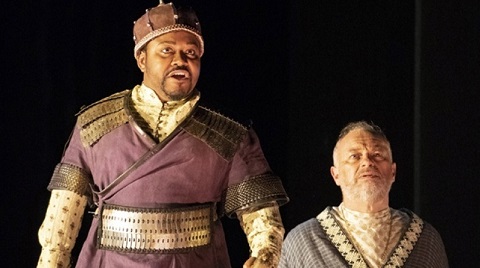 John-Colyn Gyeantey (Tigrane), Andrew Slater (Farasmane). Photo credit: Richard Hubert Smith.
John-Colyn Gyeantey (Tigrane), Andrew Slater (Farasmane). Photo credit: Richard Hubert Smith.
While Radamisto epitomises romantic loyalty and filial duty, the other male characters prove feckless, flimsy or, in the case of Farasmane, Radamisto’s deposed father, weakened by imprisonment and humiliation. The character of Fraate - Tiridate’s brother, who has also desired Zenobia and who originally facilitated some of the plot mechanisms and motivations - was, when the opera was revived in December 1720, revised by Handel and then subsequently eliminated, so Conway’s decision to excise this rather one-dimensional role seems sensible.
Designer Adam Wiltshire’s set is economical: starkly lit by Rory Beaton within a surrounding blackness - thereby isolating and sharpening the characters’ ethical dilemmas and defects - archways and porticos, ramparts and rockfaces, and some splendid costumes, provide visual definition of time, place and aesthetic. In the apparent absence of stage-hands, the characters themselves swivel and slide the large set-pieces: twice William Towers, immediately after delivering one of Radamisto’s stamina-taxing arias, had to find a bit more breath and strength to shift a heavy arch or wall.
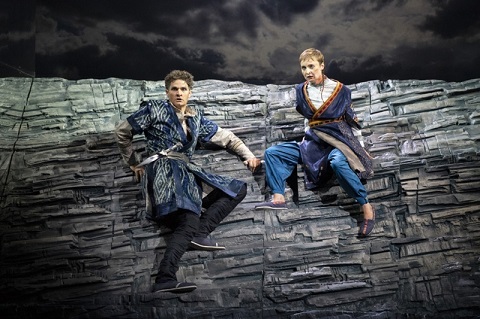 William Towers (Radamisto), Katie Bray (Zenobia). Photo credit: Richard Hubert Smith.
William Towers (Radamisto), Katie Bray (Zenobia). Photo credit: Richard Hubert Smith.
Beaton shines heightening white spotlights on characters as they plunge emotional depths in their arias, but also makes effective use of colour. Polissena’s bravura ‘Dopo l’orride procelle’, which ends Handel’s first of three acts, was set against a screened backdrop of a fateful sky which transmuted from grey-blue, through lilac and purple, to portentous red. In Act 2, a towering entrance opening, slashed into the prevailing black, glowed a fiery orange. And, there were a few scenic effects which surprised the audience in Snape Maltings Concert Hall: such as when the fleeing Radamisto and Zenobia seemed to climb into the back-telescreen, which proved to be not two- but three-dimensional, and scampered agilely up the precarious mountain face from which Zenobia would throw herself in suicidal despair.
The title role was originally designed for a low soprano and was sung by Margherita Durastanti, but for the December 1720 production Handel made significant changes to Radamisto to suit the new, largely Italian cast who had arrived in London that year, and the role of the Thracian prince was taken by the castrato Senesino. Durastanti was renowned for her wide emotional range, Senesino for the power and sweetness of his voice, and the refinement of his ornamentation. I found Towers’ Radamisto a little undefined dramatically at the start - ‘Perfido, di a quell'empio tiranno’, sung in response to Tiridate’s threats to destroy Farasmene’s city if he does not relinquish his throne, and Zenobia’s self-sacrificing submission to Tiridate, might have been more assertive and confident - but the countertenor ‘grew into’ the role. ‘Ombra fa’ was both technically assured and inspired our sympathy - all the more so as Towers had to deliver his show-piece perched upon a precipitous ledge. The duet between Radamisto and Zenobia which ends Act II was particularly affecting.
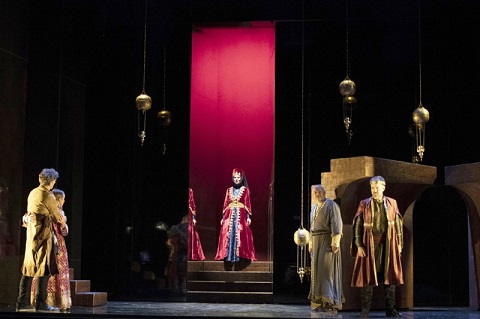 Ellie Laugharne (Polissena, centre). Photo credit: Richard Hubert Smith.
Ellie Laugharne (Polissena, centre). Photo credit: Richard Hubert Smith.
Ellie Laugharne endowed Polissene which dignity and presence, phrasing the plaintive ‘Sommi dei’ beautifully and singing with lovely expressive tone and shading. She sometimes seemed a little underpowered in the more rapid passagework and ‘Sposo ingrato’, in which the Queen challenges her abusive husband having previously saved him from her brother’s murderous wrath, was accurate but rather light.
John-Colyn Gyeantey performed the part of Tigrane, Tiridate’s conscience-stricken but gutless henchman, a role that was originally taken by soprano Caterina Galerati and which is still frequently sung by a soprano. Gyeantey’s characterisation was a little pale, but he made a fair attempt to convey Tigrane’s sincerity as he equivocated between his duties, passions and morals. The tenor was at his best in the slow passages which offered spaciousness to allow the beauty of his soft-grained tone to shine. As his Act 3 aria, ‘So ch’è vana la speranza’, showed, he can give poise to an emotional moment, but Gyeantey’s tenor lost definition and impact in the quicker passages and when the recitative was required to carry the drama forwards.
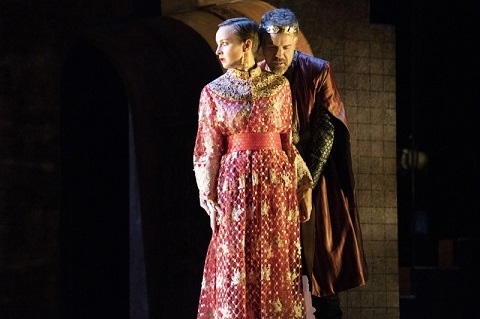 Katie Bray (Zenobia), Grant Doyle (Tiridate). Photo credit: Richard Hubert Smith.
Katie Bray (Zenobia), Grant Doyle (Tiridate). Photo credit: Richard Hubert Smith.
Baritone Grant Doyle blustered appropriately as the psychotically egotistical Tiridate, reminding us that there are far too many such hot-headed narcissists in positions of political power today - Conway describes the Armenian king as ‘perverted by his own unbridled will’ - but occasionally sounding a little too tonally coarse. Andrew Slater conveyed Farasmane’s dignity and moral stature as the deposed Thracian monarch was man-handled around the stage.
The production truly came alive, though, when mezzo-soprano Katie Bray gave vivid voice to Zenobia’s principled utterances and noble passions, her scything power and richly coloured nuance sharply etching Zenobia’s firmness of temperament and political presence. Bray displayed deeply considered expressivity, too, in ‘Quando mai’, singing with tenderness and pathos.
Radamisto is bound to leave the audience with several unanswerable questions. Why does Polissena continue to love Tiridate despite his vicious tyranny and heartlessness? Why does Tridate vacillate so spinelessly? Why does Zenobia throw herself off a mountain peak and then re-appear unscathed? Though Conway tells the tale straight he can’t overcome all of the libretto’s non sequiturs and nonsenses: the rapid climactic sequence at the end of Act 3 in which attempted rape is followed by thwarted double-murder, after which the apparently dead Radamisto revives himself, and which concludes with Tiridate’s personality-flip and a hastily constructed lieto fine raised a few chuckles in Snape Maltings, but that’s probably the fault of Handel’s libretto rather than directorial misjudgement.
Peter Whelan conducted the cast and the Old Street Band from the harpsichord, the latter improving as the proceedings progressed: after a slightly murky and dull overture, later we heard much more of the bright colouring of Handel’s score as flute, oboe and horns made sympathetic contributions to the drama. The continuo group was elegant led by Whelan and he was complemented by some gracious theorbo playing from Toby Carr and a lovely clear line from cellist Gavin Kibble. Whelan pushed the action swiftly but not precipitously forwards, and the overall result was visual, vocal and dramatic clarity and cohesiveness.
If only the relationships between the three parts of the triple bill which was presented the following evening had been so clear. When I spoke to Thomas Guthrie recently, prior to his production of Dido and Aeneas at the Barbican , he observed that one issue that must be addressed when staging Purcell’s opera is the question of which compositions to programme alongside the opera. Guthrie chose to present a ‘funeral for the late Queen of Carthage’ accompanied by other music by Purcell in the first half of the performance, so that the opera functioned as a flash-back, taking us ‘behind the scenes’. Conway and the other two directors presenting this triple bill have prefaced the Carthaginian Queen’s tragic demise with Giacomo Carissimi’s oratorio, Jonas, and I Will Not Speak ( Io tacerò) - a sequence of Carlo Gesualdo’s madrigals and Tenebrae responses, interspersed with readings of poetic and religious texts.
Seeking a link between these three items (beyond the general concerns with fate and faith that they might be thought to share), I turned to conductor Jonathan Peter Kenny’s programme article introducing Carissimi, but could find nothing to guide me other than the tentative hypothesis that, since Pepys had recorded his admiration for the Italian composer’s music in his diary in the late-seventeenth century, and the latter’s music had been copied into English manuscripts such as those preserved at Christ Church Oxford, then, as Purcell had made his own copies of works by Monteverdi and Cazzati, he ‘must surely have seen the examples of Carissimi’. Perhaps; but if so, with what effect, and to what end here?
Carissimi’s Jonas is one of the oratorio volgare (in Italian, as opposed to the oratorio latino, in Latin) that he composed for performance before the religious elite in the Santa Crocificio Oratory in Rome. Carissimi composed fifteen or so such works, labelling them historioe: that is, they presented narrative accounts of episodes drawn from the Bible - here, Jonah’s encounter with the whale - in which drama is created by the juxtaposition of varied musical forms - choral narration, madrigalian songs and duets, a solo lament, instrumental episodes - and language, homophony alternating with imitation.
 Jorge Navarro-Colorado (Jonas). Photo credit: Richard Hubert Smith.
Jorge Navarro-Colorado (Jonas). Photo credit: Richard Hubert Smith.
That master of the genre, George Frideric Handel, borrowed from Carissimi in some of his own oratorios. In recent times we have become used to seeing some of the latter staged, and here director Bernadette Iglich offered an attempt to impose visual and kinetic ‘theatre’ on music which has its own inherent drama. The eight performers, dressed in drab-coloured tunics and representing the ‘wicked’ community of Nineveh, moved with ritualistic solemnity around an unidentifiable column amid a blackness worthy of the leviathan’s belly, reflecting on faith and doubt.
The most obviously ‘dramatic’ incidents the biblical tale seem of little interest to Carissimi, though he does provide a colourful, explosive storm-scene which was vibrantly played by the Old Street Band. The composer’s focus is instead the doubts and equivocation of the protagonist. Jonah’s aria of supplication from inside the belly of the whale is the expressive climax, and it was beautifully sung by Jorge Navarro Colorado, the refrain, ‘Placare Domine’ (Subside your anger, Lord) powerful and moving.
Stirring singing during double-choir storm chorus was complemented elsewhere by the ensemble’s lovely, melodious blend and the text was carefully enunciated, especially in the closing chorus of repentance which follows the abrupt conversion of Ninevites - a fitting moral message for the departing congregation at the Oratorio del Santissimo Crocifisso to carry with them but perhaps, judging from the responses around me, not quite such apt fulfilment of the expectations of those in Snape Maltings Concert Hall.
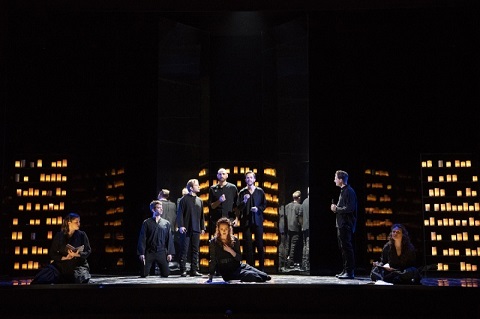 I Will Not Speak. Photo credit: Richard Hubert Smith.
I Will Not Speak. Photo credit: Richard Hubert Smith.
In I Will Not Speak, Conway sought to explore the interweaving and fusing of sensuality and spirituality, violence and virtue in the works of Gesualdo - a man renowned for the brutal murder of his adulterous wife, Maria D’Avalos. I’m not sure if one could say that the sequence was ‘staged’. Votive candles fluttered - a representation of the special candelabrum with fifteen candles which were distinguished one by one as each day’s service, commencing at nightfall, began, until only a single Paschal Candle remained; and also a metaphor for the quivering, fervent dialogue between faith and doubt. And, there was a slow ritual progress amid the flickering tiers of orange light, as the shadows multiplied and deepened until God plunged the world into darkness, the Crucifixion extinguishing the light of the world.
In any case, I cannot see any reason for adding dramatic action or movement to these works. There is enough melodrama within the madrigals, dominated as they are by a love which burns with the heated passion of a self-consuming destructive desire, and the Tenebrae Responses, which seek to bring human darkness and despair into balance with the hope of forgiveness and rebirth. Indeed, the music seems to express such interiorised agonies and ecstasies that all such external events are negated. Certainly, gestures such as a blowing of breath at the start of John Donne’s ‘The Expiration’ seemed somewhat trite. And, it seems all too perfunctory to make a direct link between Gesualdo’s tragic destiny and the torments of his musical voice, such as was intimated by the recitation of episodes of the composer’s life amid extracts from the Psalms, Igantius Loyala’s Spiritual Exercises, and The Spiritual Canticle of St John of the Cross.
Perhaps the chromatic distortions and intensities find their complement in the bitter, often self-lacerating arguments of the metaphysical texts of John Donne and George Herbert, but the conflicts expressed therein are those of a single voice, and the division of the poetic lines between different voices weakened this interior drama. The singers again performed assuredly, accompanied predominantly by strings, but the sweetness of the blended timbre denied the astringent dissonances their full power.
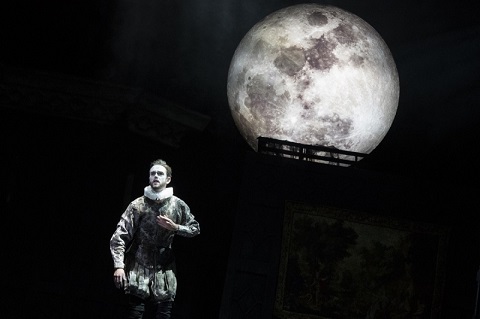 Nicholas Mogg (Aeneas). Photo credit: Richard Hubert Smith.
Nicholas Mogg (Aeneas). Photo credit: Richard Hubert Smith.
Seb Harcombe’s Dido and Aeneas promised to restore the musico-dramatic equilibrium. Designer Adam Wiltshire presented us with the crumbling ruins of a Tudor manor - a metaphor for ravaged Carthage, perhaps. But, even here there was ambivalence. Harcombe professed to have viewed the opera ‘from inside the heroine’s mind’ - I guess that explains why this Dido was staring into a hand-mirror at the start, and resumed this position before the tilting fire-place/portico at the close - and there was a disconcerting disjuncture between the realism of the Elizabethan costumes, all stiffly starched ruffs and cod-pieces, and the pseudo-psychodrama of much of the Gothic gestures and lighting.
There were a few doubtful moments: I’m not sure that witnessing Aeneas’s rather rough wooing and writhing with his new amour to the accompaniment of the theorbo’s elaborate, but not very erotic, ground bass repetitions, was a substitute for the imagined mysteries of The Cave. But, despite this the truly fine singing won the day. Susanna Fairburn’s terrifically vivid Belinda was a good counterfoil for Sky Ingram’s depressive Queen: the latter’s dull tunic and tortured visage brought to mind the heroines of the Brontës, and the rich timbre of Ingram’s lower range was evocative of the profound passions and neuroses of Jane Eyre and Cathy Earnshaw. Nicholas Mogg’s Aeneas was an oddly indifferent courtier and courter, egoism rather than empathy taking precedence as he entered with the flourish of a Walter Raleigh or the Earl of Essex, presenting the Queen with a model ship which honoured his own adventuring and achievements. Long, lank black locks made the sonorous announcement of Frederick Long’s Sorceress even more surprising and chilling than usual.
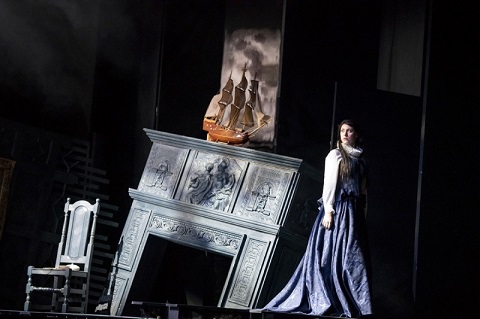 Sky Ingram (Dido). Photo credit: Richard Hubert Smith.
Sky Ingram (Dido). Photo credit: Richard Hubert Smith.
The small forces necessitated some compromises and excisions. The doubling up of Dido’s court and the coven of witches might have been thought to support Harcombe’s hypothesis that the events were conjured by Dido’s damaged psyche. But, the need for Dido to join the chorus, after Belinda’s ‘So fair the game, so rich the sport’, to help full out the sound, was less convincing. Moreover, the score’s joyful moments and carefree pastoralism seemed diluted.
During the final chorus, Dido rose and wandered, lost and unheeded through the ‘mourners’: perhaps the latter had already forgotten their Queen’s admonishment to ‘remember’? I’m not sure that this triple bill, beautifully sung but of dubious rationale and relevance - an encore, surely not necessary or appropriate after this most ‘perfect’ of operas, from Carissimi’s Jephtha seemed to return us to the staticism of earlier in the evening - will be one of my most vivid ETO memories.
But, Radamisto the night before had provided splendid enjoyment and fulfilment. And, I look forward to ETO’s spring tour, which presents three operas - Mozart’s Idomeneo, Rossini’s Elisabeth I, and Verdi’s Macbeth - in which still more Kings and Queens in battle for love, loyalty and power.
In the meantime, ETO’s autumn tour continues until 28th November.
Claire Seymour
Handel:
Radamisto
English Touring Opera: Radamisto - William Towers, Zenobia - Katie Bray,
Polissena - Ellie Laugharne, Tiridate - Doyle Grant, Tigrane - John-Colyn
Gyeantey, Farasmane - Andrew Slater; Director - James Conway, Conductor -
Peter Whelan, Designer - Adam Wiltshire, Lighting designer - Rory Beaton,
The Old Street Band.
Snape Maltings Concert Hall, Snape, Suffolk; Friday 2nd November
2018.
Purcell: Dido and Aeneas; Carissimi - Jonas; Gesualdo: I Will Not Speak Dido - Sky Ingram, Aeneas - Nicholas Mogg Belinda - Susanna Fairbairn, Sorceress - Frederick Long, Spirit - Benjamin Williamson, Second Woman - Alison Manifold, Sailor - Richard Dowling, Jonas -Jorge Navarro-Colorado; Director (Dido) Seb Harcombe, Director (Jonas) Bernadette Iglich, Director (I Will Not Speak) James Conway, Conductor - Jonathan Peter Kenny, Designer - Adam Wiltshire, Lighting Designer - Rory Beaton, The Old Street Band.
Snape Maltings Concert Hall, Snape, Suffolk; Saturday 3rd October 2018.
image=http://www.operatoday.com/Sky%20Ingrams%20Dido.jpg
image_description=
product=yes
product_title=English Touring Opera, autumn tour (Snape Maltings Concert Hall)
product_by=A review by Claire Seymour
product_id= Above: Sky Ingram (Dido)
Photo credit: Richard Hubert Smith
November 4, 2018
The real Traviata. The Song of Marie Duplessis
 Weis’s book constitutes the latest and most comprehensive outcome of the interest already surrounding the figure of Marie Duplessis for quite a number of years. As the title suggests, Marie (or, better, Alphonsine) embodies the rather rare case of a real-life character inspiring not only a major writer’s work, but also what the author himself considers “probably the best loved opera in the world” (p. 1). In the case of an operatic work that has almost completely displaced its literary sources, the interest towards the real “fallen woman” has already produced quite significant fruits, both in English and, most notably, in French.
Weis’s book constitutes the latest and most comprehensive outcome of the interest already surrounding the figure of Marie Duplessis for quite a number of years. As the title suggests, Marie (or, better, Alphonsine) embodies the rather rare case of a real-life character inspiring not only a major writer’s work, but also what the author himself considers “probably the best loved opera in the world” (p. 1). In the case of an operatic work that has almost completely displaced its literary sources, the interest towards the real “fallen woman” has already produced quite significant fruits, both in English and, most notably, in French.
November 1, 2018
Himmelsmusik: L'Arpeggiata bring north and south together at Wigmore Hall
Past performances at Wigmore Hall by L’Arpeggiata ( Mediterraneo with soprano Raquel Andueza, male soprano Vincenzo Capezzuto and dancer Anna Dego; La dama d’Aragó with soprano Núria Rial) have brought the spirit of folk music and the sultriness of jazz together with the formal sophistication of the Baroque, evoking the romance of the Mediterranean and the mystery of Catalonia, the infectious liveliness of dance and song setting the toes of the Wigmore Hall audience tapping. This concert, in which director/theorbist Christina Pluhar and her musicians were joined by Belgian soprano Céline Scheen, was a more sober, cerebral and spiritual affair, focusing on connections between the German and Italian traditions. Entitled Himmelsmusik (Heavenly music), the programme sought to illustrate the interplay between north and south during the Baroque, during a time when German traditions of counterpoint and chorale were both sustained and developed, as well as integrated with Italian innovations such as poly-choral antiphony and solo song.
One of the great joys of this concert was that we were introduced to several masters of the north-German Baroque, many of whom were prolific but whose music is infrequently heard. Johann Theile (1646-1724) was a student of Heinrich Schütz in Saxony and was esteemed among contrapuntists such as Dietrich Buxtehude. Theile was also one of the founding fathers of German opera, his 1678 Adam und Eva being the opening production at the Theater auf dem Gänsemarkt in Hamburg - the first German opera house. ‘Nun, ich singe, Gott, ich knie’ (Now I sing, God, I kneel), however, is far from theatrical: the voice, representing the Daughter of Zion (the work is titled Der Sionitin Wiegenlied) sings a humble lullaby - though the powerful vitality of the rich, dense organ (played by Haru Kitamika) in the instrumental opening served as a reminder of the significant role played by the organ, and organists, in municipal life.
Céline Scheen’s exquisite phrasing and carefully placed nuance perfectly captured the text’s spirit of tenderness and love, though elsewhere the purity of Scheen’s sound sometimes served the text less satisfactorily. Crato Bütner (1616-79, sometimes known as Büthner, Bytner or Buthnerus) was organist and Kapellmeister at the churches of first St Saviour and then St Catherine in Danzig. ‘Ich suchte des Nachts’, a setting of text from the Song of Solomon text, is a more sensuous expression of religious devotion than Thiele’s, the erotic inferences of lines such as the opening statement, ‘By night on my bed I sought him whom my soul loveth’, being conveyed by the vibrancy of the violins’ interplay (Simone Slattery, Catherine Aglibut). Scheen once again displayed a crystalline tone, and considerable vocal agility, but I’d have liked greater variety of colour to complement and bring to the fore the textual inflections.
Christian Ritter (c.1645-1717), an organist and composer based in Dresden, drew more directly on Italian sources in his Latin motet, ‘O amantissime sponse’ (O most loving spouse) which was an adaptation of a motet for two sopranos, two violins and continuo by Vicenzo Albrici. Here, the ensemble imbued the fairly short melodic lines and motifs which an impassioned energy which was further vivified by Ritter’s harmonic adventurousness.
Franz Tunder (1614-67) represents the preceding generation: he studied in Rome under Frescobaldi before returning home to take up the position of organist at the Marienkirche in Lübeck, where he would be succeeded by Dietrich Buxtehude, the latter going on to develop the Abendsmusik concerts given on Sunday evenings which Tunder had established - and for which ‘Ein kleines Kindlein’ may well have been composed. The sincerity and cleanness of Scheen’s vocal line communicated the depth of Tunder’s expression, her soprano borne aloft on bright instrumental colours, energised ensemble conversations, and a lightly tripping triple-time rhythm. There was similarly engaging instrumental playing ‘Ninna nanna al Bambin Giesù’ (Lullaby for Baby Jesus) by an unknown composer, where Pluhar created a strong sense of forward movement, driving on the winding inner lines.
We were on more familiar ground with two compositions by Heinrich Schütz (1585-1672). ‘Erbarm dich mein, O Herre Gott’, a solemn work for soprano, instrumental consort and continuo, probably dates from c.1613, after the composer’s visit to Venice. L’Arpeggiata captured the grand solemnity of this work: there is flamboyance in the instrumental gestures which suggest an Italianate influence, and some elaborate organ rhetoric, but the overall mood - significantly enhanced by the serene focus of the vocal line - was one of contrition. Scheen made a similarly strong contribution in ‘Von Gott will ich nicht lassen’ (I will not abandon God), which followed segue. This ‘sacred concerto’ comes from Schütz’s later collection, Symphonium sacrarum and is written ‘in our German mother tongue’, and again I found Scheen’s diction wanting occasionally, and the organ a little too present. But, at the close Scheen’s soprano took off in glorious full flight, “Ihm sei Lob, Her’ und Pres. Amen” (Praise, honour and glory to Him), confirming the appropriateness of the memorial which the mason engraved into the composer’s tomb: ‘musicus excellentissimus’.
Between the vocal items, instrumental a Chiaccona by Maurizio Cazzati (1616-78) and an anonymous Chiaconna à 4 offered an ensemble sound by turns glossy, bright, urbane and sombre, with striking use made of dynamic contrast and plentiful evidence offered of the players’ facility and judicious flamboyance. A contrast was provided by the mellifluous polyphonic linearity of the Sonata à 6 in E minor by the Verona-born Antonio Bertati (1605-69) who worked at the Imperial Court in Vienna as an instrumentalist, before becoming Kapellmeister in 1649. Like Bertati, Giovanni Kapsberger (c.1580-1651) was a native Italian: born in Venice he was an inhabitant of Rome as a young man. His Toccata L’Arpeggiata was performed with a vivid, improvisatory zest. And, there were ‘canonic’ items too: the first of Heinrich Biber’s Mystery Sonatas and the Prelude of J.S. Bach’s Second Cello Suite in which Josetxu Obregón balanced elegance with expressive rhetoric.
It was the Italians who had last word; and, showed how they led the field in blending secular song idioms with sacred texts and contexts. Native Roman Giovanni Felice Sances (c.1600-79) travelled to Vienna to take up employment at the court chapel of Emperor Ferdinand II in 1636, but his Stabat Mater exudes the idiomatic gestures of the Italian lament, and Scheen’s expressive elaborations over the descending ostinato bass were beguiling. Monteverdi’s ‘Laudate Dominum in sanctis eius’ (Praise the Lord in his sanctuary) ensured that, despite the gravity of much of the evening’s musical expression of devotion, it was with joyful verve that proceedings closed.
Pluhar heralds from Graz, the second largest city in Austria, and studied at her home town’s historic university. So, in some senses, this programme took her back to her roots, but the inventiveness and imagination of its delivery confirmed that she, and L’Arpeggiata, never cease pushing the boundaries of the Baroque.
L’Arpeggiata’s new disc, Himmelsmusik , was released this month on the Warner Classics Label.
Claire Seymour
L’Arpeggiata: Himmelsmusik
Christina Pluhar (director, theorbo), Céline Scheen (soprano)
Johann Theile - Der Sionitin Wiegenlied: ‘Nun, ich singe, Gott, ich knie’; Maurizio Cazzati - Chiaccona; Heinrich Schütz - ‘Erbarm dich mein, o Herre Gott’ SWV447, ‘Von Gott will ich nicht lassen’ SWV366; J.S Bach - Prelude from Cello Suite No. 2 in D minor BWV1008; Crato Bütner - ‘Ich suchte des Nachts in meinem Bette’; Anon - Chiaccona à 4 in C; Christian Ritter - ‘O amantissime sponse’; Antonio Bertali - Sonata à 6 in E minor; Franz Tunder - ‘Ein kleines Kindelein’; Heinrich Biber - ‘Mystery Sonata’ No.1 in D minor (‘Die Verkündigung’/The Annunciation); Anon - ‘Ninna nanna al Bambin Giesù’; Giovanni Kapsberger - Toccata L'Arpeggiata; Giovanni Felice Sances - Stabat mater; Claudio Monteverdi - ‘Laudate Dominum in sanctis eius’.
Wigmore Hall, London; Wednesday 31st October 2018.
image=http://www.operatoday.com/Scheen.jpg image_description= product=yes product_title=L’Arpeggiata (director, Christina Pluhar), Wigmore Hall, 31st October 2018 product_by=A review by Claire Seymour product_id= Above: Céline Scheen